Purcell, Handel and their Times
NederlandsThe text on this page is the fruit of lectures, contributions to
symposia, introductions to opera performances etc. which we have
presented at home and abroad during the past thirty years. As the
time allotted is almost always too short, we usually had to make a
selection from the available material.
The subject is broad. It spans a period of almost a hundred and fifty
years, touches on every kind of art and is strongly interrelated with
social and political factors.
The emphasis of a lecture might shift, depending on the nature of the assembly. We usually paid special attention to the works of Henry Purcell, sometimes those of George Frederic Handel, their operas in particular. We do not discuss the music in depth, we aren’t musicologists, but focus on all those other aspects of opera which make it a unique art form in which, if all is well, the arts work together to tell one gripping story.
Here, we aim to survey the entire period in more or less
chronological order, but will limit ourselves to the main features
and occasionally add a link to another page, where certain subjects
are discussed more fully.
Pages devoted to reconstructed scenes from Purcell’s semi-operas have
been available on our website since 2011. Additional articles will be
posted as the work progresses.
Since we started doing our research in the eighties, a number of scholars have done a huge amount of work in this field. We gratefully make use of (and of course acknowledge) what is relevant to our contributions. Extra thanks to Olive Baldwin and Thelma Wilson for critical reading.
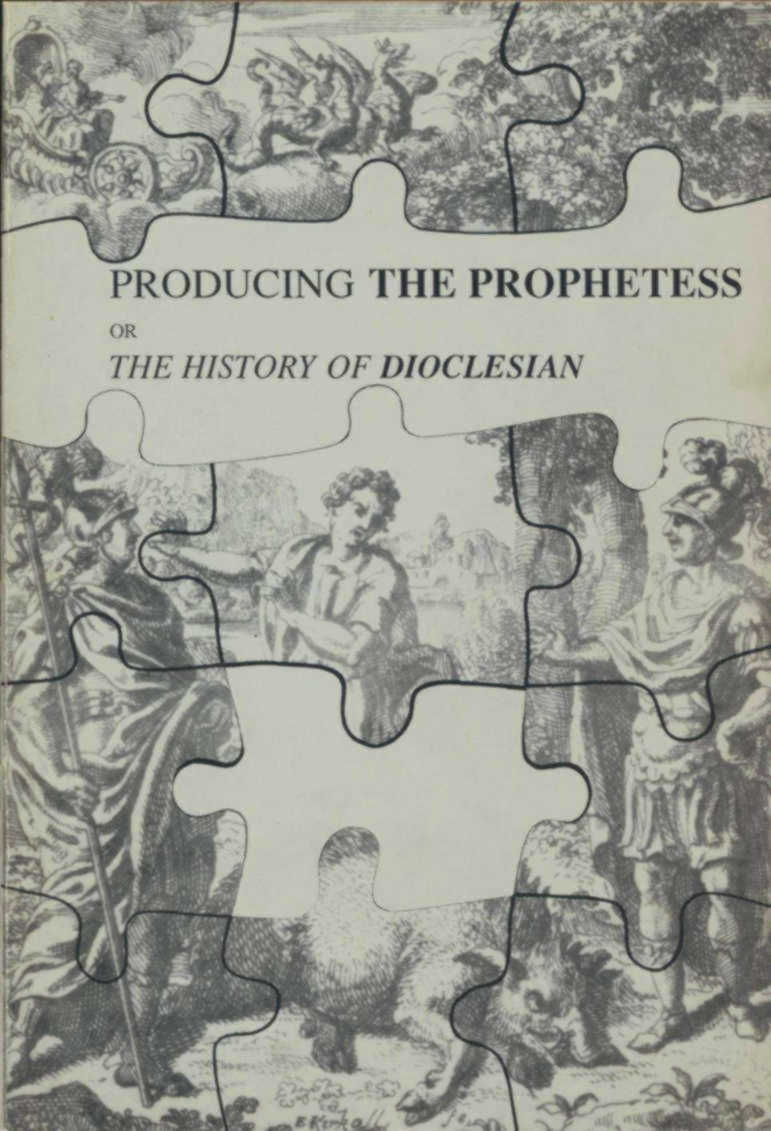
Vrije Universiteit Amsterdam, maart 1989.
The Beginning
Julie Muller was awarded her doctorate in 1989 for a
reconstruction of the process by which the early seventeenth-century
Fletcher and Massinger play The Prophetess, or: the History of
Dioclesian was transformed into a late seventeenth-century opera.
It all started accidentally, as these things are wont to do, when she
decided to write her PhD thesis on some textual aspects of Purcell’s
vocal music. For years she had been coaching Dutch and American
singers on meaning and pronunciation
of sixteenth and seventeenth- century English, encouraging people to
consult the OED for words in historical context, so as not to be
confused by lovely music set to texts like your awful face,
for instance.
Ton Koopman asked her to work on Purcell’s opera, The Prophetess, or: the History of Dioclesian, as nobody ever discussed it except to say that it didn’t cohere- a statement she eventually disproved to the satisfaction of the examining board.
However in the course of dissecting the text, which of course
includes stage directions, she found that she desperately needed to
know what the theatre and the stage looked like.
She found very
little and what she did find she showed to Frans, who is a hands-on
designer and a theatre lover like herself. He reconstructed the stage
on which Dioclesian was performed and a collaboration was born.
Why a Reconstruction?
So that eye and ear receive matching stimuli; to unravel the
visual code, which in turn clarifies the sense of text and music.
As early as 1698 the ‘bookseller’ Henry Playford wrote in the
foreword to his first collection of Purcell’s songs, Orpheus
Britannicus I that Purcell “was especially admir’d for the Vocal
having a peculiar Genius to express the Energy of English Words,
whereby he mov’d the Passions of all his Auditors.”
Obviously
this works best when the auditors are aware of the
significance of what they are hearing. A simple case in point:
Music for a While is extremely well-known and usually sung as
a paean to music. In order for this to be made clear, the basso
continuo, the bass accompaniment, has to be smoothed out. It should
of course be jagged and ominous, as befits the text to a rather
sinister song from the play Oedipus, (music for a while
shall all your cares beguile, going on to the goddess of
vengeance, her reptilian hair and death), but as many musicians
cannot be bothered to read closely and understand the text, let stand
the context, the poor song is often sweetened and unPurcelled, which
is a loss.
The Hunt for the Pieces of the Puzzle
Research into both seventeenth and eighteenth-century opera in
England - London, really - is always difficult due to lack of
pictorial evidence.
There is a relatively large amount available from the beginning of
the seventeenth century, thanks to the work of Inigo Jones
commissioned by James I and Charles I, much of which has been
preserved in the collection of the Duke of Devonshire at Chatsworth.
Subsequently it dwindled: the number of illustrations from Purcell’s
times can be counted on the fingers of one hand.
The theatre in England after the Restoration never became part of the royal propaganda machine it had been for Louis XIV, who personally commissioned engravings of performances. (King Charles did try, but see the chapter on Renewed Political Tension and a New Monarchy and our Dido and Aeneas page.) Still, it is astonishing that there is hardly any pictorial evidence from a period of about fifty years which saw a number of highly spectacular productions.1
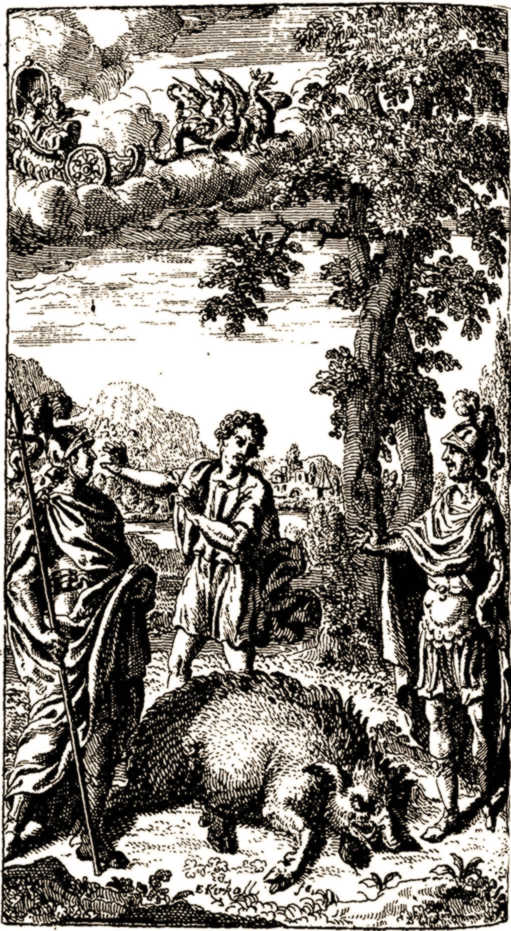
Beaumont and Fletcher, The Prophetess, play, frontispiece.
Londen, printed for J.Tonson, 1716.
Sometimes a picture exists, but is not recognised. The 1716
edition of the original Fletcher and Massinger play has an engraved
frontispiece showing details including a spear instead of a bow and
arrow, which shows that it is a scene from the opera, rather than the
play.
If one has hardly any pictures, how does one reconstruct an opera? We
have to find evidence elsewhere: in written sources like diaries,
letters, theatre inventories, financial records, newspaper
announcements, and above all: stage directions.
Comparing all the stage directions from the plays and operas put
on at Dorset Garden has clarified what kind of scenery and technical
equipment was available.
Interpreting stage directions requires caution: some SDs may have
been altered during construction and rehearsal, but when the Purcell
operas were first produced in the public theatre, the actor and
theatre manager Thomas Betterton had had some twenty years of
experience as the manager of the Dorset Garden theatre, so we take
his stage directions very seriously.
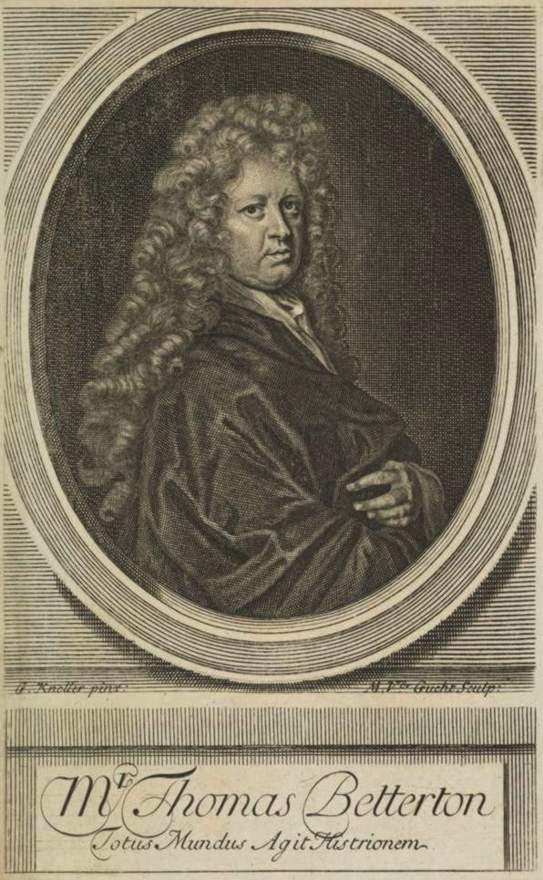
portrait of Thomas Betterton.
Scottish National Portrait Gallery, EP III 131.1
The Missing Pieces
We figured that the best approach would be to work out the staging
of the operas, looking at it from the librettist’s point of view,
scene by scene, and trying to imagine how seventeenth-century scene
painters and stage managers would carry out the instructions in the
stage directions. It is an approach that forces one to delve deeply
into the practical problems of baroque staging, more deeply than the
average musicologist or stage historian, who has other priorities.
Still there are always places where one must say: “we don’t really
know”. When all the available facts are on the table, there may still
be blank spots. Then, to achieve a coherent whole, one has to use
one’s knowledge of period stage technique and design, of stage
traditions, of social and political circumstances, and just plain
common sense and start to design what is lacking, always keeping in
mind that this is only a hypothesis. We carefully refrain from using
the qualification “authentic”; we prefer historically informed.
After his death, a sale catalogue was made of Betterton’s library,
which is in the British Library: the Pinacotheca
Bettertonæna.
Never having found any indication that Betterton could draw, we will
presume that he used the illustrations in his books and the prints
from his large collection to give his instructions to the scene
painters. Thus his books and prints are of prime importance.
A Different Approach
Even so, we have to face the fact that the number of primary sources is very limited. We think, however, that valuable information lies hidden in material already known to us. To be perceived, it must be viewed in a different manner: not separated into the different art forms but, on the contrary, as interaction between all the arts involved when mounting an opera. Therefore teamwork is necessary in early opera research: not just social and political historians, musicologists and experts on stage history and stagecraft, but on early dance conventions, on gesture and facial expression on stage, on costume, language and even on early European pyrotechnology.2
From Model to Video Animation
The results of our initial research into the performances of
Dioclesian were incorporated into a model of the stage of the
Dorset Garden theatre, where the first production took place. That
enabled us to experiment with different variants of the scenery.
We initially concentrated on the finale of Dioclesian, the
scene most precisely described in the word-book.3 A photograph of this model later served as the
background to the scenery built in the computer and when computers
had become powerful enough, motion was added.
At the request of Dr. Michael Burden, we reconstructed the final
scene of The Fairy Queen (1692), “the Chinese garden”, for a
conference on mutual cultural influence between Asia and Europe
called Encounters in November 2004 at the Victoria and Albert
Museum in London.4
While working on the reconstruction and its accompanying animation,
we saw all kinds of details fall into place and it became even
clearer just how carefully all the elements of this masque,5 which musicologists had usually dismissed
as a jumble of nonsense, had been assembled.
That made us decide to re-examine our own conclusions about the
finale of Dioclesian and to make a more detailed
reconstruction and an animation.
It was eventually to be followed by the final masque in King
Arthur (1691), to complete the trio produced at the Queen’s
Theatre Dorset Garden in the early nineties, which Judith Milhous has
so tellingly called “multimedia spectaculars”.6
Theatre and Politics in London;
the Seventeenth Century
During the baroque, it was mainly the nobility and the church
which commissioned artistic endeavours. Painters and writers,
musicians, actors and dancers were all dependent on them.
Opera was entertainment for the courtiers and it displayed wealth,
but could also convey a political message and was therefore
pre-eminently a matter for the court, particularly in the early
days.
Depending on the situation, the church might be either a supporting
or a restraining factor, as witness the role of Mazarin in France and
of Cromwell in England. Even after the rise of the public theatre,
court and church remained important.
The masque was an entertainment already known to European courts,
including the English court, in the sixteenth century. Originally a
group of costumed and masked personages, often accompanied by torch
bearers, they danced and conversed with the guests during social
events. Their appearance might be in a simple parade, but could also
be part of an allegorical sketch in honour of the host or hostess. At
the sixteenth-century Medici court in Florence, the genre was
developed into Intermezzi: bits of musical theatre between the
acts of a play, without any relationship to that play; richly
costumed and having moveable and changeable scenery and “machines”.7
At first, the subjects were derived mainly from Greek mythology.
Opera per musica, later shortened to opera, evolved
from there.
The Court Theatre
The English architect Inigo Jones observed the new phenomenon opera and its changeable scenery while on his travels to Italy. He made use of them early in the seventeenth century for the masques at the courts of James I and his son Charles I.8 The masques were performed on temporary stages set up in palace halls. The stages were simple and meant to be easily erected and dismantled, but always had the facilities for changeable scenery, a technique which was to be perfected for the public theatres in later years.
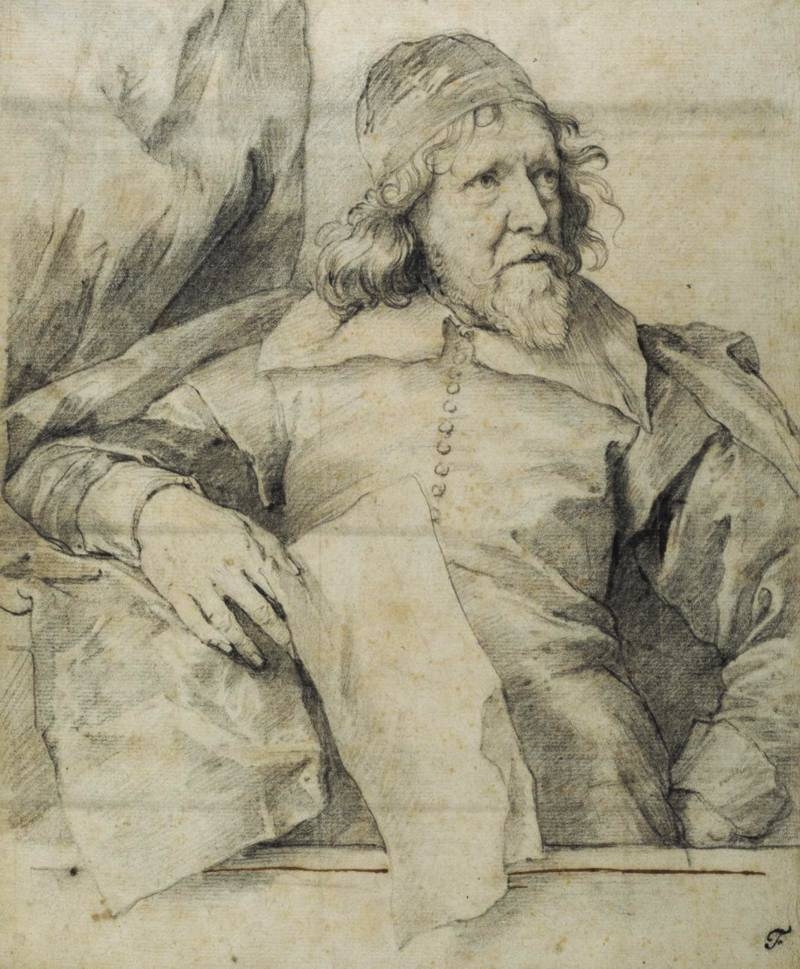
portrait of Inigo Jones.
Chatsworth, Devonshire Collection.
The masques gave the royal family and the courtiers the opportunity to play heroic parts in splendid costumes and were in that sense amateur theatricals, but were otherwise professional productions. These were not operas and they were never performed outside the palace. Later in the seventeenth century we find masques again, but then in the sense of an independent piece of fairly short, through-composed music theatre, with songs and dances.
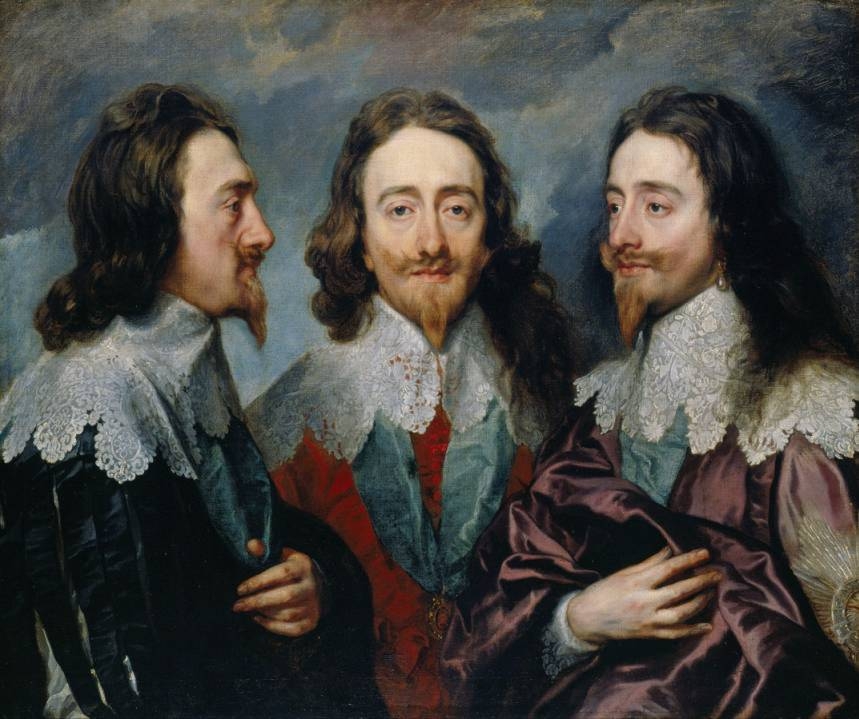
portrait of Charles I.
Windsor, Royal Collection, RCIN 404420
Charles I, who came to the throne in 1625, was married to the
Catholic Bourbon princess Henrietta Maria, a sister of Louis XIII.
They had a large number of children, including Charles, James and
Mary, who married the Dutch Stadholder Willem II.
As the monarch, Charles I also governed the Church of England, but
during his lifetime he inclined more and more towards Roman
Catholicism and towards absolute monarchy as well. He was the last
English king to rule by what he believed was the Divine Right of
Kings. There were many grievances against him, among which was
his extravagant expenditure on his court theatre. But it was his
efforts to curb Parliament that led to his death.
The Puritans
Early in the forties, the conflict turned into a full-scale civil
war, won by Parliament and the army led by the Puritan Oliver
Cromwell. When in 1646 it became clear that Cromwell was winning, the
king’s sons, sixteen-year-old Charles and his younger brother James,
fled to the court of Louis XIV of France, where their mother
Henrietta Maria had already sought refuge.
King Charles was beheaded on a scaffold in front of the Banqueting
House, where the court masques had been performed during his reign; a
symbolic place.

portrait of Oliver Cromwell (1599-1658).
London, National Portrait Gallery, D28712
The boys discovered opera at the music-filled court of their cousin Louis. At that time, opera in France was evolving, but still under strong Italian influence.
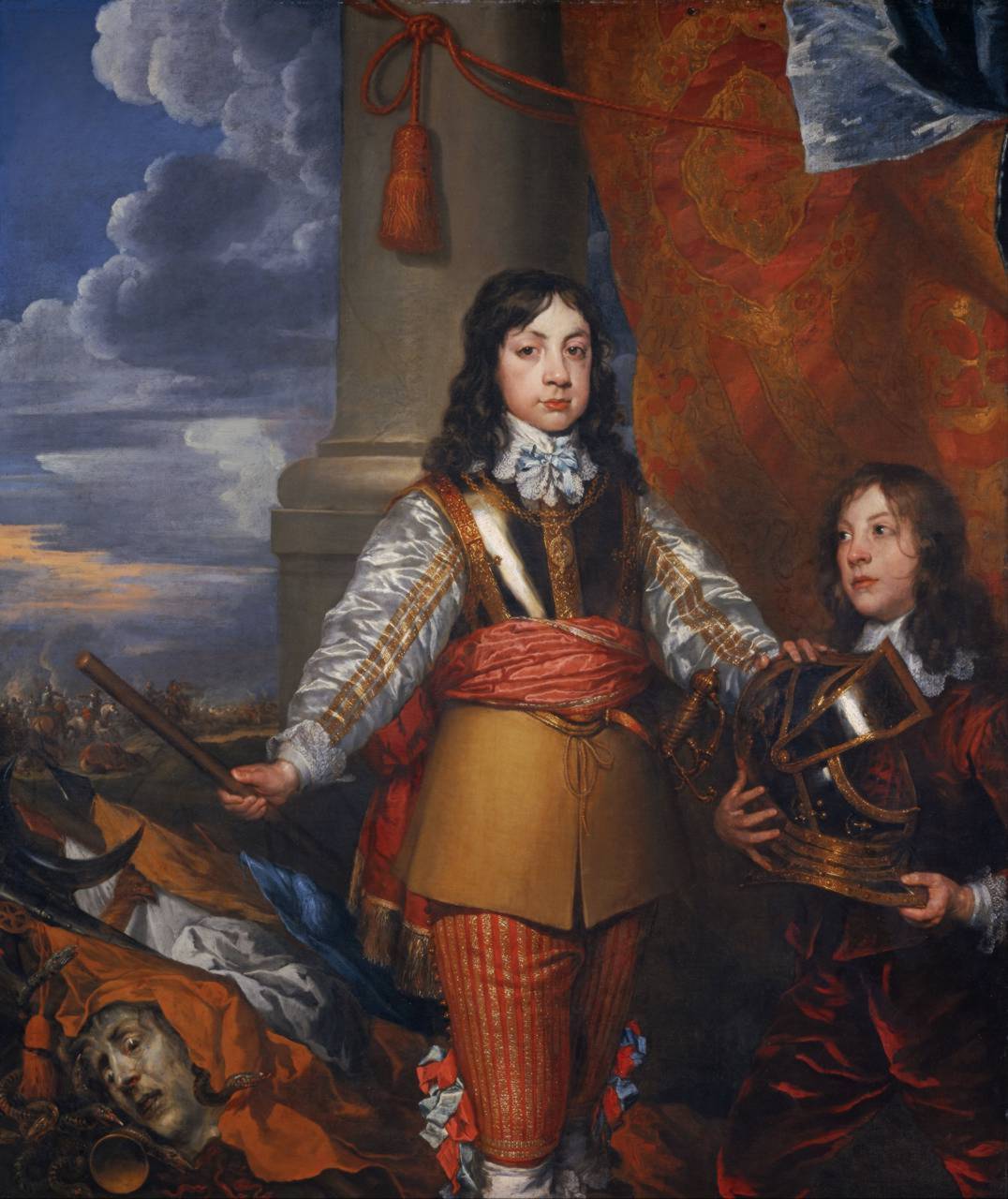
portrait of Charles, Prince of Wales, later Charles II.
Scottish National Portrait Gallery, PG1244
England was a republic from 1647 to 1660: The Commonwealth. During this period under the leadership of Cromwell, the public theatres were closed and instrumental music was forbidden in church. Court musicians like Henry Purcell’s father and uncle earned their living teaching music, which was allowed. Even Cromwell’s daughters were given music lessons by John Blow, among others.
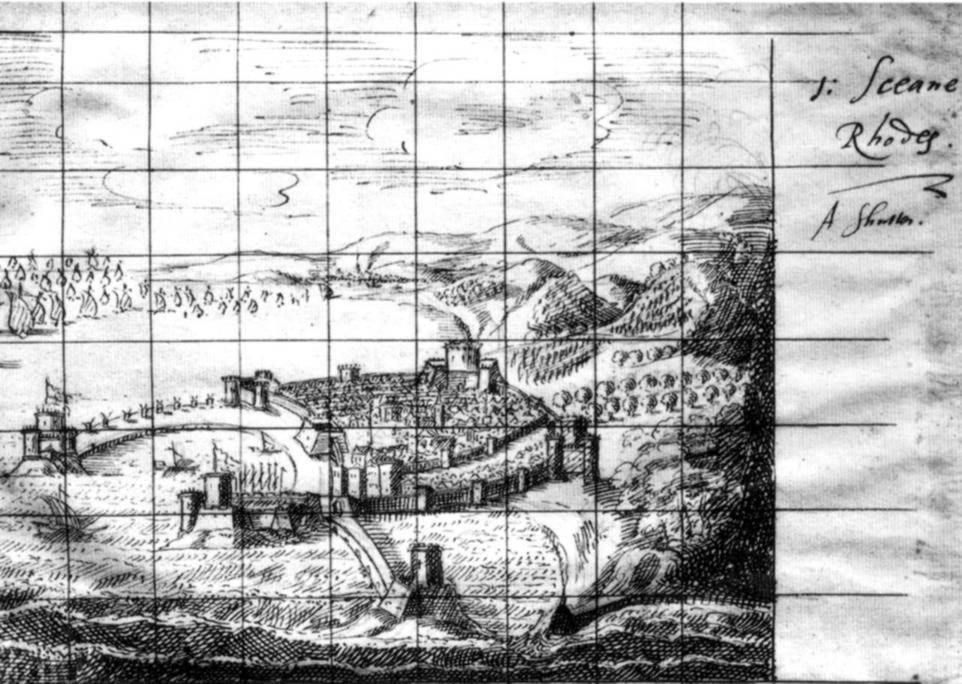
design for the first scene of The Siege of Rhodes.
Chatsworth, Devonshire collection.
There was music in the houses of prosperous citizens. It was an important element in the education of boys and particularly girls of good family. The nobility even put on plays with or without music, preferably about a serious historical event; for example The Siege of Rhodes and The Cruelty of the Spaniards in Peru, both performed in London in 1658-59 under the direction of William Davenant. There were lighter performances as well, such as Shirley’s masque Cupid and Death, with music by Christopher Gibbons and Matthew Locke, in 1653.
The Restoration: a New Start
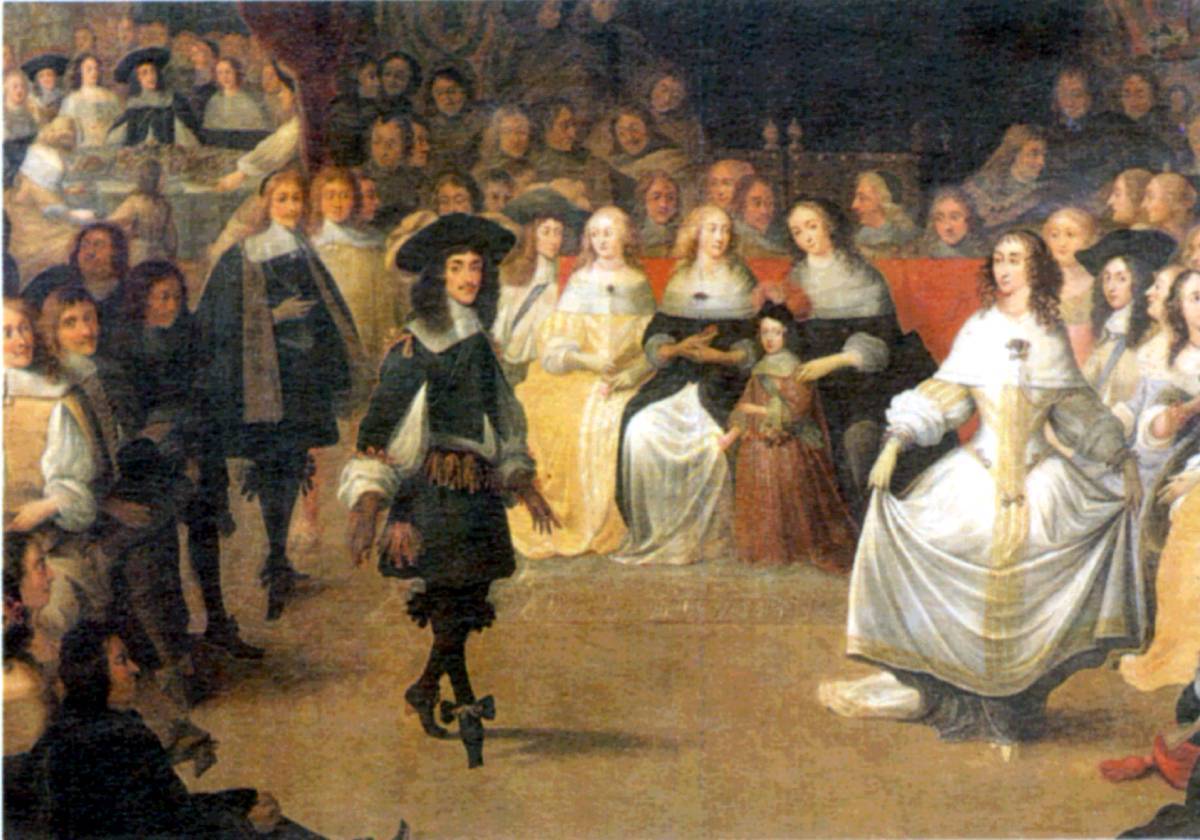
Charles, James, Mary and the young William (later King William III) during a court ball in The Hague, on the eve of Charles’ return to England in 1660.
Windsor, Royal Collection Trust RCIN 400525
Things ended badly for Charles I and his traumatised sons went to work more circumspectly after the Restoration when Charles II became King of England. During his reign the arts and sciences flourished. Charles and his brother James, now Duke of York, both wanted to promote the kind of music theatre they remembered from the court masques at Whitehall, but had seen greatly enhanced and perfected in France.
Aside from arranging for performances in his court theatre in Whitehall Palace,9 soon after his return Charles gave two courtiers each a hereditary patent to establish a theatre company in London and Westminster, build a theatre and give performances for a paying public: Thomas Killigrew and Sir William Davenant. No other theatre companies were allowed there. The hereditary patents were to play an important part in the power struggles between the government and the theatre directors for many years.
Link to Patents pageThe courtiers Thomas Killigrew and Sir William Davenant formed the
King’s Company and the Duke’s Company respectively. These companies
initially performed in converted real tennis courts, as was the case
in France.
The core of each group consisted in actors already performing before
the civil war, but in the intervening twenty years a new generation
had been added, both on stage and among the audience. Another novelty
was that women were now permitted to act in public theatres, as they
were on the continent. Men were no longer allowed to play women’s
parts, which had formerly been the norm, but the prohibition was not
enforced very stringently at first.
The converted tennis courts in which the two London public theatre
companies first performed, already had perspective scenery and stage
machines.
The very first performance, at the end of June 1661 in Lincoln’s Inn
Fields, of The Siege of Rhodes, already had “new scenes and
Decorations, being the first that e’er were introduced into England”.
10 The text, which had been in sung
recitative during the Commonwealth, was now spoken.11
New Theatres
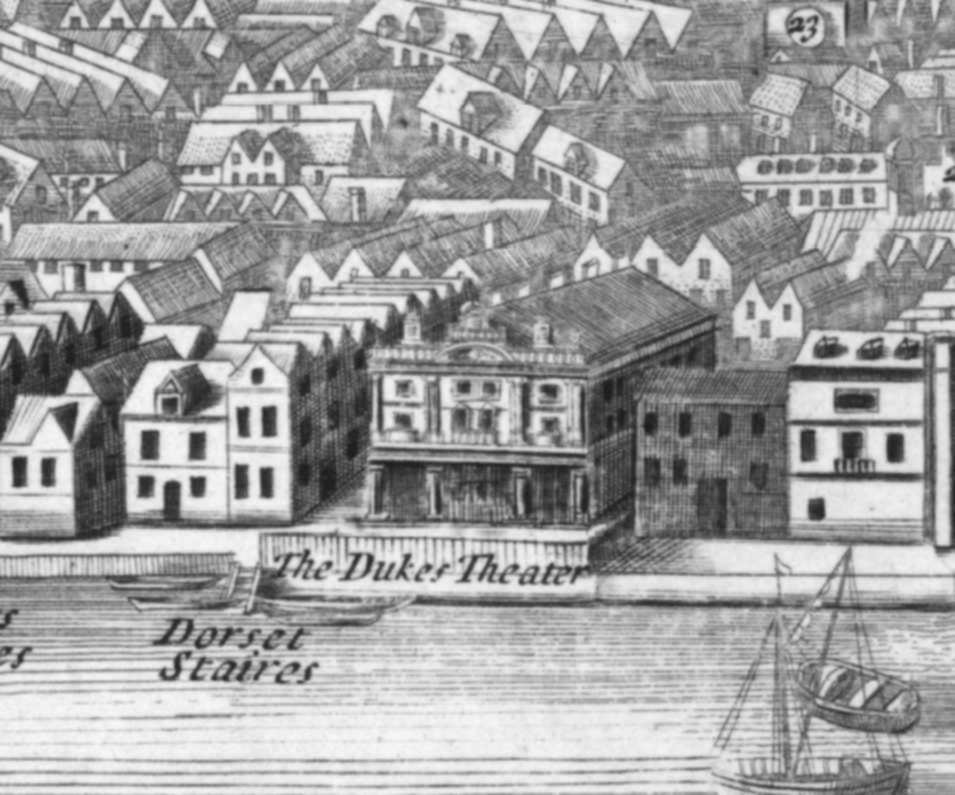
the Duke’s Theatre in Dorset Garden.
London, British Museum, Map library, Crace collection II,82
Thomas Killigrew was the first to have a theatre built specifically to utilise the new techniques. That was the Theatre Royal in Bridges Street, off Covent Garden. It opened on May 7th 1663.
Sir William Davenant’s Duke’s Company began at Lisle’s tennis
court in Lincoln’s Inn Fields. Davenant died in 1668. His eldest son
Charles was still a minor and his widow managed his estate.
It was not until after his death that the company really began to
build a new theatre.12 It arose in
Dorset Garden, on the Thames. Six years after the plague epidemic and
five after the fire of London, the theatre opened on November 9th
1671 with Dryden’s play Sir Martin Mar-all. The kind of
productions for which the Duke’s Theatre was custom-built, were not
yet being staged. It wasn’t until the first opera adaptation of
The Tempest in 1674 that the theatre’s many facilities were
utilised.13
After Davenant’s death, the very talented young actor Thomas Betterton had taken over the management of The Duke’s Company, together with his colleague Henry Harris. Both had previously worked under Davenant.
French Influence and National Traditions
King Charles sent both Betterton and Killigrew to Paris, in order
to have them study the French theatre the king admired so much. He
wished them to become familiar with the new way of staging.
Betterton went to Paris - probably for the first time - in 1662 and
we may assume that during that visit he saw Cavalli’s Ercole
Amante in the salle des machines. That was a large theatre, built
in the palais des Tuileries. It was equipped with an enormously deep
stage and a great deal of machinery for scene changing and special
effects.
In 1671, while the Dorset Garden theatre was being built, Betterton went to Paris again. As is to be expected and as is confirmed by comparing stage directions, many of the technical facilities seen in Paris and Versailles were also to be found in the new theatre.
Meanwhile, the King’s Company’s theatre had been destroyed by fire and in 1674 they too moved into a new building, on the site of the old one between Bridges Street and Drury Lane. The entrance was now situated on the other side, in Drury Lane, and the theatre was henceforth known as the Theatre Royal, Drury Lane. That theatre too was provided with machines and changeable perspective scenery, after the French examples.
Next to the French influence, there were also strong national traditions, some going back to Elizabethan times. London theatre became a hybrid, deviating from what was customary on the continent: it had a proscenium stage with a large apron which had doors on either side. Most of the action took place in front of the perspective scenery, rather than within it.
We then to flying Witches did advance,
Epilogue to the Dryden-Davenant-Shadwell Tempest
And for your pleasures traffic’d into ffrance.
From thence new Arts to please you, we have sought,
We have Machines to some perfection brought,
And above 30 Warbling Voyces gott.
Antagonists
The two theatre companies were in competition, as can be seen from the texts of their prologues and epilogues, mocking one another (a rich source of information for later researchers).14 Ridicule was another weapon. The 1674 Tempest in Dorset Garden, with a word-book by Shadwell and others and music by i.a. Locke, was parodied in November of that year at Drury Lane in Duffett’s The Mock-Tempest: or The Enchanted Castle and after Psyche, an opera by Shadwell and Locke, was performed in March 1675 at Dorset Garden, Drury Lane responded in August with Psyche Debauch’d again by Thomas Duffett.
The King’s Company, which had never been as well organised as the Duke’s, was badly hit by the destruction of their Bridges Street theatre and the loss was compounded by bad management, conflicts and declining audiences; the financial problems becoming worse and worse. After months of negotiations, the two public theatre companies merged into the United Company,15 under the direction of Thomas Betterton in 1682. The Theatre Royal was then chiefly reserved for plays and the Duke’s Theatre in Dorset Garden for opera.
Renewed Political Tension
and a New Monarchy
During an interlude of peace in Western Europe in 1683, Charles II, a great admirer of Lully, sent Thomas Betterton to France once more, with instructions to bring a French opera back to London, to be performed at Whitehall Palace and if possible to bring Lully himself as well. That almost worked,16 but instead, the composer Louis Grabu came to England.17

portrait of John Dryden.
London, National Portrait Gallery, NPG 2083
In 1685 Albion and Albanius, an all-sung opera in English,
was performed at Dorset Garden;18 the
word-book was by John Dryden, the music by Grabu. It was meant to
glorify Charles II and his brother James and according to Dryden it
was intended to be the prologue to his as yet unwritten play King
Arthur. He had clearly been inspired by the Lully and Quinault
tragédies lyrique, which had prologues of that kind.
The king had
already been to several rehearsals, but died suddenly in February,
just before the premiere. When the opera was finally performed, after
the period of mourning, there was great political unrest in the
country and after only six performances, the curtain fell for good on
Albion and Albanius. Its failure was attributed to this unrest
on the grounds of the prompter Downes’ memoirs,19 among others, but the glorification of Charles’
brother James was highly controversial at that time, by reason of his
religion and although Dryden was full of praise for Grabu’s music, it
was also seriously criticised:
Betterton, Betterton, thy Decorations,
And the Machines were well written, we knew;
But all the Words were such stuff we want Patience,
And little better is Monsieur Grabeu.20
Anti-French sentiment may have played a part here, but Grabu himself was also critical, particularly of the quality of the singers.21 In any case, it was a blow to the United Company, which had invested heavily in costumes, scenery and machines.
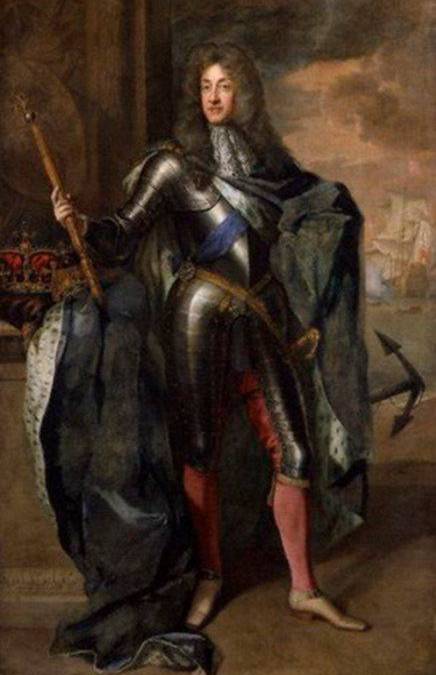
James, Duke of York, (later James II of Engeland).
London, National Portrait Gallery, NPG 666
The cause of the unrest was the succession of Charles II by his
brother James. The latter made no bones about his Catholic faith. His
second wife, Mary of Modena, was also a Catholic. The atmosphere in
England was still very anti-Catholic as a result of Henry VIII’s
struggle against the Pope, but mainly because Catholics were
perceived as being loyal to a foreign ruler, rather than to England.
It isn’t hard to find parallels with the present.
After James II had succeeded to the throne, tension rose and when an
heir apparent was born, all hell broke loose. James was eventually
driven out.
Within two months after the final performance of Albion and Albanius Betterton was again on his way to France and the next year a French company presented Lully’s Cadmus et Hermione at the Dorset Garden theater. The United Company was not due to produce a new opera in the near future, but that was not unusual. In those days, an opera was still a major event.

It was five years before Betterton’s company ventured to mount
another opera and by then the political situation had changed
drastically as a result of the Glorious Revolution. James’ daughter
by his first (Protestant) wife and her husband,the Dutch (Protestant)
Stadholder Willem III, now reigned jointly as William & Mary.
Queen Mary 22 showed more interest in
the performing arts than her husband,23 although he is eulogised in the prologue to Peter
Motteux and John Eccles’ Europe’s Revels for the Peace of
Ryswick (1697) 24 written after
her death. After they had come to the throne in 1689, however, royal
patronage and support for the stage were no longer self-evident.
Enter: Henry Purcell
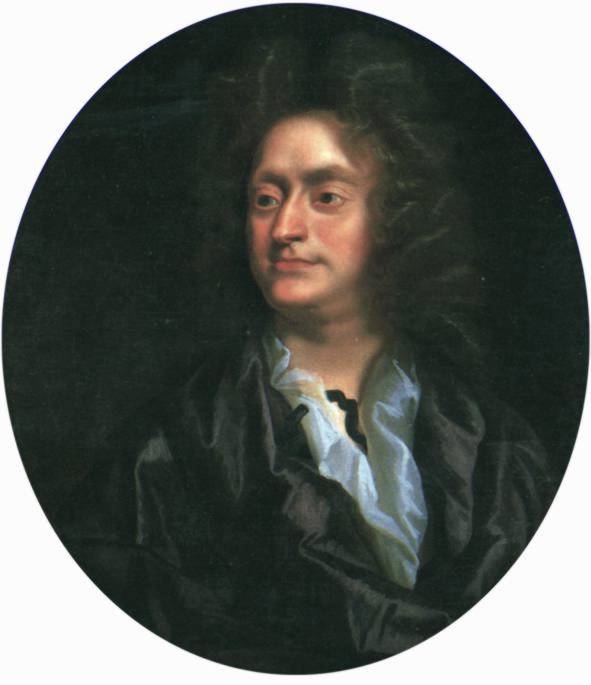
portrait of Henry Purcell.
London, National Portrait Gallery, NPG 1352
Henry Purcell was probably born in 1659 in Westminster, just west of what was then London, close to the Abbey. His parents were Henry and Elizabeth Purcell, his uncle Thomas Purcell acting as a father to the young Henry after his brother’s early death. Although the composer’s record of birth remains to be found, his godfather John Hing(e)ston, to whom he was later apprenticed, identified him as Elizabeth’s son in his will 25 and left him five pounds.
The troubled times during which the composer was born were to have
a great influence on his life.
Under the leadership of Oliver Cromwell, the public theatres had been
closed and church music forbidden. Former court musicians, like the
Purcell brothers, were only able to earn their livelihood by
teaching. The Purcells had been court musicians during the reign of
Charles I and at the Restoration of the Monarchy in 1660, both became
members of the Chapel Royal. Shortly after his father’s death little
Henry, then about five, became a choirboy.
The Children of the Chapel Royal were given an excellent musical education. The Master of the Boys was Captain Henry Cooke, who had performed in The Siege of Rhodes and written some of the music. From the very beginning, therefore, Purcell was entrusted to the care of those who practiced both sacred and secular music. That was very useful, as court musicians were financially dependent on the monarch. In England that included church music, as the monarch was and is the head of the Anglican church.
The Chapel Royal later came under the direction of Pelham Humphrey, to whom Purcell owed a great deal. He was regarded as Humphrey’s musical heir. He was taught the organ by Christopher Gibbons, son of Orlando and the Westminster Abbey organist. Gibbons was succeeded both as organist and as teacher by John Blow, who was some ten years Purcell’s senior and remained his friend throughout his life. Blow was impressed by his pupil’s achievements.
Henry PURcell’s name was pronounced with the
accent on the first syllable. This is not an opinion, but a fact.
Anyone trying to pronounce it incorrectly while singing An Ode
on the Death of Mr. Henry Purcell (1695) by his friends the
poet John Dryden and the composer John Blow, is going to get into
trouble.
Aside from the Ode, we have lots of evidence that it was spelled
Purcel, Purcill, Pursal and even Purcall on occasion (this was
long before spelling was formalised), showing that the second
syllable was unstressed.
It has also been found in epilogues,
rhyming with rehearsal.
When Purcell was 13 or 14, his voice broke. He had to leave the
choir and was apprenticed to his godfather John Hing(e)ston, organ
builder and keeper of the royal keyboard and wind instruments. Four
years later Purcell’s friend, the composer Matthew Locke died and
Purcell replaced him as “composer in ordinary to the king, with a fee
for the violins”. He was appointed on September 10th 1677.
When Purcell was twenty, Blow gave up his post of organist of
Westminster Abbey and was succeeded by his brilliant pupil.
A year later, Purcell wrote his first theatre music, for Nathaniel Lee’s Theodosius, which premiered in September or October 1680 at Dorset Garden theatre. Subsequently he wrote incidental music for Drury Lane plays, but after the 1682 merger he seems not to have composed theatre music for several years. Music theatre was chiefly produced at Dorset Garden and Betterton’s attention was focused mainly on France at that time, where the important innovations were taking place.
From the late eighties of the seventeenth century until long after
his death in 1695 the music and particularly the theatre music of
Henry Purcell set the tone in London.
The music in many English plays of the times was much more than a
simple addition which could just as well have been left out. It was
often an integral part of the action and necessary to the advancement
of the plot, in contrast to the masques in the semi-operas of the
nineties, which were, as it were, a meditation upon the story.
Henry Purcell died on November 21st, 1695, on the eve of St. Cecilia’s Day, the patron saint of music, aged 36. He is buried in Westminster Abbey. His beautiful Music for the Funeral of Queen Mary, composed only eight months earlier, was played during the ceremonies.
His extensive oeuvre has been catalogued and numbered by Franklin Zimmerman. His works are generally considered to be the most beautiful music ever composed by an Englishman; he was known as the English Orpheus. His unrivalled skill at setting English words too has made his music beloved by both amateur and professional musicians.
Dido and Aeneas
We still don’t know when and for whom exactly Purcell’s Dido
and Aeneas, a fifty-minute piece, was composed. Dating it has led
to endless discussions and is essential in decoding the political
commentary woven into Tate’s libretto.
We suspect that what
nowadays is so often miscalled Purcell’s “only real opera” was
actually first written early in the 1680s and meant to be a court
performance during Charles II’s reign; a masque perhaps.
However, the only version that has come down to us was staged in
1689 at a school for young ladies in Chelsea, where John Blow’s
Venus & Adonis, originally a masque for Charles II’s court,
had also been performed.
As Tate’s version of the story was quite controversial in the
polarised political climate of the period, we consider it quite
possible that the original piece was shelved (perhaps under pressure)
to await calmer times. Those arrived with the reign of William and
Mary, at which point work was resumed; the result being the one
performance we all know about, in Chelsea.
The Semi-Operas
In the early nineties the first three Purcell operas were performed in the Queen’s Theater, Dorset Garden.
From the 1670s on, the main type of opera
performed in London was semi-opera, also called dramatick or
English opera, in which the story was conveyed through text spoken
by actors and actresses. They were the main characters. Their
emotions, however were interpreted by singers playing minor roles,
except if the characters were supernatural, drunk or pastoral,
e.g. peasants or shepherds, all of whom both spoke and sang, in
accordance with the conventions of the period.
The spoken texts alternated with through-sung episodes, the
masques, with song texts which seldom advanced the action, but
reflected on it. Another important characteristic was the serious
attention given to the non-musical aspects: dance, elaborate
costumes, spectacular stage designs including supernatural
characters in machines and quickly changeable scenery.
The Prophetess: or, the History of Dioclesian (1690), word-book mainly by Thomas Betterton, adapted from a 1623 play by Fletcher and Massinger.
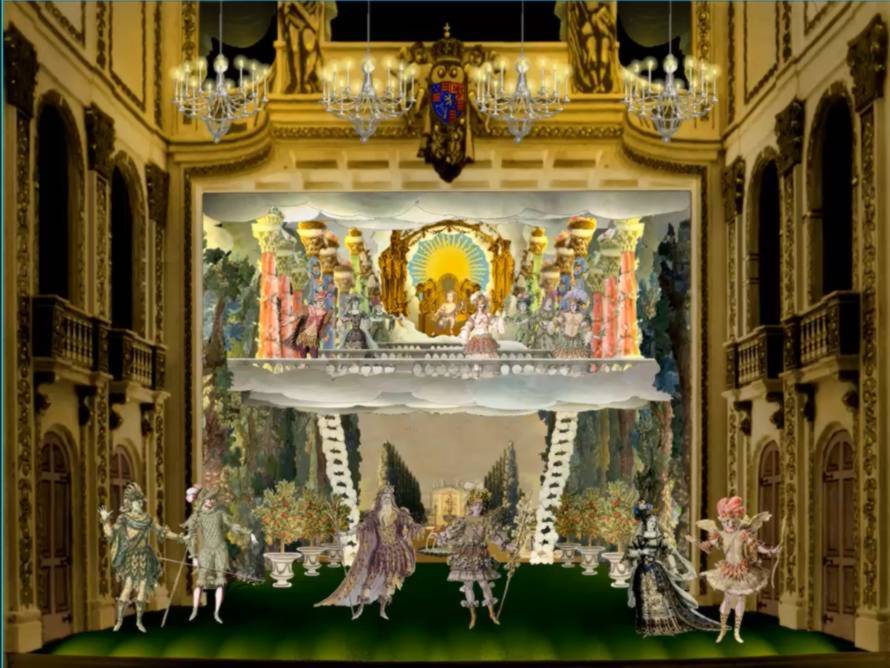
King Arthur: or, The British Worthy (1691), word-book by John Dryden, based on the unfinished play of the same name, commissioned by Charles II in the early 1680s.
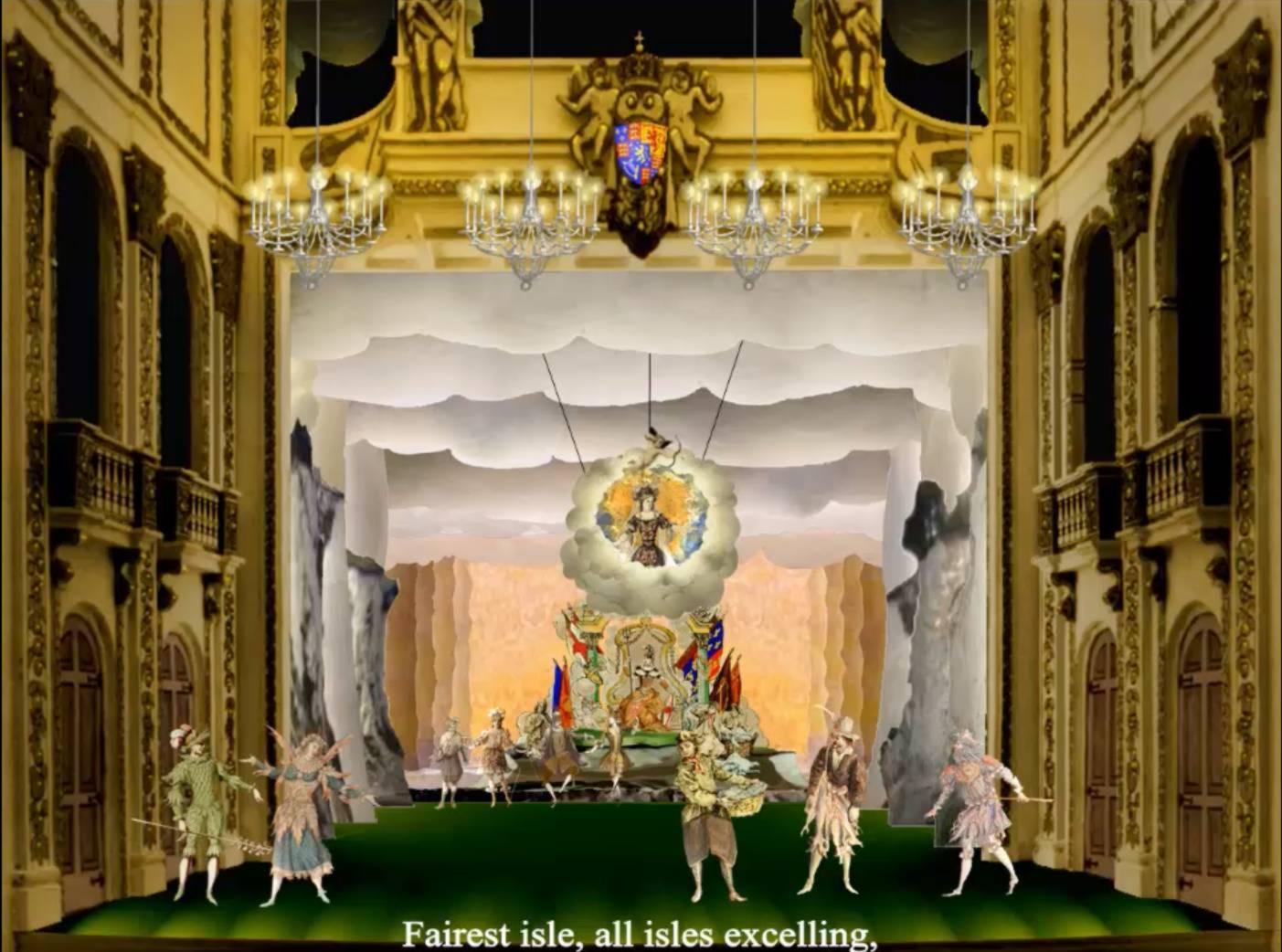
The Fairy Queen: an Opera, (1692, amended version in 1693) anonymous word-book, very loosely based on Shakespeare’s Midsummer Night’s Dream, attributed on stylistic evidence to Betterton.
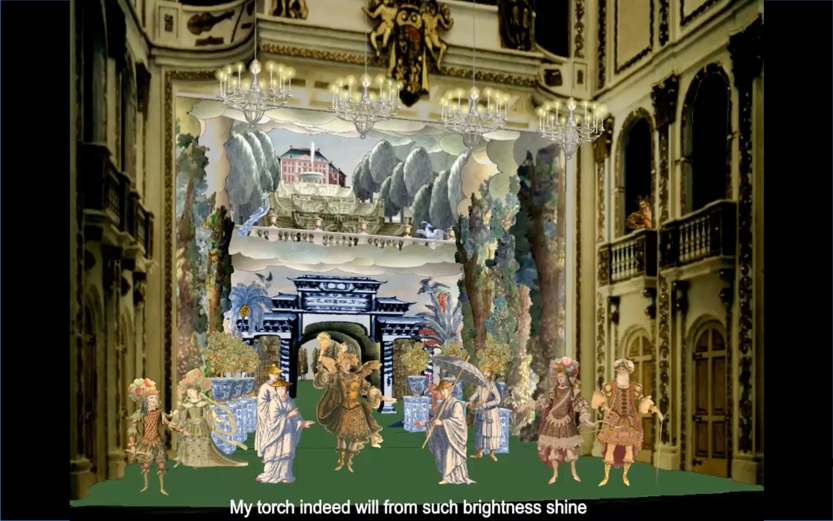
All three were spectacular productions, as is clear from both the stage directions in the word-books and the contemporary descriptions and commentaries. The United Company and the Dorset Garden theatre were at the pinnacle of their fame.
Christopher Rich seizes Power.
The Actors’ Rebellion
That was the moment at which the lawyer and businessman
Christopher Rich and his business partner Sir Thomas Skipwith decided
to seize power at the United Company, of which they were
shareholders.
Rich immediately began to economise, substituting cheaper, unfledged
young players for the experienced principals; an insult to the older
actors’ professional honour, which led to an actors’ rebellion the
next year, with Betterton in the forefront.
The breach occurred in December 1694. Betterton, taking almost all the experienced actors and actresses with him, went back to Lisle’s tennis court in Lincoln's Inn Fields. It was now called The New Theatre, although it wasn’t, really. It was the same tennis court in which the company had begun and which had been reconverted to its original use afterwards. It was now simply redecorated, unsuitable for large-scale opera productions and much smaller than the other theatres. When they moved, the company were forced to leave all their, scenery and machines behind. Henry Purcell also stayed behind.
Sure Providence at first design’d this Place
to be the Players’ Refuge in Distress.
...And this our Audience which once resort
To shining The-a-tres to see our Sport
Now find us toss’d into a Tennis-Court.26
Later that month, Queen Mary II died of smallpox. For her funeral, Purcell composed the Funeral Music which was to be played again eight months later, at his own.
Betterton was supported by friends, Sir Robert Howard and the Earl
of Dorset, the then Lord Chamberlain. The latter granted Betterton’s
company it’s own license. With the help of a number of influential
persons, they started a subscription to obtain funding.27 Now there were two acting companies in
London again, as before 1682, but what had been competition then, was
now total war.
The balance of power between the authorities and theatre directors
played a part there. Betterton being granted a license was a slap in
the face to Rich and a prelude to the vicious struggle for control of
the theatres which was to recur several times during the first third
of the eighteenth century. It would also occasionally lead to the
intervention of the government, culminating in the Licensing Act of
1737.28
Betterton’s company performed in Lincoln’s Inn Fields from April
1695 until the opening of the new Queen’s Theatre in the Haymarket in
1705. Initially it was a collective, led by Betterton with the
support of Mrs. Barry and John Verbruggen. After a while, there was
so much disagreement within the company that in 1699 the Lord
Chamberlain instructed Betterton to restore order, at the same time
severely limiting his financial latitude.
Among other productions, the repertoire consisted in The Indian
Queen, based on a play by Dryden and Howard with music by both
Henry Purcell and his brother Daniel, which had probably already
premiered at Drury Lane before Henry Purcell’s death in November
1695.
In 1699 the company astonished the London public by presenting a
new and spectacular opera on their small and poorly equipped stage:
Rinaldo and Armida, with music by John Eccles and a text by
John Dennis. The title page stated that the work was a tragedy, but
it is much more closely akin to semi-opera.29
It was so successful that it moved Rich to
counter with The Island Princess,30 to which we will return later.
In January 1701 the company presented a semi-opera, The Mad Lover, originally a play by Fletcher, adapted by Motteux with music by Eccles. Only the music has survived.31 Eccles was one of those who had gone with Betterton to Lincoln’s Inn Fields and he was the house composer there for a time.
Dorset Garden Deteriorates
The theatre in Drury Lane, now managed by Rich, was initially
rather unsuitable for opera productions, but was nevertheless
utilised, as the theatre in Dorset Garden was deteriorating. The
opera Brutus of Alba, with music by Henry and Daniel Purcell,
was performed there in 1696, followed by Cynthia and Endymion,
also with music by Daniel Purcell.
After it’s refurbishment, Elkanah Settle’s The World in the
Moon was put on at Dorset Garden in 1697, but a revival of
The Prophetess (Dioclesian) “for the entertainment of
the Envoy Extraordinary from the Kingdom of Tripoli” in 1700 took
place in Drury Lane. The staging will perhaps have been somewhat
simplified, but there was obviously enough left with which to impress
foreign visitors, including the huge “machine” consisting of four
separate stages specified in the finale, as a similar one, devoted to
the four seasons, had been used in the previous year for the finale
of The Island Princess.32
Drury Lane now obviously had a machine like the one of Betterton’s
that had been the talk of the town at Dorset Garden. The stage
directions for Godfrey Finger’s The Virgin Prophetess, or: The
Fate of Troy, first performed on May 15th 1701, also show that
Rich had equipped the theatre for spectacular staging. Rich, who had
lost his experienced actors, now concentrated on the visual apects.
After the turn of the century, scenes from The Prophetess
continued to be enacted at Drury Lane, for example after a
performance of The World in the Moon in 1703: “for the
entertainment of several foreigners, with a grotesque scene and with
the Grand Machine, both from Dioclesian”.33
Which Course should Opera Take?
The widespread idea that English semi-opera died with Purcell and
that there was a gap until Handel arrived, is incorrect.
At that time a struggle began between supporters of various kinds of
opera. We should distinguish between English
and continental opera structure on the one hand, i.e. with actors
speaking text and singers singing, as opposed to through-composed
works with secco recitatives, and between English-sung and
Italian-sung opera on the other, as it was waged among the literati
of the times.
Both conflicts were informed not only by aesthetic disagreement, but
also by nationalism, power play, profit making, and practical
problems like the structure of a company (were there actors available
to speak the texts, and how good were the language skills of the
singers); even by the characteristics of the stage itself.
Although “furriners” and their music and/or stagecraft had always been a target for xenophobic Brits, Italian music appears to have co-existed reasonably peacefully with English song for a while, as witness this excerpt from Evelyn's Diary for May 30th, 1698:
I dined at Mr Pepyss, where I heard that rare Voice, Mr Pate,34 who was lately come from Italy, reputed the most excellent singer ever England had: he sang indeede many rare Italian Recitatives, &c: & severall compositions of the last Mr Pursal, esteemed the best composer of any Englishman hitherto:...
Although Mr. Pate was an Englishman, The London Stage 35 lists quite a number of Italian singers invited to perform what was called “Entertainments of Singing” in London during this period. It also devotes a section to musicians, singers and music, including a description of Thomas Killigrew’s 1664 plan to bring in singers from Italy and to start a Nursery, i.e. an opera training school. That never happened, but Italian singers did come to England, where they became popular. One of them was Giovanni Battista Draghi, who was to contribute as both a singer and a composer to the 1674 Tempest and Psyche (1675), which were performed at Dorset Garden.
Apart from the developments noted above, there was a tendency to offer works of various types at a performance, rather than one play or opera: entr’actes of song and dance between the acts of an opera, a curtain-raiser and a farce or pantomime as an afterpiece or a scene from a successful opera, like the “Grand Machine from Dioclesian”.
The “Italian”Opera
From 1701-1714 the War of the Spanish Succession was waged against France and Spain; the Spanish empire including a large part of Italy. These countries, being Roman Catholic, were seen as a threat to both liberty and freedom of religion. Italian opera was thus a corrupting foreign intruder. And not just opera: even an Italian singer performing at a concert was suspect. This attitude was deplored among the more prosperous members of the population, able to go and partake of Italian culture themselves.
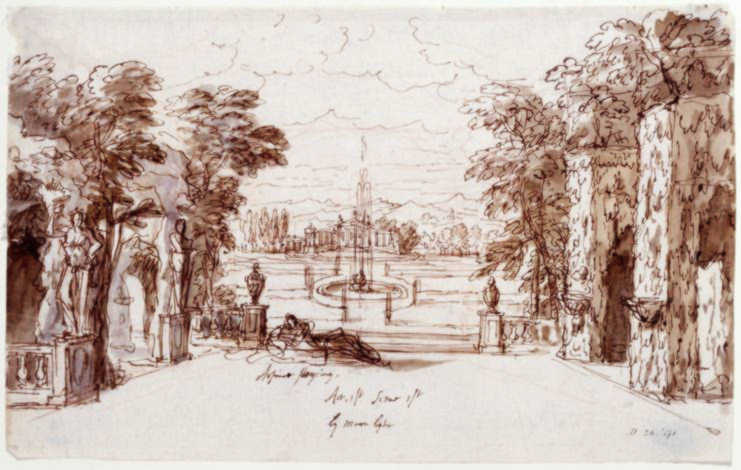
Arsinoe, Queen of Cyprus,
sketch for Act 1, scene i, “Moonlit Garden.”.
London, Victoria & Albert Museum D.26 1891
In January 1705, the first Italian opera in the sense of through-
composed was performed at Drury Lane, still under the management of
Christopher Rich.36 It was an English
adaptation by Peter Motteux of Stanzani’s Arsinoe, including
secco recitatives “After the Italian manner, all sung, being set to
Musick by Master Clayton[...]”.37
It was successful, with a first series of performances lasting
sixteen nights, one performance being in St. James’ Palace, and
during the 1705-06 season there were eleven more, a phenomenal number
for the times.
The scenery was designed by Sir James Thornhill, who was later to
become famous as the painter of the “Painted Hall” at the Royal
Hospital in Greenwich and the inside of the dome of St. Paul’s
Cathedral. His designs for the scenery of Arsinoe have
survived.
Arsinoe triggered a lengthy debate about the use of opera in general and Italian opera in particular. The most famous statement on the subject is undoubtedly Samuel Johnson’s, which can be found in his Life of the poet Hughes:
...an exotick and irrational entertainment which has
been always combated and always has prevailed.
But that didn’t appear until 1781.
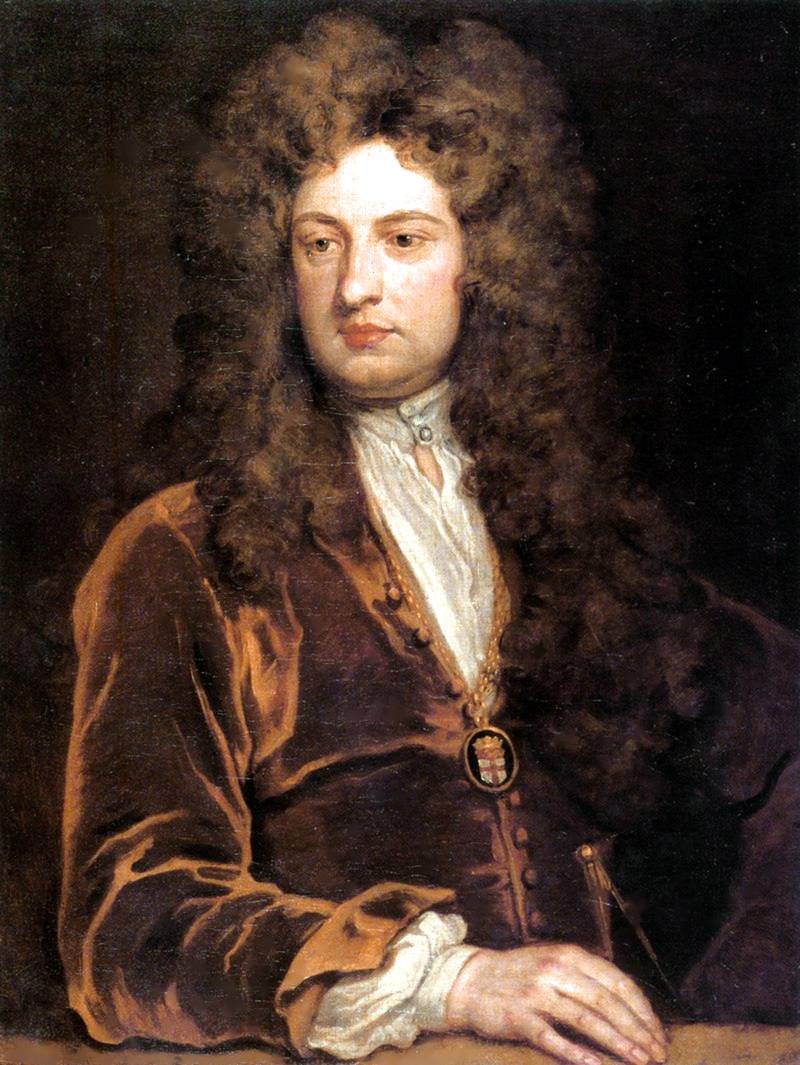
portrait of Sir John Vanbrugh.
London, National Portrait Gallery, NPG 3231
A New Theatre
After a protracted delay, a new theatre was opened in the Haymarket on April 10th 1705, with a prologue spoken by Anne Bracegirdle:
...Your own magnificence you here survey,
Majestick columns stand where dunghills lay,
And cars triumphal rise from carts of hay.
Swains here are taught to hope, and nymphs to fear,
and big Almanzors fight mock Blenheims here.
Descending goddesses adorn our scenes,
And quit their bright abodes for gilt machines...
It was built on the initiative and to the design of Sir John
Vanbrugh. Nicolas Rowe called it “Van’s tott’ring dome”.
In Vanbrugh’s view, the two London theatre companies would merge, under his direction. Vanbrugh’s goal was to revive the glory of the early nineties at Dorset Garden. His project had the full financial and moral support of his fellow-members of the Kit-Cat Club and the Vice Chamberlain. The theatre would accomodate both Rich’s company and Betterton’s, whose theatre in Lincoln’s Inn Fields was insufficiently equipped to compete with Rich’s Drury Lane, which was constantly being improved upon. Rich rejected the plan.
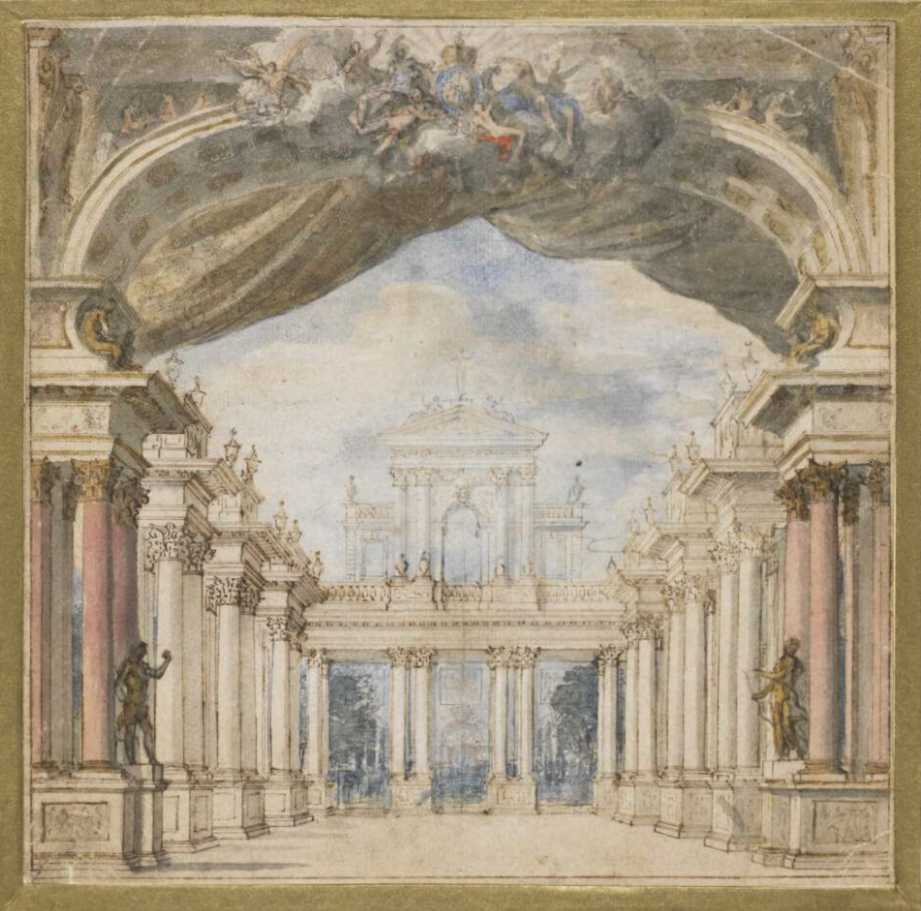
Stage design for a theatre, with elliptical frontispiece arch supported by Corinthian columns, flanking which are gilded statues of Momus (?) and Diana. At the top, the Royal Arms with deities on clouds, on the stage, a perspective formed by a colonnaded screen, beyond which are trees and a lofty pedimented building
According to the museum, this may be a design for The Queen's, later The King's Theatre in the Haymarket. In-depth investigation by Graham Barlow, in his 1983 thesis for the U. of Glasgow, has proved that it cannot possibly have led to its construction. From Tennis Court to Opera House, pp. 348-67. For a link see Bibliography.
London, British Museum K, 65.101
The new theater was called The Queen’s (or Her Majesty’s) Theatre,
after Queen Anne, who had succeeded William III. It was supposed to
have opened with Arsinoe, but, as mentioned above, Rich had
already performed that eight times at Drury Lane, so they opened with
an opera in Italian called Gli Amori d’Eragasto by the German
composer Jakob Greber, with an all-Italian cast.
The prompter Downes 38 tells us it
had “a new set of Singers, Arriv’d from Italy; (the worst that e’re
came from thence)”
It was sung entirely in Italian and was performed six times, so not a
great success, but not a complete failure either. Of course some
people’s nationalistic feelings got the better of them. Richard
Steele wrote:
No more th’Italian squalling tribe admit
In tongues unknown: ’tis Popery in wit.39
It seems that the vocal qualities of the singers and dancers were also less than excellent. Thomas Betterton talked about “prodigal subscriptions for squeaking Italians and capering monsieurs”, but of course he was a rival.
Betterton and his company performed in the new Queen’s Theatre in
the Haymarket, but returned temporarily to Lincoln’s Inn Fields,
probably because the Haymarket’s acoustics were unfavourable to the
spoken word,40 but in any case the
theatre was not quite ready yet. However by February 1706 he was back
in the Haymarket with the successful The British Enchanters, or:
No Magick like Love, a semi-opera with music by Eccles and
Corbett on the English text of George Granville’s poem of the same
name, written in the mid sixteen eighties and strongly influenced by
the lyric tragedy Amadis, by Lully and Quinault of 1684.41 The Haymarket was much better equipped
as to staging and that seems to have tipped the balance in favour of
their return. After ten years at Lincoln’s Inn Fields, they finally
got the chance to offer a lavish production.42
The acoustical problems, affecting the intelligibility of the spoken
word, were not yet resolved, however, and must have been a problem in
this semi-opera. Nevertheless they gave twelve performances, not a
lot compared to Arsinoe’s thirty-five, but enough to count as
successful. Semi-opera was still popular, as long as it was visually
spectacular enough.
Two weeks later, The Temple of Love followed; a pastoral in
the Italian mode, translated into English by Motteux and with music
by Giuseppe Saggione. It only lasted for two performances. The third
opera was presented very soon afterwards, in April: Durfey’s
semi-opera The Wonders in the Sun, or: The Kingdom of the
Birds. Given only five performances, this was no great success
either and financially it was a fiasco: too ambitious and too
expensive.43
The building the company had left in Lincoln's Inn Fields was used as a tennis court again from 1708 and also for other purposes that had nothing to do with the theatre.
At the same time, Betterton’s rival Rich was also presenting both
semi-opera and all-sung opera at Drury Lane, among which
Camilla, based on il trionfo di Camilla by Giovanni
Bononcini, the libretto adapted by Nicola Haym. This was an all-sung
opera modelled on the Italian. Camilla was sung entirely in
English at first, and later in both languages for a time. Between
March 1706 and April 1708 there were as many as forty
performances.
Addison’s Rosamond, with music by Thomas Clayton, however, had
had to be taken off the programme after only three performances in
March 1707 due to lack of interest. Rich then decided to refuse
Congreve and Eccles’ Semele in favour of Thomyris, a
pasticcio arranged by Pepusch, probably because Anne Bracegirdle, who
had sung all the works by Congreve and Eccles until then, left the
stage at that time. It wasn’t until the twentieth century that this
Semele, not to be confused with Handel’s oratorio, finally
reached the stage.44
Opera and Plays Sundered
Owing to manipulations by Vanbrugh, the government, represented by
the Lord Chamberlain,45 determined
that from 1708 on, the Haymarket was to be used for opera only and
Drury Lane only for plays.46
Vice Chamberlain Thomas Coke and his secretary John Stanley, charged
with the supervision of the theatres, were to ensure compliance with
the new regulation. Vanbrugh called Coke “...a great Lover of Musique
and promotor of Opera’s:...” 47 and
later he was one of the original subscribers when the Royal Academy
was founded.48
An Opera House in the Haymarket
Vanbrugh, whose company employed no actors, presented only all-sung opera after the separation and Rich was forced to limit himself to plays at Drury Lane. Works like The British Enchanters of 1706 could not be revived. This meant another temporary stop to the semi-operas, for reasons which had nothing at all to do with any artistic judgement concerning the genre.
Vanbrugh’s theatre was now devoted to Italian opera only, a totally new situation in the English theatre world, in which up until then - excepting incidental performances by foreign opera companies or at court - opera had always been on the calender of performances in the regular theatres, in contrast to the practice on the continent.49
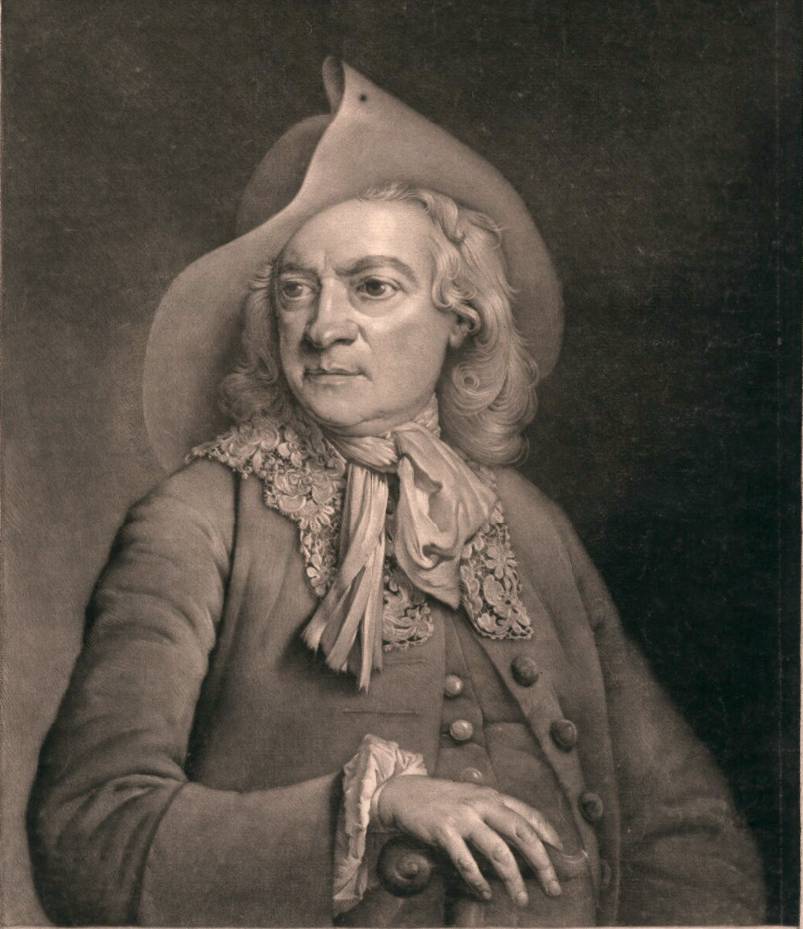
portrait of Owen Swiney,
London, National Portrait Gallery, NPG D5204
The Haymarket was in Westminster, farther from the city and catered mainly to the sort of public that could afford to keep a carriage 50 and was probably more likely to accept opera in a foreign language, even if it wasn’t understood (in the printed libretti, the arias, sung in Italian, were often translated into English verse, which sometimes diverged wildly from the original text).
Vanbrugh promised his singers huge salaries, although there were only two performances a week. He lost a fortune in four months and leased everything - the building, inventory, singers and patent - to his assistent Owen Swiney (also spelled MacSwiney, Swinny, Swiny) who had previously worked for Rich. Vanbrugh’s fellow-director, Congreve, had pulled out in time.
The Haymarket, now under Swiney’s management, was renovated in the
second half of 1708. The ceiling was lowered to improve the
acoustics, more seating was added, the apron stage was reduced,
orchestra space enlarged and proscenium doors replaced by boxes.51
It reopened in December. The first opera to profit from these
improvements was Camilla, which had been banished from Drury
Lane. It moved to the Haymarket in January 1709 and was performed
eighteen more times that year.
The Silencing of Drury Lane
In Drury Lane there was soon another clash between the
authoritarian Rich and the players: the Spring Rebellion.52 This time the dissatisfaction was
caused by the inordinate percentage of the money from benefits which
Rich demanded. The Lord Chamberlain sided with the players, who
wanted to get rid of Rich.
In April the Lord Chamberlain ordered Rich to rescind the new
regulation and when he hadn’t done so by June, his theatre was closed
down.53
The Tatler (No.42) reacted in July by publishing a mock
inventory of the Drury Lane theatrical stock:
This is to give Notice, that a Magnificent Palace, with great Variety of Gardens, Statues, and Water-works, may be bought cheap in Drury-Lane; where there are likewise several Castles to be disposed of...as also Groves, Woods, Forests, Fountains, and Country-seats...being the Moveables of Ch---r R---ch, Esq. who is breaking up House-keeping...
followed by an inventory including “A Wild-Boar kill’d by Mrs. Tofts and Dioclesian” and various objects that tell us something about the way in which special effects were achieved: “Three bottles and a half of lightning, one shower of snow in the whitest French paper [...]”
While the revolt was still brewing in March, Swiney signed an
agreement with the Drury Lane actors to form a company to present
plays again at the Haymarket. After Drury Lane was closed in June,
the actors remaining there asked the Lord Chamberlain Kent for a
solution. In July he gave the management of the Haymarket permission
to present plays on a maximum of four days a week and to engage the
necessary players (but Swiney had already done that and was also in
no hurry to offer the remaining actors and staff of Drury Lane a
contract for the 1709-10 season).54
The new season at the Haymarket started in mid-September. That month
Thomas Betterton took the title roles in two Shakespeare plays.55
Exit Rich, Drury Lane Reopens
In September Rich tried to reopen the theatre without permission,
but was prevented at the last minute and the public was sent home.
After the failed reopening, the situation was hopeless for everybody
connected with the theatre in Drury Lane.
A minor shareholder called William Collier, who was a Tory MP and a
lawyer, advised sending a petition to the queen.
In November Collier applied for a license to use Drury Lane, without
notifiying his fellow shareholders. Kent grasped the opportunity to
get rid of Rich. Collier got his license, on the condition that he
give up his own claim as a shareholder in Rich’s patent and block
Rich from having anything more to do with the theatre. He reached an
agreement with the owners of the building, by offering them a higher
rent than Rich had been paying.
On Guy Fawkes Day, Collier went to the theater with a group of
unemployed actors and a troop of soldiers to break down the door and
put the members of Rich’s staff who were present out into the
street.56 Rich had foreseen something
like this and had removed everything moveable. As a result, the
players had to give the first few performances wearing their street
clothes.
The other shareholders were furious about Collier’s betrayal and sent
another petition to the queen. She promised to have the matter
investigated, but that took a year and a half and by then it had been
overtaken by events.
Collier allotted the day-to-day management of the theatre, formerly
in the hands of a committee of seven actors, to the young and rather
pompous poet and writer Aaron Hill. That led to a certain amount of
friction, in spite of which the rest of the 1709-10 season was
reasonably successful.
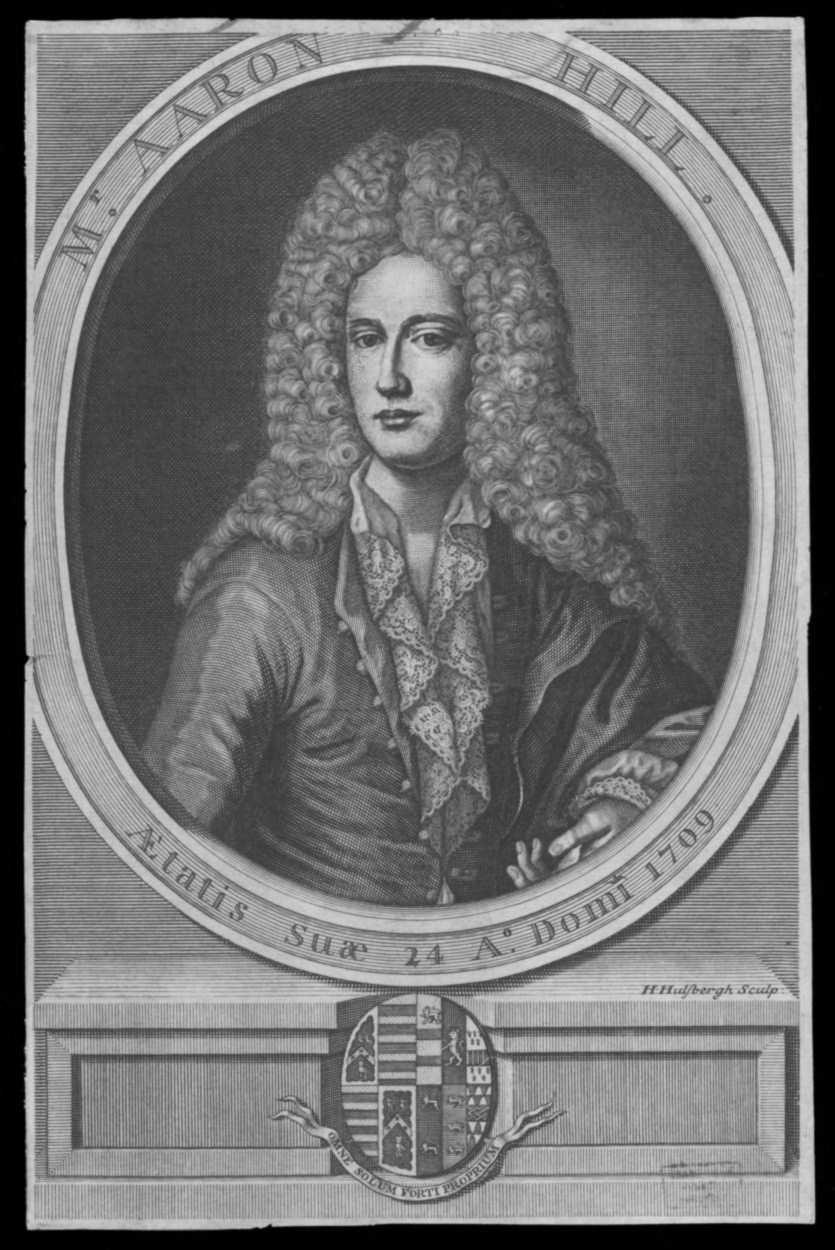
Portrait of Aaron Hill 1685-1750.
London, Victoria & Albert Museum, S.2066-2009
Now the theatres in Drury Lane and the Haymarket had to compete for the public’s favour again. That resulted in leaving more and more room on the bill for variety-like entertainment. The Haymarket presented Mr. Higgins, a kind of contortionist 57 and Drury Lane fought back with entr’acts including song and dance. Swiney tried to involve the opera singers in these entertainments, but they rebelled. His theater also suffered from the friction between the Italian opera singers and the English actors, now that they had to share the space. English opera singers and actors were used to working together on a production, but the Italian singers were not. Jealousy played a part as well, as the Italians earned so much more money. The famous castrato Nicolini complained to Vice Chamberlain Coke and threatened to leave.58
The theater in Dorset Garden continued to decay. Camilla
had been performed there once and Arsinoe twice more in the
summer of 1706 but in 1709 the thirty-nine-year lease of the ground
on which the building stood expired and it was demolished.59
Thomas Betterton died in April 1710.
Deadlock at Drury Lane
In the spring of 1710 there were rumblings at Drury Lane again,
after Hill had relieved the seven actor-managers of their duties. Two
of them refused to obey, so Hill suspended them. In May, there were
scuffles in the theater; swords were drawn and a number of people
were injured. All this, in a theatre filled with people who had come
to see a performance. Hill suspected that Rich was behind it, as he
had “just happened” to arrive at the beginning of the brawl and was
greeted enthusiastically by the players. Hill tried to approach
Stanley or Coke to complain, but when he returned, he was refused
entry to the theatre.60
Collier
went to the Duke of Shrewsbury, who had succeeded Kent earlier that
year as as Lord Chamberlain (Coke and Stanley had remained in
office). Shrewsbury ordered the actor Powell to be dismissed and his
colleagues Booth, Keene, Bickerstaff and Leigh to be suspended. While
this was going on, Rich seized the building, but still did not have
permission to give performances. The actors refused to work for
Collier and Hill. The resulting stalemate lasted for the rest of the
season.
Genres Separated Again
In September Swiney suggested a renewed separation of the genres to Vice Chamberlain Coke: opera only at the Haymarket and the building in Drury Lane to be leased to an actors’ company run by the actors themselves. Collier who, like Hill, was hated by the players, wasn’t about to let himself be shut out. After some haggling, a compromise was reached: Collier was given the right to present operas twice a week at the Haymarket, thus becoming Swiney’s subtenant. In return, Collier left the exploitation of the theater to Aaron Hill.61
Swiney and his company were granted the right to present plays at the Haymarket four times a week. He was unhappy about the limitation, particularly as the profitable Saturday evening was reserved for opera. However Collier succeeded in persuading the majority of the Drury Lane shareholders to lease the building to Swiney’s company, which opened there on November 20th 1710. So Swiney got his way after all.
After all the tumult, the genres were separated as before. It was clear that that was the best solution for all concerned. Having Italian singers and English actors under the same roof, turned out to be a bad idea. The competition between the theatres was over. Now plays were again performed in the most suitable theatre. Such was the situation when Handel came to London for the first time.
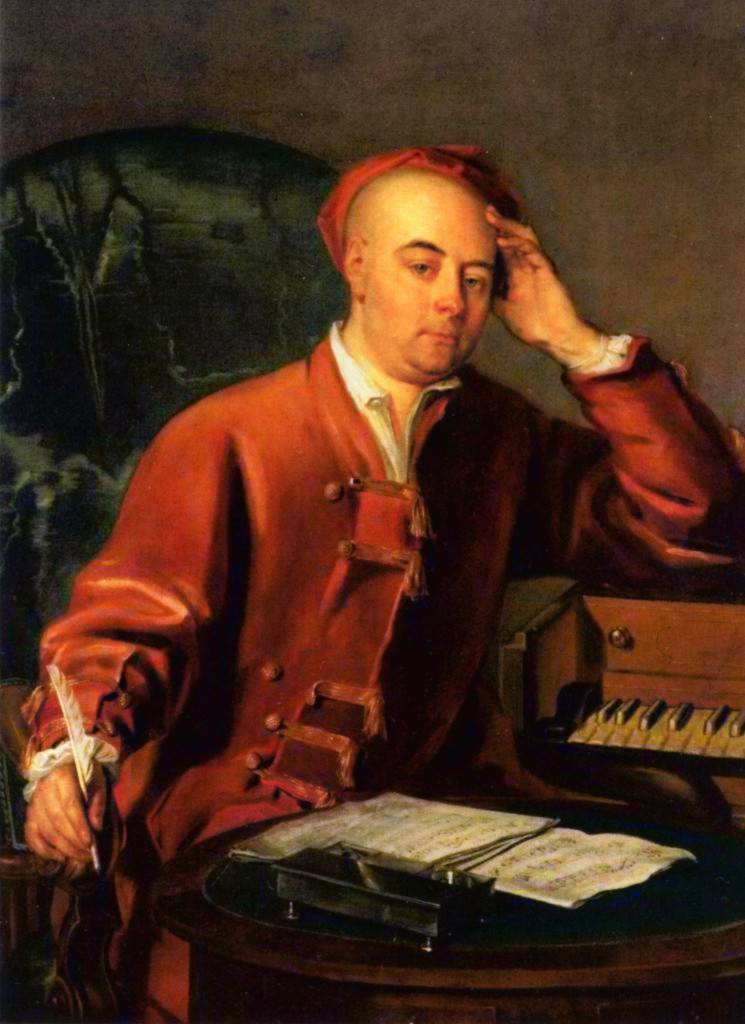
Portrait of George Frederic Handel.
Halle, Händel-Haus.
George Frederic Handel
In the winter of 1706 Handel had gone to Italy. In Rome he was
invited to Cardinal Ottoboni’s Wednesday musical meetings, where he
first met most of the Italians with whom he later worked in London:
one of his librettists, Paolo Antonio Rolli, (the other one, Nicola
Haym was already in London) Pietro Castrucci, later leader of the
King’s Theatre Opera Band and Filippo Amadei (aka Pippo Mattei) the
cellist who collaborated in Muzio Scevola. He also met
Ottoboni’s orchestra leader, the violinist and composer Arcangelo
Corelli, who was known for the precision with which he conducted an
orchestra.62 The young Handel will
have learned a lot from him.
In 1707, still in Rome, he started writing dramatic chamber cantatas,
which had been developed in Italy. Like opera, they had alternating
recitative and aria, but in a much simpler and more intimate world:
pastoral. He wrote nearly a hundred pastorals, many for Margherita
Durastanti, who was later to be one of Handels great soloists in
London. This was the first time Handel was writing music for a
specific voice.
His stay in Italy came to an end when he was invited to Hanover by
both Duke Ernst August of Hanover (one of the Elector’s brothers) and
Baron Kielmansegg, whom he had met in Venice. He arrived there in the
spring of 1710.
Agostino Steffani, the composer whose operatic works greatly
influenced Handel, was also employed there. Baron Kielmansegg
recommended him so strongly to the Elector, Georg Ludwig, better
known to us by his later title of King George I of England, that
Georg appointed him Kapellmeister on June 16, 1710, at a
salary of 1500 Reichsthaler a year.63 Handel had declined at first, saying that he was
planning to travel to England, to which Georg replied that he would
grant him leave for twelve months and longer if necessary, to go
wherever he wanted to. At that, Handel accepted.
Georg Ludwig’s Charm Offensive
The trip to London did not take him to a country totally unknown
to him and it was as important to Georg as to Handel himself, for
political reasons.
When in 1688 the by now openly Roman Catholic James II was removed
from the English throne in favour of his daughter Mary and her
husband William of Orange, Stadholder of the Netherlands, Parliament
started thinking up ways to avoid the same kind of conflict in the
future. After Mary’s death in 1694, Parliament had decided that
William (who was childless) should continue to reign until his death.
That occurred on March 8th 1702.64 He
was than succeeded by his wife’s younger sister, Anne, another
staunch Protestant. She was married to George of Denmark and they had
seventeen children. All but one died in infancy and that one,
William, Duke of Gloucester died in 1700 at the age of eleven; the
occasion of much mourning and a great deal of beautiful music.
At that point it became obvious that there was going to be a problem with the succession. To keep James II’s Catholic son out, (he was known later to Catholics as James III) an Act of Settlement was passed in June 1701, consigning the English crown, after William and Anne, to her cousin Sophia, Electress of Hanover and “the heirs of her body being Protestants”. Sophia was eighty by then, her son Georg Ludwig, fifty, knew that he would become king sooner or later. He was not welcome in Queen Anne’s England for both personal and political reasons. His presence would remind Anne of the early deaths of her own children and the government did not want a secondary court. Georg already had a representative in England, but a non-political “advance guard“ wouldn’t hurt. Besides, Handel had the potential to become popular in England.
Rinaldo, Handel’s First London Opera
Johan Jacob Heidegger, the son of a German living in Zürich, had already worked in London for a number of years. Among other things, he arranged pasticcios.65 He worked for the Haymarket and introduced Handel to London society; some members already knew Handel, or at least his reputation, from Italy or Hanover.
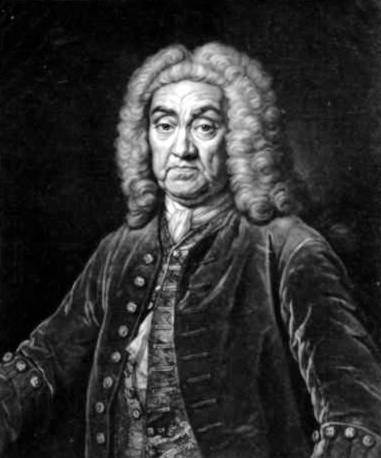
portrait of John James Heidegger.
Paris, Bibliothèque nationale de France,
dép. Musique, Est. Heidegger J.001
The manager of the Haymarket at that time was Aaron Hill, a
contemporary of Handel, who presumably asked him to write an opera.66 Hill had travelled around the Middle
East with a chaperon as a very young man from around 1700, and had
visited Jerusalem. On his return home, he wrote a book about it.67 The subject for Handel’s
Rinaldo was probably chosen by Hill, as it was so important to
him. That would also explain the high degree of Christian chauvinism
in the libretto.
Hill wrote a scenario, very loosely based on Torquato Tasso’s poem
La Gerusalemme Liberata of 1581. The poet Giacomo Rossi wrote
the Italian libretto, which Hill translated into English. Handel
wrote the music in the record time of two weeks, making lavish use of
music from his earlier operas.68 This
was the origin of the first opera in Italian specifically written for
London,69 which premiered on February
24th 1711. Rinaldo was a very successful production, which ran
for another fifteen performances that season.
The opera is still beloved of opera companies for its wealth of
melodies and there is a bonus for conductors working from behind the
harpsichord: solos, in which Handel gives them plenty of room to
shine.
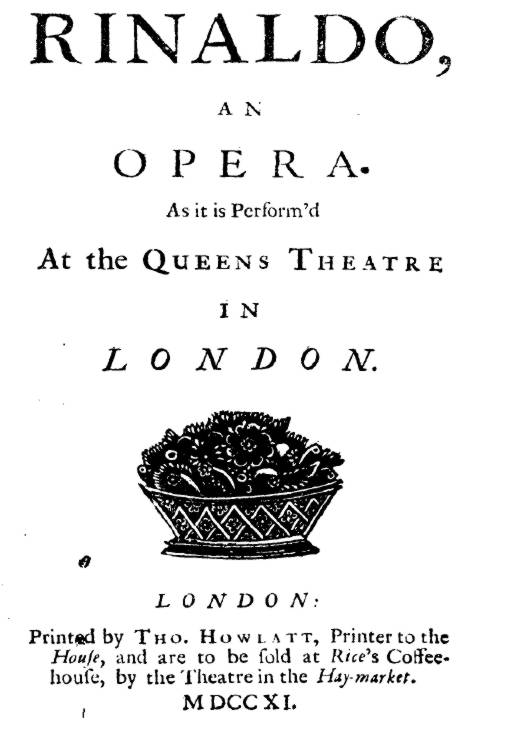
Hill wrote in his dedication to Queen Anne that he aimed to fill both
eye and ear and that is clear from the stage directions:
In Act I Argante appears in a Triumphal Chariot drawn by horses, soon followed by Armida, in a Chariot drawn by two huge Dragons, out of whose Mouths issue Fire and Smoke. Armida kidnaps Almirena. When Rinaldo prepares to fight Armida, a black Cloud descends, all fill’d with dreadful Monsters.
Act II opens with a sea with the reflection of a rainbow in it. Two mermaids are seen Dancing up and down in the Water and Rinaldo is lured to Armida’s enchanted palace in a boat.
Act III: “A dreadful Prospect of a Mountain, horridly steep, and rising from the Front of the Stage, to the utmost Height of the most backward Part of the Theatre; Rocks, and Caves, and Waterfalls,70 are seen upon the Ascent, and on the Top appear the blazing Battlements of the Enchanted Palace... a great Number of Spirits... Pillars of Chrystal, Azure, Emeralds... The crusaders actually have to climb the “mountain!”
Addison wrote a satirical article about the scenery ten days after the premiere, which demonstrates that much of what is written in the stage directions really did appear on stage: a real waterfall, real birds 71 and probably even real horses:
[...] An Opera may be allowed to be extravagantly lavish in its Decorations, as its only Design is to gratify the Senses, and keep up an indolent Attention in the Audience. Common Sense however requires that there should be nothing in the Scenes and Machines which may appear Childish and Absurd. How would the Wits of King Charles's time have laughed to have seen Nicolini exposed to a Tempest in Robes of Ermin, and sailing in an open Boat upon a Sea of Paste-Board? [...] What a Field of Raillery would they have been let into, had they been entertain'd with painted Dragons spitting Wild-fire, enchanted Chariots drawn by Flanders Mares, and real Cascades in artificial Land-skips?72
Or maybe not:
[...] the Undertakers of the Hay-Market, having raised too great an Expectation in their printed Opera, very much disappointed their Audience on the Stage. The King of Jerusalem is obliged to come from the City on foot, instead of being drawn in a triumphant Chariot by white Horses, as my Opera-Book had promised me.73
Or did Collier make them get rid of the horses after the first performance(s)? That would have been understandable.
Who Pays the Piper?
Nine days after the premiere, Hill and his people were ejected from the theatre by Collier, who hired new personnel and confiscated all the costumes, scenery and stage properties. However there turned out to be many other creditors and when they weren’t paid, they complained to Shrewsbury. He didn’t really overrule Collier’s assumption of power, but did direct him to inform him precisely about all obligations and payments and not to make any more without Shrewsbury’s explicit consent.
Hill defended himself against the creditors’ claims by stating that the subscribers’ money was to be held on deposit for them by a third party 74 until after the performances. The creditors were not to be paid until then. That had already been done in part and there were still five hundred pounds left for disbursement, which had now become impossible because Collier had appropriated the money.
It seems probable that Collier wanted to safeguard his own share
and a little more betimes, as there had only been three performances
of Rinaldo to date. Given its success, more income was
expected. But the creditors...
On May 3rd 1711, Collier was commanded by Vice Chamberain Coke to pay
Hill back all that he had a right to, but Collier didn’t and Hill was
stuck with the debts. His role at the Haymarket was played out for
the time being. The young poet was worsted by the artful lawyer and
made no further attempts to regain his position, but the London
theatre world was to hear from him again.
On April 17th Shrewsbury had commanded Collier to leave the running of the Haymarket to his landlord Swiney and return to Drury Lane. That was to Collier’s advantage and he may have had a hand in it, as it had become clear that there would be no profits to be had from the Haymarket. Swiney did gain the right to present plays as well as operas again, but his tenure didn’t last long. The financial situation became untenable and after a performance of Teseo on January 14th 1713, Swiney absconded.75 Soon afterwards he fled to the continent to evade his creditors.
Addison, who had been waxing sarcastic about Italian opera, wrote in The Spectator of April 3rd 1711, shortly after the first performances of Rinaldo:
But] however this Italian Method of acting in Recitativo might appear at first hearing, I cannot but think it much more just than that which prevailed in our English Opera before this Innovation: the Transition from an Air to Recitative Musick being more natural than the passing from a Song to plain and ordinary Speaking, which was the common Method in Purcell’s Operas. The only Fault I find in our present Practice, is the making use of Italian Recitativo with English Words.
In the following years, a number of other Handel operas were performed at the Haymarket: Il Pastor Fido, with a libretto by Giacomo Rossi, the Teseo mentioned earlier,76 an adaptation by Nicola Haym of the Lully-Quinault tragédie lyrique Thésée and Amadigi di Gaula which, like Teseo, was based on a work of French origin, but much more rigourously adapted. Amadigi was based on Amadis de Grèce by Destouches and Houdart de la Motte, rather than the expected Amadis de Gaule. The productions were praised for the high quality of the scores and for the staging, specifically that of the Fountain of True Love in Amadigi.
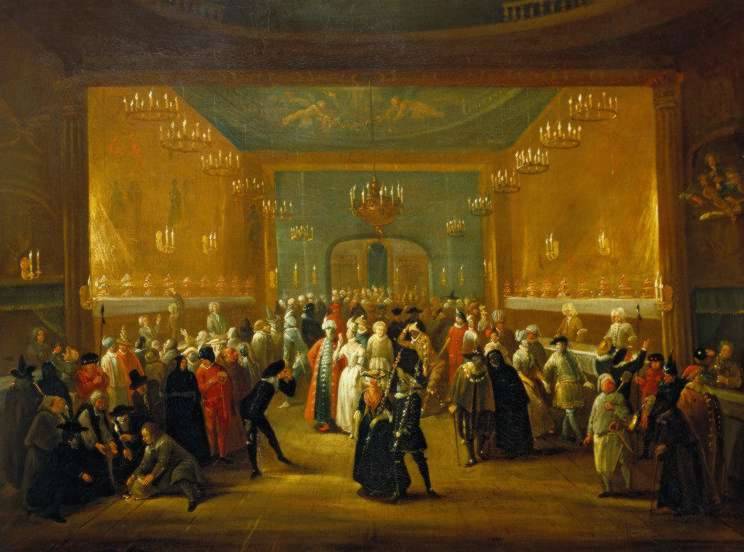
A masquerade in the Queen’s Theatre in the Haymarket.
London, Victoria & Albert Museum, P.22-1948
Masquerades
Heidegger had been earning money by putting on masquerades on alternate (non-opera) days and they became quite the rage. Tickets sold for a guinea and a half, three times the price of an opera. For these masquerades planks were laid over the pit to bring it up to the level of the stage and to turn the whole theatre into one large space, all the way down to the vista stage.77 There are said to have been 500 candles burning; not tallow, but the more expensive wax candles.
The Succession
Queen Anne died on August 1st, 1714, without successors in the
direct line. Sophia had died in June, to be succeeded by her son
Georg Ludwig, who didn’t arrive in London until the end of September,
having spent some time in The Hague, awaiting a favourable wind.
Elector Georg’s mother, the Dowager Electress Sophia of Hanover, was
a granddaughter of James I, her mother Elizabeth having been
Charles I’s only sister, who married the Elector Palatine. So Sophia
was as much a Stuart as she was a Hanover and her brother was that
Prince Rupert whose generalship on the Royalist side during the Civil
War was so highly commended and to whom a lot of music of the period
was dedicated.
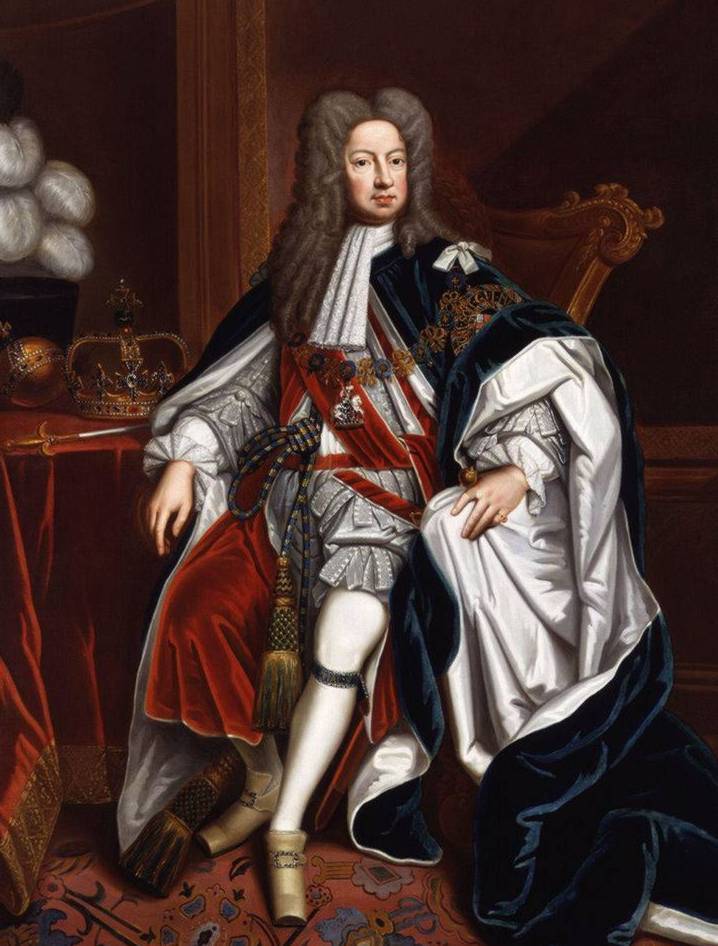
portrait of George I of Engeland / Great-Britain.
London, National Portrait Gallery NPG544
Georg Ludwig was crowned George [I] of England on October 20th
1714. He was and remained attached to his own Hanover, spending a lot
of time there.
The English didn’t like him and English pop history books to this day
spout a great deal of rubbish about him, for instance that he was an
illiterate barbarian, who knew no English. That is nonsense. His
mother was English and the language was spoken at her court. George
did have a strong German accent. He was also said to be totally
uninterested in the arts. It was this barbarian who sent Handel to
London and gave him full financial and moral support for the rest of
his life. He was a great music lover.
The Jacobite Rebellion
The Jacobite Rebellion of September 1715 was the direct result of
the succession.
During the rebellion, things went badly for the theatres,
particularly the Haymarket.78
Afterwards, they recovered to some extent. Handel’s Rinaldo
was performed nine more times in 1717 79 and his Amadigi twelve more times in 1716
and 1717. Several operas by Italian composers followed, including
Bononcini. Eventually the theatre in the Haymarket closed temporarily
and there were no more Italian operas to be seen in London until
after the Royal Academy was established in July 1719. That made a
fresh start possible for Handel and Heidegger.
Increasing Competition
When the new king came to the throne, the Drury Lane company had
to ask for a new license. That was the occasion for asking the
essayist and playwright Richard Steele, who had good connections in
both the court and the theatre world, to join the management. Steele
preferred to ask for a patent, which would make him less dependent on
the authorities. He succeeded in obtaining one from King George,
mainly because he promised to reform the stage and deliver it from
immoral behaviour.
His reforms did not succeed very well due to the serious competition,
especially after Christopher Rich had had the tennis court in
Lincoln’s Inn Fields reconverted into a new Theatre Royal and had
been granted a license for it by the new king. It was opened in
December. 1714, shortly after his death, by his son John, in December
1714.80
Now there were three theatres competing for the public’s favour.
Variety-like entertainments regained the upper hand.
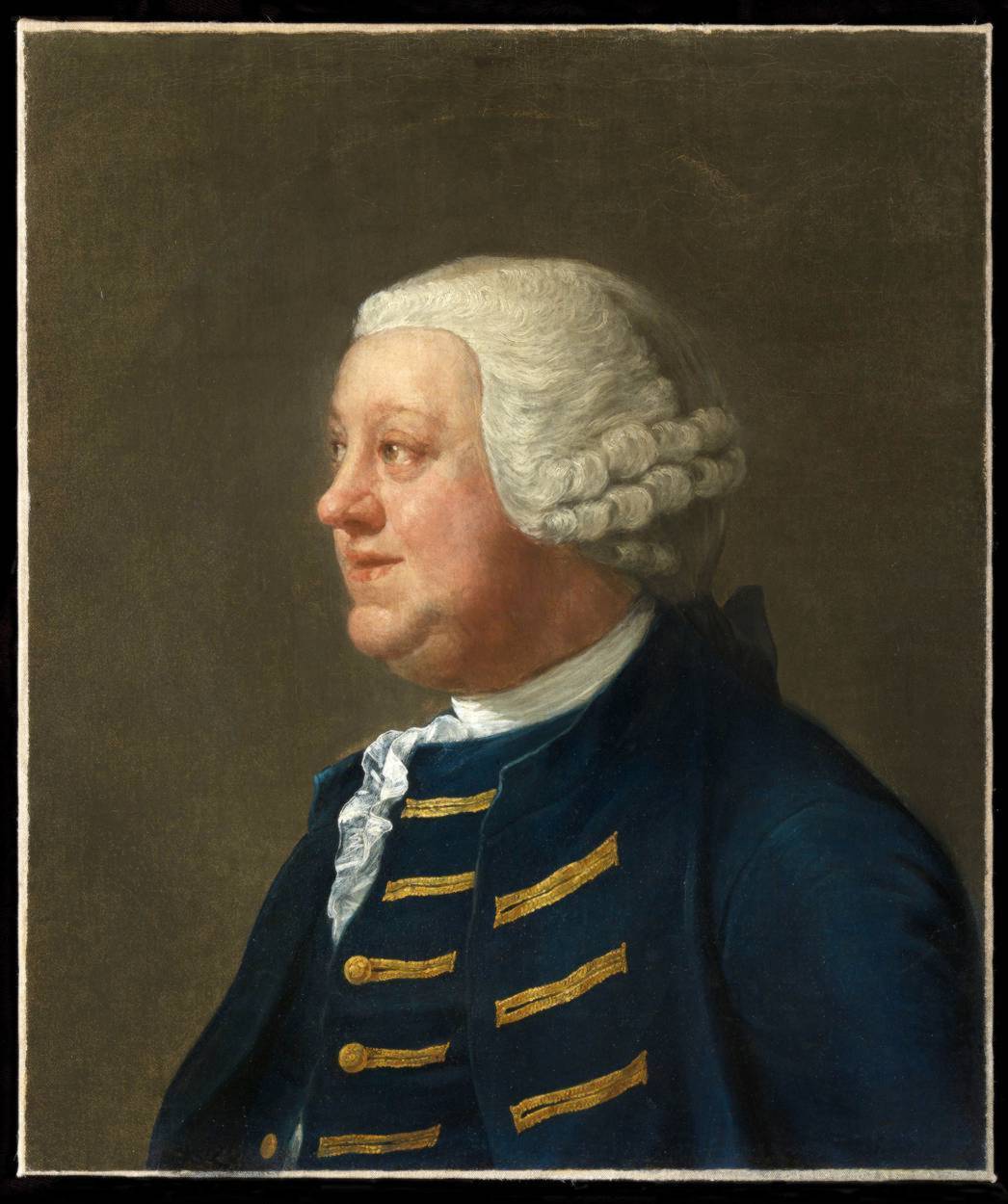
Portrait of John Rich.
Private collection.81
The authorities, meanwhile, were looking for ways to bring Drury Lane back under their supervision and they succeeded in January 1720. The then Lord Chamberlain, the Duke of Newcastle, managed to stymie Steele. Although he retained his patent, Drury Lane was closed and not allowed to reopen until the Lord Chamberlain’s authority had been accepted.
Plays were performed in the new Theatre Royal in Lincoln’s Inn Fields, alternating with song, dance and pantomime in which John Rich appeared himself. These, however, lost money. It was a difficult time for John Rich, too, which improved temporarily when, a year after the opening, he revived Purcell’s Dioclesian.82 It was a great success, with seventeen more performances in the 1715-16 season, ten in the next and six in 1717-18. It seems that the prohibition against performing opera anywhere but in the Haymarket was no longer enforced under George I, unless semi-opera was not perceived as “real” opera even then?
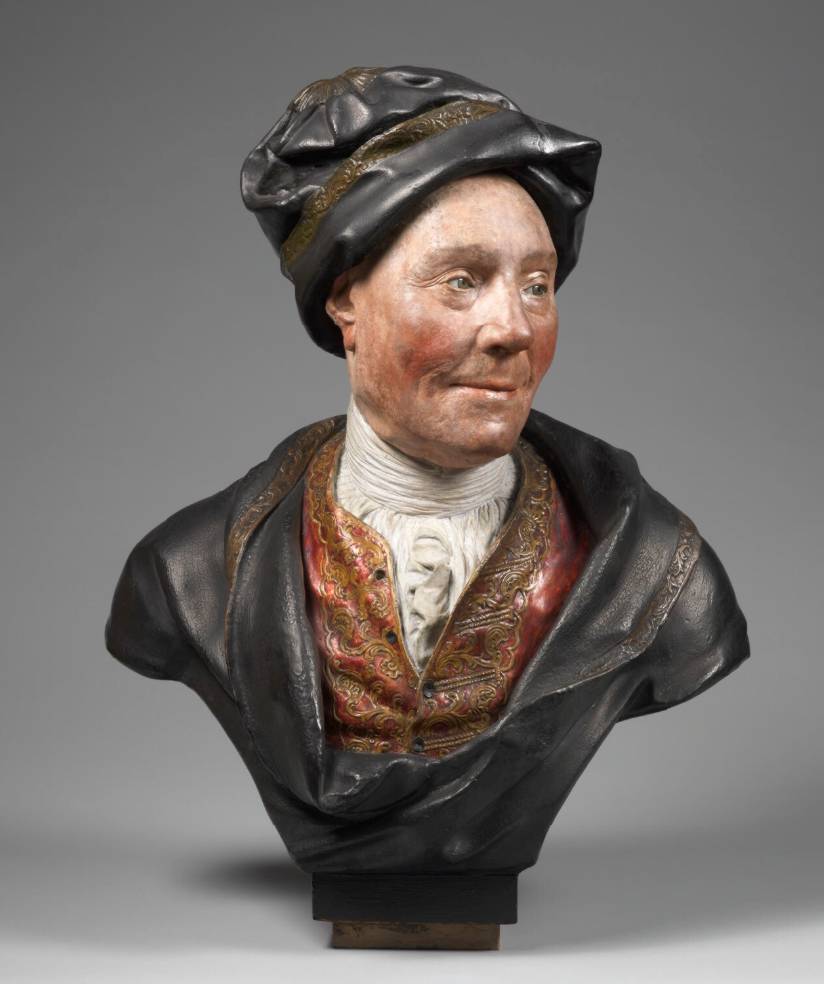
bust of Colley Cibber.
London, National Portrait Gallery, NPG 1045
In the meantime time Colley Cibber and Johann Christoph Pepusch
had been trying to re-establish English opera at Drury Lane. In 1715
they put on a “musical masque” called Venus and Adonis
“compos’d after the Italian manner and perform’d all in English”. The
members of the audience were offered a text. In his preface, Cibber
described the piece as “an Attempt to give the Town a little good
Musick in a Language they understand.” 83
Late in 1716, Pepusch and his orchestra moved
from Drury Lane to the Theatre Royal in Lincoln’s Inn Fields, which
had newer and better scenery and machines, and where, aside from
Purcell’s Dioclesian, other English through-composed works
were staged, including Galliard’s Pan & Syrinx and thirteen
more performances of Camilla.
The trouble at Lincoln’s Inn Fields was not over, though. In 1717 the theatre almost went bankrupt. John Rich, aged twenty-two, with little experience and less prestige among the players, leased Lincoln’s Inn Fields to two experienced actors, Theophilus Keene and Christopher Bullock. He continued to perform there in pantomimes, later adding Italian-style dance. Keene died the next year and George Pack took his place. In 1720 John Rich and his brother Christopher were forced to take back control when Bullock and Pack stopped paying rent, presumably due to lack of money. That summer, the bailiffs were back at the door. The brothers were also quarreling with one another about their inheritance from their father.
Cannons
There was no demand for opera from Handel at the Haymarket for a time. He left the London theatrical world until 1719, executing commissions for various people, mainly James Bridges, Earl of Carnarvon at that time, later Duke of Chandos.
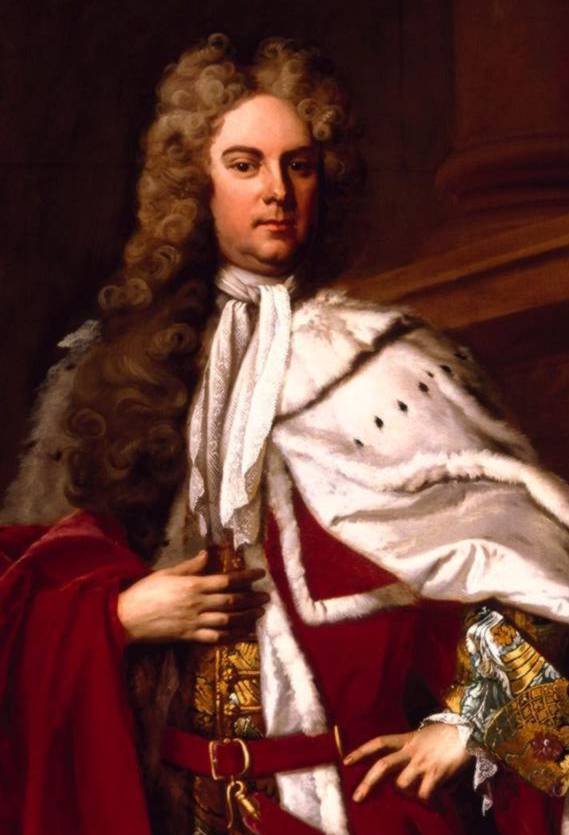
portrait of James Brydges, first Duke of Chandos.
Private collection.
He probably spent a lot of time at Carnarvon’s country house at Cannons, presumably immortalised by the poet Alexander Pope as ‘Timon’s Villa’. There were many musicians there, including the music master, Johann Christoph Pepusch. Handel also furthered his acquaintance with the poet John Gay and although he was then not active in the London theatrical world, paradoxically it was during this period that he and Gay collaborated on what may well be the most often performed of his works for music theatre - and one of the best-loved: Acis and Galatea.
Water Music
King George had the idea of getting Heidegger to provide a summer
river concert by subscription. Baron Kielmansegg was the intermediary
there and when Heidegger insisted that subscription be limited to
“important events” (i.e. his masquerades), the good baron decided to
organise the entertainment himself.
On July 17th 1717, at about eight in the evening...
...the King took water at Whitehall in an open barge [...] and went up the river towards Chelsea. Many other Barges with Persons of Quality attended, and so great a Number of Boats, that the whole River in a manner was cover’d; a City Company’s Barge was employ’d for the Musick, wherein were 50 Instruments of all sorts, who play’d all the way from Lambeth (while the barges drove with the tide without rowing, as far as Chelsea) the finest Symphonies, compos’d express for this Occasion by Mr. Hendel; which His Majesty liked so well, that he caus’d it to be plaid over three times in going and returning.84
The Era of Vocal Acrobatics
The arrival of Italian opera in London initiated the first great
age of vocal acrobatics.
Standard features of opera seria included dramatisation in recitative
with gestures) to tell the story, followed by an aria, in which the
emotions were expressed and which was often full of vocal
pyrotechnics, preferably sung at the end of a scene or an act, with
the singer leaving the stage, inviting applause to bring him or her
back.
There were fewer duets and trios (the rivalry between the Italian
singers was notorious as we shall see and composers were aware of the
pitfalls). There was almost always a final coro of those left alive.
Word painting, which, thanks to composers like Lully and Purcell, had
become a valuable tool for singers for conveying emotions, lost its
meaning for a considerable part of the audience as, in order to
appreciate it, one must be able to follow the text word by word.
“Painting” a word by means of ornamentation had also become less
effective, now that almost every word was ornamented. The medium had
now become the message, as was the case with spectacular scenery,
shown without its context on the late seventeenth-century and early
eighteenth-century stage.
A Fairy-Tale World
The main characters in an opera were special from the start. They
were either supernatural or at least of high rank, had unusual powers
(Orpheus), were super-heroes (Theseus, Amadis, Rinaldo) or super
strong (Hercules); a conscious choice meant to distance, in order to
suspend disbelief, for which reason the stories were situated in
faraway lands and times of yore. Once upon a time...long, long
ago... far, far away...
Characters with a low status, such as servants, added contrast or a
comic note.
Language that seems to us high-flown and moralistic, was used
deliberately to contribute to the desired effect.
Initially, the stories were often classical and reflected the
education of the seventeenth-century court and nobility. By the
eighteenth century, the influence of the gentry was increasing.
In the seventeenth century the stories were usually taken from Greek
mythology, as in the influential French operas, with Ovid’s
Metamorphoses the most important source of inspiration,
followed later by medieval tales of chivalry and adaptations of
Shakespeare.
Betterton’s selection of a story about the Roman Empire
(Dioclesian) started a new trend, which was to flourish in the
eighteenth century. Inspiration for those operas came from the
chronicles of Plutarch, Tacitus and Livy. Many Italian libretti for
the Haymarket were however copies of libretti written on the same
subjects in Italy and simply adapted to circumstances in London.
Italian adaptations of the successful French repertoire of the
seventeenth century were still being performed on occasion. Sometimes
these followed the French original exactly, like Handel’s
Teseo, sometimes they were seriously altered in adaptation,
like his Amadigi, and sometimes there was no more than a
common source, like Lully’s Armide and Handel’s
Rinaldo.
As the singers and their individual achievements shifted to the
centre of the public’s attention, interest in the quality of the
narrative declined. The numerous pasticcios, with music scraped
together from various sources and no coherent story, enhanced this
effect.
Financial considerations also played an important part. Engaging Italian singers was very expensive, leaving less money for other things. The company fell back on stock scenery and costumes. For a time, there was also very little dancing during Italian operas.
The Royal Academy of Music
It was clear that, without new ways of financing it, the Italian
opera would not survive.
In 1718 a group of noblemen started a huge project to bring back
Italian opera to the Haymarket. They set up a joint company with each
subscriber guaranteeing 200 pounds of the 10.000 pounds of shares.
Every shareholder got a vote, those guaranteeing over 1000 pounds
got three. Seventeen dukes, six duchesses, a marquess, twelve earls
and four viscounts eventually participated, with the king
guaranteeing a yearly ‘bounty’ of a thousand pounds, for the next
seven years.
In February the Original Weekly Journal, anticipating events,
announced that...
Mr Hendel, a famous master of music, is gone beyond the sea by order of his Majesty to collect a company of the choicest singers in Europe, for the Opera in the Hay-Market.
The then Lord Chamberlain, the Duke of Newcastle, became Governor
of the Royal Academy, as was stipulated in the statutes, and in May
Handel received a warrant from the Academy directing him “forthwith
to repair to Italy, Germany or such other place or places as you
shall think proper, there to make Contracts with such Singer or
Singers as you shall judge fit to perform on the English Stage.”
Above all, he was to engage Senesino as soon as possible, “[to] Serve
the said Company and for as many Years as may be.” The charter of the
Academy was ratified on July 27th 1719.85
Assembling an Opera Company
Handel went to Dresden to engage singers. On the way he stopped in
Halle, where he and Bach just missed each other.
Dresden was en fête for a royal wedding. Prince Friedrich August was
getting married to the Habsburg princess Maria Josepha, Archduchess
of Austria.
Antonio Lotti had written his opera Teofane, about a Byzantine
princess, to be performed during the celebrations.
Lotti had moved from Venice to Dresden two years earlier, in order to
work for the court of August II of Poland (August the Strong) and had
brought his star singers with him from Italy: the castratos Senesino
and Matteo Berselli, the bass Guiseppe Maria Boschi, the sopranos
Margherita Durastanti and Francesca Cuzzoni. The first four had parts
in Teofane. Santa Stella, Lotti’s wife, sang the part of
Teofane and Senesino the part of Ottone. Cuzzoni was not in the
Teofane cast, but it is very likely that Handel heard her sing
in Dresden too.
Senesino
Senesino 86 was the stage name of
Francesco Bernardi, the greatest castrato of the age. Born in about
1680, he made a name for himself as a singer in Venice. His voice was
by all accounts glorious. He delighted Venice and Vienna and in 1719
he was singing in Dresden, which is where Handel went to engage
him.
Durastanti and Berselli were engaged for London. Durastanti wanted
sixteen hundred pounds for an eighteen-month contract but Senesino
wanted two thousand, as he was being lavishly rewarded by the Dresden
opera and didn’t want to settle for less. He also demanded a say in
the Academy’s programming. Handel objected to that. He didn’t fancy
sharing his position as musical director with a singer.
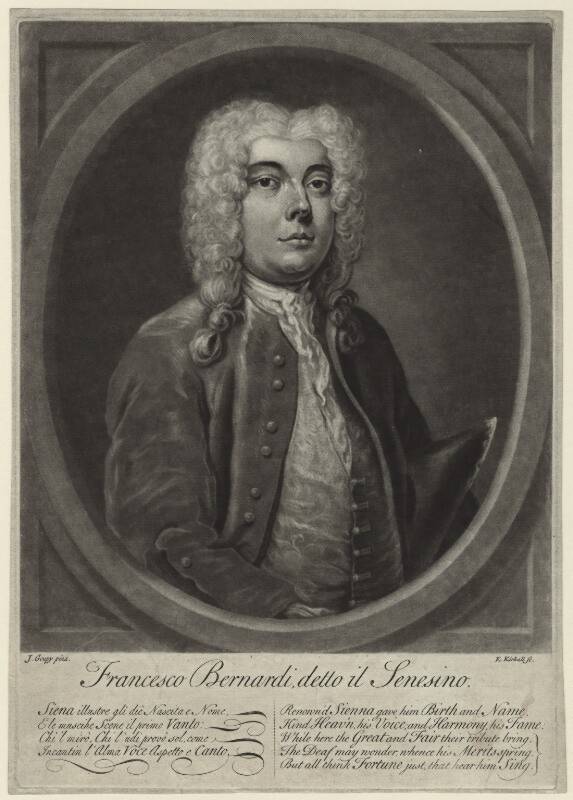
portrait of Senesino (Francesco Bernardi).
London, National Portrait Gallery NPG D31719
Senesino held out for the money so, as spokesman for the Academy,
Heidegger asked the Modenese representative in London, Guiseppe Riva,
who was a personal friend of Senesino’s, to mediate, which succeeded.
Riva wanted the Haymarket to become as Italian as it could possibly
be. He was probably also instrumental in getting Bononcini to come to
London.
Roberto Clerici, who had been working for the theatre in the
Haymarket, was appointed machinist and scene painter to the
Academy.
Radamisto
Handel’s first opera for the Royal Academy at the Haymarket was Radamisto, with a mixed English and Italian cast. It was first performed on April 27th, 1720, in the presence of the king and the crown prince (four days after they had been reconciled after a quarrel which had been going on since 1717). There was far more interest than there were tickets and, as many people without them managed to get in, a large number had to stand throughout the performance. The heat and lack of fresh air caused some to faint, but the performance was hailed with great enthousiasm.87
The original cast for Radamisto included Durastanti as Radamisto, but by the time of the first adapted revival at the end of December, Senesino had arrived in London and took over, Durastanti then taking the role of Zenobia. Handel’s bass Giuseppe Maria Boschi as Tiridate became the “roarer and blusterer of the Academy stage”.88
For the revival, Handel wrote new arias for Senesino, who was
judged by Rolli to be “well-mannered, well-read, extremely kind and
endowed with the noblest sentiments” but also “a noisy busybody and
certainly not the soul of discretion”.
Handel had brought in an assistant conductor and adaptor called
Polani, who was not appreciated by Senesino and there was a power
struggle which ended in Polani’s departure. So working with Senesino
started off with difficulties and his relationship with Handel was to
remain awkward.
The Librettists
The libretto of Radamisto was by Nicola Haym, one of the
Haymarket’s two theatre librettists (the other being Paolo Antonio
Rolli).
Haym was born in Rome, trained in the Ottoboni circle as a composer
and cellist. In England he served the Duke of Bedford and was a kind
of aesthetic advisor to dilettante noblemen. He was very sensitive as
to the balance between music and text, and Handel later collaborated
with him on i.a. Giulio Caesare, Tamerlano and
Rodelinda.
In general, the libretti by Haym were better, although Rolli was a
poet. Haym was basically a musician and that will have made working
with Handel easier, particularly in judging the singability of the
verse.
Rolli took a rather cynical view of libretti, which he called
“dramatic skeletons”. He didn’t like Handel either, whom he described
as “il Selvaggio”, the savage.89
Copies of the libretto, with an English translation included, were
bought as a matter of course by the audience, which had first become
accustomed to this in the 1690’s, when they could buy word-books for
Purcell’s operas. People saved these libretti. In the seventeenth
century, a new opera was a major event. Opera lovers went to several
performances.
Some libretti were set more than once, like Semele (Eccles and
Handel) and Siroe which was set five times (i.a. by Vivaldi
and Porpora).
Competition
That autumn, Giovanni Bononcini arrived. He was a Modenese, trained under Colonna and his opera Astarto was chosen to open the second Academy season. It was a great success, as a letter of the time attests:
I was last Wednesday at the opera called Astartus; it is a new one, and there is very fine musick in it. The stage was never so well served as it is now, there is not one indifferent voice, they are all Italians.90
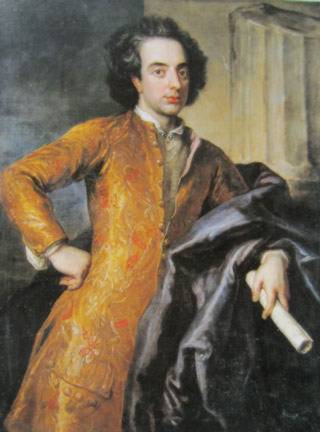
portrait of Giovanni Bononcini.
Berlin, Charlottenburg Palace.
Muzio Scevola followed in 1721. The directors of the Royal Academy decided that Handel and Bononcini should alternate as composers, but this led to quarreling between their fans.91 Act I was composed by ‘Pippo del Violoncello’, i.e. Filippo Amadei, formerly in Cardinal Ottoboni’s service, brought to London by the patron of the arts, Richard Boyle, third Earl of Burlington. Bononcini wrote Act II and Handel Act III; the libretto was by Paolo Rolli. According to Winton Dean, the plot is “an absurd gallimaufrey...” 92
Some say, compared to Bononcini,
That Mijnheer Handel’s but a Ninny;
Others aver that he to Handel
Is scarcely fit to hold a Candle.
Strange all this Difference should be
‘Twixt Tweedle-dum and Tweedle-dee
Epigram on the Feuds between Handel and Bononcini (1725).93
Courtiers writing about the event, described Muzio Scevola in terms of a kind of competition, which Handel won. Opening night, attended by the king, was particularly notable, due to the birth of a son to the Prince and Princess of Wales.
Francesca Cuzzoni
In the autumn of 1722 Francesca Cuzzoni came to join the
Academy.
The music critic Charles Burney was to write about her in 1789:
The composer and musicologist Johann Joachim Quantz, who heard her sing on his visit to London in 1727, wrote about her clarity of voice, purity of intonation, her double octave compass. He did add that “her figure was not advantageous for the stage”.95The art of conducting, sustaining, increasing and diminishing her tones by minute degrees acquired her, among professors, the title of complete mistress of her art. In a cantabile air, though the notes she added were few, she never lost a favourable opportunity of enriching the cantilena with all the refinements and embellishments of the time. Her shake was perfect, she had a creative fancy, and the power of occasionally accelerating and retarding the measure in the most artificial and able manner, by what the Italians call tempo rubato. 94
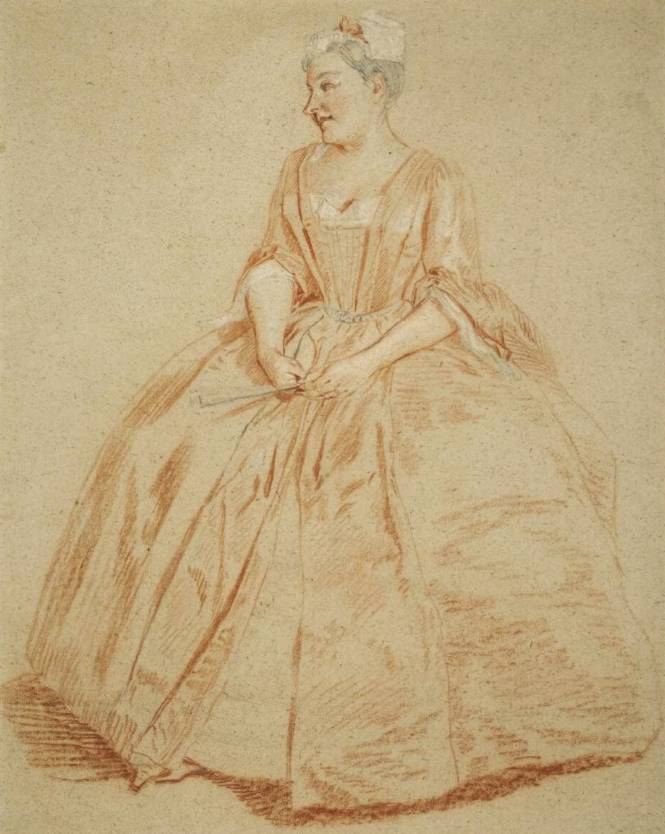
Portrait of Francesca Cuzzoni (?).
London, British Museum, 1895, 0915.953
Cuzzoni had been engaged for two seasons and a new opera was written for her, Ottone, based on the libretto of Lotti’s Teofane, in which she was to take the title role of Princess Teofane. Due to existing obligations and endless financial negotiations with the Academy 96 she didn’t arrive in London for rehearsals until October, so they had to open with revivals until she was ready to appear in January 1723.
The British Journal wrote ironically:
Seigniora Cutzoni is expected here with much impatience for the improvement of our opera performances; and as ‘tis said she far excells Seigniora Duristante, already with us, and all those she leaves in Italy behind her, much satisfaction may be expected by those who of later years have contributed largely to performances in this kind, for the great advantage of the publick and softening the manners of a rude British people.
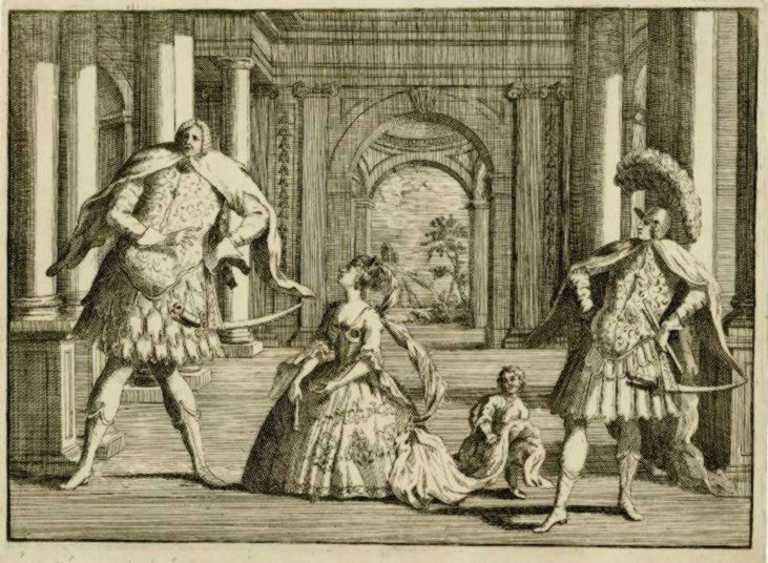
Berenstadt, Cuzzoni and Senesino. Satire on an opera, possibly Ariosto’s Coriolano, formerly thought to have been Handel’s Flavio, with the three Italian opera singers on the stage of the Haymarket.
London, British Museum, Cc. 2.28
Prima Donna Airs?
Ottone, Re di Germania was Cuzzoni’s introduction to London
and Handel gave her the leading female part, the Byzantine princess
Teofane. According to John Mainwaring, who in 1760 wrote the first
biography of Handel, there was a problem: the beautiful soprano aria
falsa imagine had only twenty-eight bars, however cunningly
written, and Cuzzoni refused to sing it in rehearsal. Handel was
furious. He grabbed her by the waist and shouted Madame, je sais
que vous êtes une véritable diablesse, mais je vous ferais savoir,
moi, que je suis Beelzebub, le chef des diables! He then
threatened to throw her out of the window.
Mainwaring’s story has been repeated innumerable times since. What he
failed to report was that Cuzzoni definitely had a point: the aria
had not been composed specifically for her - presumably due to lack
of time - although that was the custom at the time.97
In any case, she gave in and of course the London audience was highly
enthusiastic at the result. The London Journal of January 19th
1723 wrote: “His Majesty was at the Theatre in the Hay-market when
Seigniora Cotsani performed, for the first Time, to the Surprise and
Admiration of a numerous Audience, who are ever too fond of Foreign
Performers...” Spelling foreign names wrong in various ways was (and
is) one of the subtle methods by which part of the English press
exhibits its aversion to foreigners.
A footman in the gallery was, they say, moved to shout “Damme, she
has a nest of nightingales in her belly!”
The Royal Academy had performed Bononcini’s opera Griselda, again to great acclaim in the spring of 1722 and the rivalry between the supporters of the two composers became even stronger than before.
In 1723 the Academy was in financial trouble, although Handel
himself was doing well. At some time during the year he moved into a
beautiful house in Brook Street and a later inventory shows that he
had a large number of household goods including two harpsichords, one
a Ruckers, possibly the one still on show at Fenton House in London.
In the twelve months between February 1724 and 1725, Handel composed
Giulio Caesare, Tamerlano and Rodelinda.
Astianatte was Bononcini’s only opera for the Academy after
1724, the year in which he was engaged by the second Duchess of
Marlborough, Lady Henrietta Godolphin.
Tamerlano
Traditionally, on November 4th Nicholas Rowe’s play
Tamerlane was performed, often at several theatres at once, to
commemorate William III’s landing at Torbay on that date in 1688. It
was also William’s birthday.
Just before the November 1724 productions in Lincoln’s Inn Fields and
Drury Lane, on October 31st, Handel’s opera Tamerlano
premiered at the Royal Academy at the Haymarket.98
A coincidence? Winton Dean 99 thinks it
is, as the dates do not quite fit. But that was because the days
reserved for opera were Tuesday and Saturday. The revival was to take
place in 1731, again in November, and again not on the 4th but nine
days later, on Saturday the 13th. It seems clear that increased
interest in the Tamerlano story in November was the key, in spite of
the fact that Haym and Handel depict Tamerlano in a manner unsuitable
for identifying him with William III. In the opera, it is his
opponent Bajazet who is the epitome of perseverance.
Star Status: Honoured and Reviled
By this time London was totally opera mad, the stars were just as important as popular movie and tv stars are now and gossip was just as prevalent. Subscriptions to Rodelinda 100 sold very well and Charles Burney wrote: “On her [Cuzzoni] appearing in this opera [Rodelinda] in a brown silk gown, trimmed with silver, with the vulgarity and indecorum of which all the old ladies were much scandalised, the young adopted it as a fashion, so universally, that it seemed a national uniform for youth and beauty.”101
Not everybody was pleased at the opera mania: it was perceived as pop culture, not high art and satirised accordingly by Hogarth.
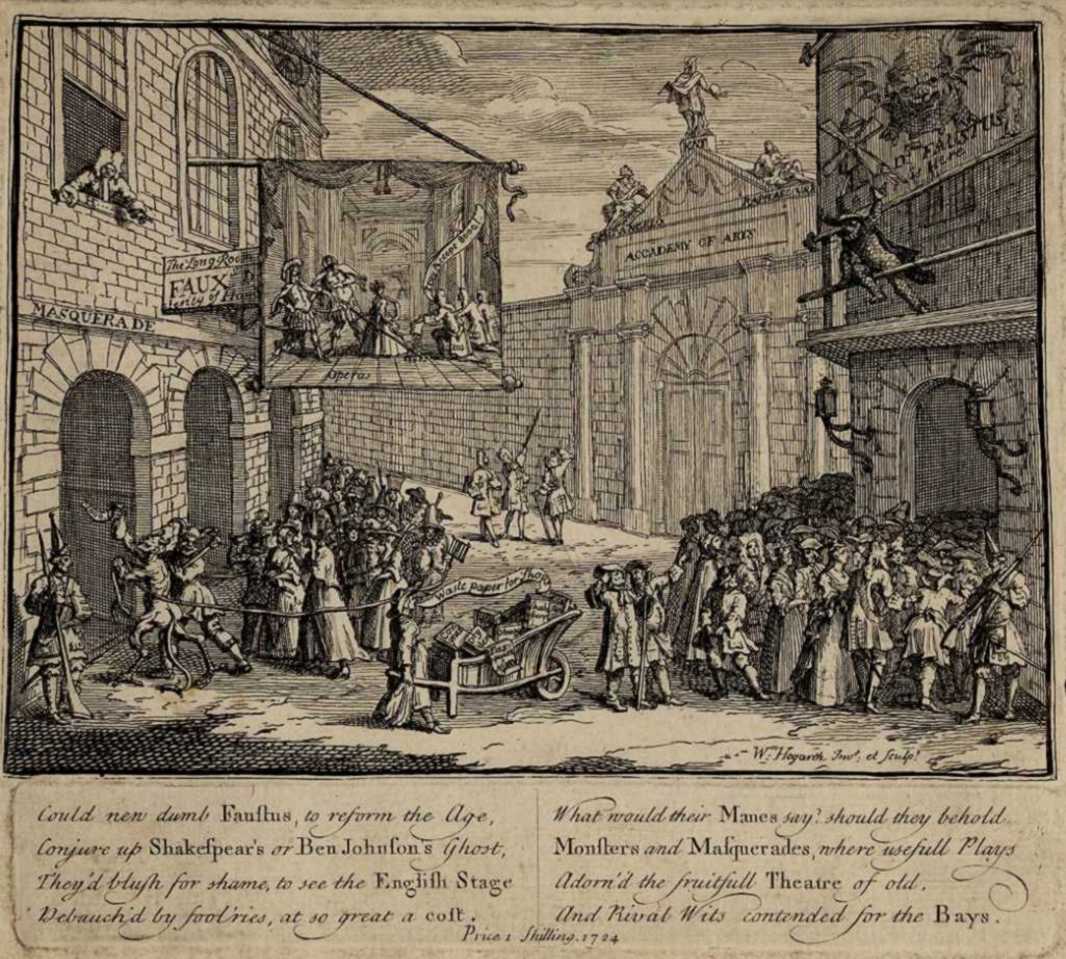
Masquerades and Operas.
London, British Museum 1857,0509.13
“Bad Taste of the Town”, his first satirical print published by himself, described by the British Museum as:
A composite street scene with a theatre on either side and an “Academy of Arts” [Lord Burlington's recently remodelled house in Piccadilly] beyond; on the left, a fool and a devil are leading a crowd of masqueraders into the Opera House in the Haymarket from which hangs a banner advertising an opera [based on his earlier print BMSat1768] with the singers Cuzzoni, Senesino and Berenstadt and a sign for “Dr. Faux's [Isaac Fawkes] Dexterity of Hand”, the impressario John James Heidegger leans from an upper window; on the right, a crowd is flocking to see the pantomime “Dr Faustus” in the centre, a woman pushes a wheelbarrow of waste paper including volumes of Congreve, Dryden, Otway, Shakespeare and Addison; the gate of the Academy beyond is topped with statues of Michelangelo, Raphael and William Kent,102 admired by three gentlemen.
Faustina Bordoni
Margherita Durastanti, who had been the principal soprano of the
Royal Academy from 1720 until Cuzzoni’s arrival, gave up after a year
and left for Italy at the end of the 1723-24 season.
For the two following seasons, Cuzzoni shared the spotlight only with
the (mezzo-soprano) castrato Senesino. But then the Academy directors
decided to balance the vocal ensemble by engaging a second soprano.
They asked Faustina Bordoni, whom they had been wanting to engage for
quite a while, partly on the recommendation of Owen Swiney, who was
by then in Italy and acting as the representative of the Academy.
This daughter of the Venetian nobility born in 1697, about a year
after Cuzzoni, was engaged in 1725. She was a protegée of Alessandro
and Benedetto Marcello, made her debut at the age of sixteen and was
an immediate hit. Princes and ambassadors showered gifts on her.

portrait of Faustina Bordoni.
London, Handel House Museum.
Like Cuzzoni she was small, but unlike her, both beautiful and an
excellent actress. She was famous for her sustained notes, having
perfect breath control, fine trills and excellent diction. The two
sopranos had known one another since at least 1718, when they
performed in Venice.103
Like Cuzzoni before her, Faustina didn’t arrive until the season was
almost over.
The opera Handel wrote for his stable of stars was Alessandro, which features incidents from the life of Alexander the Great and a love interest for the hero (Senesino) and two Indian princesses (Cuzzoni and Faustina). The staging included an unusual number of scenic effects, with a Temple of Jupiter Ammon and several battle scenes, among which the opening scene of the first act, which took place at a breach in a city wall. (In the heat of battle, Senesino skewered a piece of papier mâché wall with his sword.) 104 The noise of the battle scenes could be heard as far as Charing Cross.
The music the rival princesses in the opera are given shows that Handel was aware of their open rivalry from the start: After the stage direction “each one emerging from her pavilion”, they sing by turns, solo passages of exactly the same length.
Alessandro, the premiere of which had to be postponed until May, when Faustina finally turned up, was very popular; there were eleven performances in May and two more in June, the season’s final performances being cancelled due to Senesino’s absence. The town hummed with tales of the sopranos’ mutual animosity.
Meanwhile, at Lincoln’s Inn Fields, Rich responded to the call for opera in English (by Defoe in Augusta Triumphans, among others) by presenting a revival of Camilla on November 26th 1726, now sung entirely in English. It had a new prologue:
While Senesino you expect in vain,
and see your favours treated with disdain:
While ‘twixt his Rival Queens such mutual Hate
Threats hourly ruin to your tuneful State,
Permit your country’s voices to repair,
In some degree, your disappointments there.
On January 7th 1727, Senesino was back and performed in Ariosti’s Lucio Vero with Cuzzoni and Faustina. The trio also performed in Handel’s Admeto towards the end of the month. “The House filled every night fuller than ever was known at any Opera for so long together - 16 times”, according to Colman’s Opera Register. Faustina’s arrival had profited the Academy, but by and large it had been a bad season, with far fewer performances than usual, as the result of Senesino’s long absence.
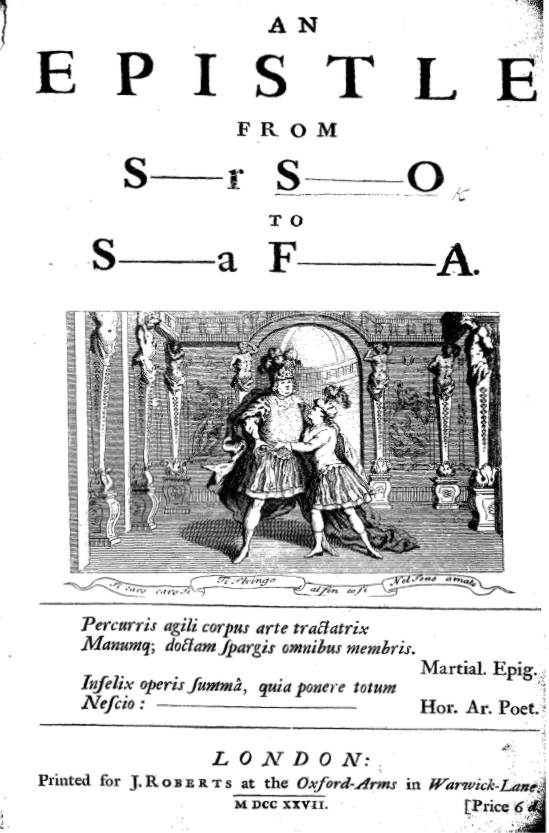
Yes, my Life, my loveliest Dear,According to the Epistle, Senesino answered:
Thus I grasp and clasp thee here,
Close to my panting Heart.
In vain you lavish thus your Stock of Charms,The eight-page pamphlet is one in a series of obscene parodies satirising the Italian opera and particularly the castratos.105
I droop my Head, and freeze within your Arms;
O that your Heat could alter Nature’s Law!
And bless what’s frozen with a kindly Thaw...
Handel petitioned to be naturalised: the request was granted by the House of Lords and the Commons in record time and was honoured a week later.
At the same time, the battle between the Rival Queens and their factions was getting more heated:
At Leicester Fields I give my vote
for the fine-piped Cuzzoni;
At Burlington’s I change my note,
Faustina for my money.Attilio’s Musick I despise,
For none can please but Handel
But the Disputes that hence arise,
I wish and hope may end well.
wrote the poet Henry Carey.106
The struggle was not only personal and musical, but political as
well. Mary, Countess of Pembroke, was the leader of the Cuzzoni
faction. When Cuzzoni received a warning that there was a disturbance
planned for her forthcoming performance, she decided not to perform
at all, but was positively ordered to do so and to remain until the
end, by Lady Pembroke. Cuzzoni stayed, although one of her arias was
entirely drowned out by catcalls from the Faustina claque.
King George warned the directors that if Cuzzoni were dismissed, he
would withdraw his patronage. Lady Burlington and Lady Cowper backed
Faustina and the wife of the first minister, Robert Walpole decided
to invite both divas to a party at her house, asking them to sing. Of
course neither would do this with the other around, so she had each
singer taken to another part of her mansion “on the pretense of
showing her some curious china” while the other performed, according
to her son, Horace Walpole.107
From May 6th on, Cuzzoni and Faustina appeared in Bononcini’s
Astianatte and in that month relations between the two divas
worsened to such an extent that they went for each other on stage,
during the performance on June 6th, egged on by their supporters.
The British Journal reported on the affair on June 10th,
1727:
On Tuesday-night last, a great disturbance happened at the Opera, occasioned by the Partizans of the Two Celebrated Rival Ladies, Cuzzoni and Faustina. The contention at first was only carried on by Hissing on one side and Clapping on the other; but proceeding at length to Catcalls, and other greater Indecencies. And notwithstanding the Princess Caroline was present, no Regards were of Force to restrain the Rudeness of the opponents.
The Coronation of George II
Five days later, the town had something else to think about:
George I, in Osnabruck at the time, had died. Handel was commissioned
to write four new anthems for the coronation at Westminster Abbey of
the Prince and Princess of Wales as George II and Queen Caroline:
My Heart is Enditing, The King Shall Rejoice, Let Thy Hand be
Strengthened and Zadok the Priest.
There was an orchestra of 160 and the Chapel Royal was reinforced
with additional voices, bringing the total number up to forty-seven,
standing in tiers.
The Academy fell on hard times. There were successes, but they
were spending too much. The orchestra consisted at that time of
twenty-four violins, led by the Castrucci brothers, a lute, three
cellos, two double basses, three bassoons and “sometimes trumpets and
flutes”, flutes meaning traversos.108 The continuo consisted in two harpsichords, one
played by the composer, and a lute, assisted by a cello for the
recitatives. Added to the cost of the regular singers, the scenic
designs and costumes, not to mention the exorbitant amount of money
for the Italian virtuosi, the subscriptions, even with the king’s
yearly subsidy, couldn’t cover it all.
Bononcini went off again, followed by Senesino and Cuzzoni..
The Second Academy
At the end of May 1728 there was a general meeting of the Royal
Academy shareholders to discuss suggestions for continuing to produce
the operas. A period of uncertainty followed, with no performances
for a time.
In October The London Evening Post announced that Senesino,
Faustina and other Italian singers had agreed to return to England
soon.
In January 1729 it was decided that Heidegger and Handel should carry
on for five more years,109 the
Academy lending them the scenery, machines, costumes, instruments and
so on. They were clearly given a free hand. This continuation of the
Royal Academy is often called the Second Academy.
Handel, accompanied by three of the subscribers, went off to Italy to
engage new singers.110 He tried in
vain to approach Farinelli, who refused to go to England for fear
that the climate would be bad for his voice.
The premiere of Lotario, in December 1729, had a whole new group of soloists: Bernacchi, Strada, Merighi, Bertolli, Fabri and Riemschneider. In succeeding years, Partenope, Scipione, Poro, Rodelinda, Ezio and Sosarme followed, as well as revivals of earlier works. Of the new operas, Sosarme did relatively well with eleven performances; Ezio only had five.
Oratorio
In February 1732, during Lent, a private performance of the oratorio Esther took place at Cannons. It was based on a masque composed by Handel for Cannons in 1718. In the same month, Esther was performed in London by members of the Chapel Royal, in a concert hall at the Crown & Anchor tavern on the Strand, presumably in the presence of Handel, whose birthday it was; a tribute. Esther was repeated twice in March, for the Philharmonic Society and for the Academy of Ancient Music. The conductor was Bernard Gates, director of the boys of the Chapel Royal. The role of Esther was sung by Master Randall, a boy soprano, and two other choristers took smaller parts.
On April 20th, an unauthorised performance took place in another London concert hall. Handel had been planning to present a revised and enhanced version on his own territory, the Haymarket, greatly augmented and taking advantage of the success of his coronation hymns of five years previously. He was encouraged in this design by members of the royal family.
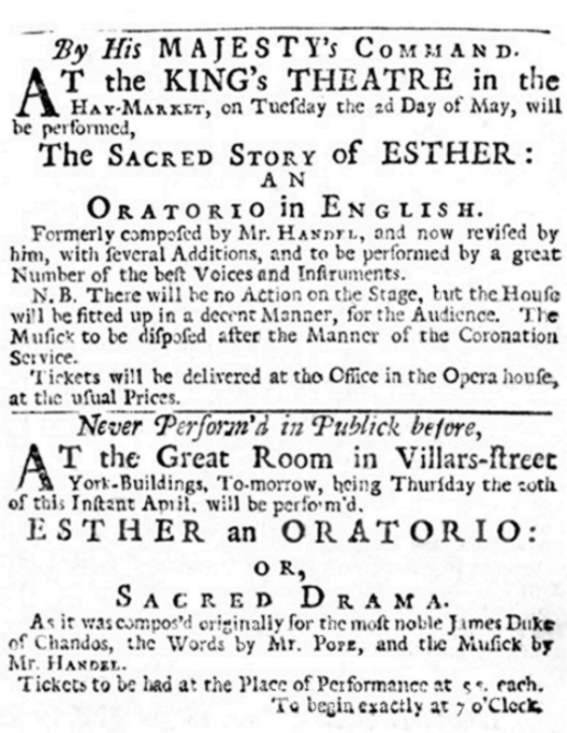
To Stage or Not to Stage?
The addition of the words “There will be no Action on the Stage“
seems superfluous when referring to an oratorio, but made sense at
the time. In contrast to the continent, oratorios in England had been
performed like operas until then, with scenery and costumes.
According to Burney, Handel was pressured into abandoning the
staging, but Deutsch 112 writes that
there is no evidence for this. Nevertheless, there was serious
opposition to the practice in clerical circles, from Edmond Gibson,
Bishop of London in particular. Gibson, a Whig, tried, like many
before and after him, to reconcile the interests of church and
state.
The entire matter of the Protestant succession was still current. The
ruling monarch was and is the head of the Anglican church: the
“Defender of the Faith”. That was the reason the Hanovers were ruling
England in the first place, so a matter of great significance. Gibson
was a conservative man: he had opposed Heidegger’s masquerades,
racing on Sundays, clubs for homosexuals, drunkenness and
prostitution. The intimate involvement of the royal family with opera
was anathema to him.
Handel presented the oratorio with three English soloists and four of
his Italian opera singers: Senesino, Montagnana, Strada and Bertolli.
“... Senesino and Bertolli made rare work with the
English Tongue you would have sworn it had been Welch;” [sic] 113
I’m English born and love a grumbling noise.
The stage should yield the solemn organ’s note,
and Scripture tremble in the Eunuch’s throat.
Let Senesino sing what David writ,
and Hallelujahs charm the pious pit...
from: James Bramston, The Man of Taste, 1733
Esther was received with great enthousiasm in a theatre crammed to the rafters and in the presence of the royal family. Six more performances followed and royalty was present at at least three of them.
The End of the Second Academy
At the end of the 1731-32 season, Handel’s Acis & Galatea
was performed on a Saturday night, which was usually reserved for
opera. It was called a serenata, sung partly in English and partly in
Italian and based on the
1708 cantata and the 1718 masque. The leading roles were sung by
Senesino and Strada,114 two smaller
parts by English singers.
Three more performances took place that month, after which the
Haymarket remained closed until the opera Catone premiered on
November 4th. The libretto was by Metastasio and the music probably
by Leonardo Leo. Orlando followed in January 1733, a new
Handel opera with Senesino in the eponymous role. That was the final
series of performances by Senesino for the Second Academy, which
wasn’t to continue much longer either.
Arianna in Creta, which was presented on January 26th 1734,
was Handel’s last opera for the Haymarket for several years and, with
thirteen performances, the most successful Second Academy opera.
The final performance took place in July 1734 and by August Handel
was already negotiating with John Rich for the production of opera in
Covent Garden.
The Other Theatres
We have to go back in time now, for a look at the other London theatres. What happened there was very relevant to the fate of the Second Academy and Italian opera.
The Rich brothers had managed to keep the theatre in Lincoln’s Inn Fields afloat throughout the twenties, in spite of all the financial problems. Apart from the successful Harlequinades, to which songs had been added, plays by Shakespeare (often adapted ones) not yet seen in Drury Lane were performed there and in 1722 an agreement was reached with the Drury Lane directors to stop trying to steal each other’s players.
On November 28th 1724, Dioclesian was revived at Lincoln’s
Inn Fields, but with newly composed music by Pepusch 115 instead of Purcell’s. How much of the celebration
of William III was retained from the original 1690 production is a
moot point. Did orange trees still appear on the stage? Betterton’s
text, which had been attributed to him earlier, was now deemed to be
Dryden’s.
Camilla, sung in English, was also revived there in 1726.
The Beggar’s Opera
Towards the end of 1727, just after the coronation of George II,
Lincoln’s Inn Fields was in trouble again. After Colley Cibber, then
managing Drury Lane, had refused it, John Rich decided to put on a
strange “ballad opera” with a text by John Gay and an overture by
Pepusch at Lincoln’s Inn Fields.
The premiere of The Beggar’s Opera took place in January
1728:
Brittons attend- view this harmonious Stage
And listen to these notes which charm the age.
Thus shall your tastes in Sounds and Sense be shown
and Beggar’s Op’ras ever be your own.

Tate N02437
One of the many by-products of this successful collaboration was Hogarth’s painting, of which there are several versions. There are members of the public on the stage, but this isn’t an actual observation of what he saw, it is symbolic.
Among the public are John Rich and John Gay, who is standing at the bottom of the staircase.
This Newgate Pastoral “made Gay rich and Rich gay” as the saying
went. The piece not only satirised Italian opera (although Polly and
Lucy, competing for Macheath, were certainly rival divas) but it was
also seen as veiled criticism of the government. All this and the use
of English words to recognizable English melodies in recognisably
English surroundings enchanted London.
The political satire had been duly noted, however, and Gay’s sequel,
Polly was suppressed. Although Walpole has often been accused
of pursuing a personal vendetta against him, it should be noted that
Gay retained his post as commissioner of the lottery.
The Beggar’s Opera achieved sixty-two performances in
Lincoln’s Inn Fields. The large amount of spoken text establishes the
work as the first link between seventeenth-century semi-opera and the
twentieth-century musical.
The Little Theatre in the Hay
A new theatre, known as the Theatre Royal in the Haymarket,116 diagonally across the Haymarket from the King’s, opened in December 1720. It was initially the home of The French Comedians of His Grace the Duke of Montague. Later on, other foreign and new English companies performed there, but they were clearly no threat to the established companies. It played no part in opera history until 1728, when The Beggar’s Opera was revived there immediately following the successful run at Lincoln’s Inn Fields, with sixteen performances at the Little Theatre, now combined with tightrope walking and acrobatics.
In March 1732 Amelia also premiered there, an
English-language opera “in Italian style”117 with a libretto by Henry Carey and music by John
Frederick Lampe,118 presented by a
troupe of previously unknown singers which called itself the English
Opera Company and had been founded that year. The success of The
Beggar’s Opera undoubtedly played a part in this initiative.
Amelia was performed nine more times in the following months
which was a reasonable success, especially for an unknown company,
even though the theatre was quite small.
In May the company performed an unauthorised version of Handel’s
Acis & Galatea with English singers, among whom Miss Arne,
“With all the Grand Chorus’s, Scenes, Machines and other Decorations,
being the first Time it ever was performed in a Theatrical Way.” That
was just three weeks before the production (referred to earlier)
which Handel was due to present with his own company across the way
where scenery and costumes were used, but there was no Action on the
stage.
Britannia
On November 16th 1732, the English Opera Company presented Britannia, libretto by Thomas Lediard and music again by Lampe. Exceptionally, a picture of the scenery has survived. If it is accurate, the production was on a grand scale, in spite of the small dimensions of the “little” theatre. The scenery is reminiscent of the high point of baroque staging in the second half of the seventeenth century. There were also “completely new” lighting effects: transparent columns of the Corinthian order, decorated with leaves, flowers, garlands and other ornaments. Each of these columns was fronted by a pedestal, on which stood a pyramid lit from inside.
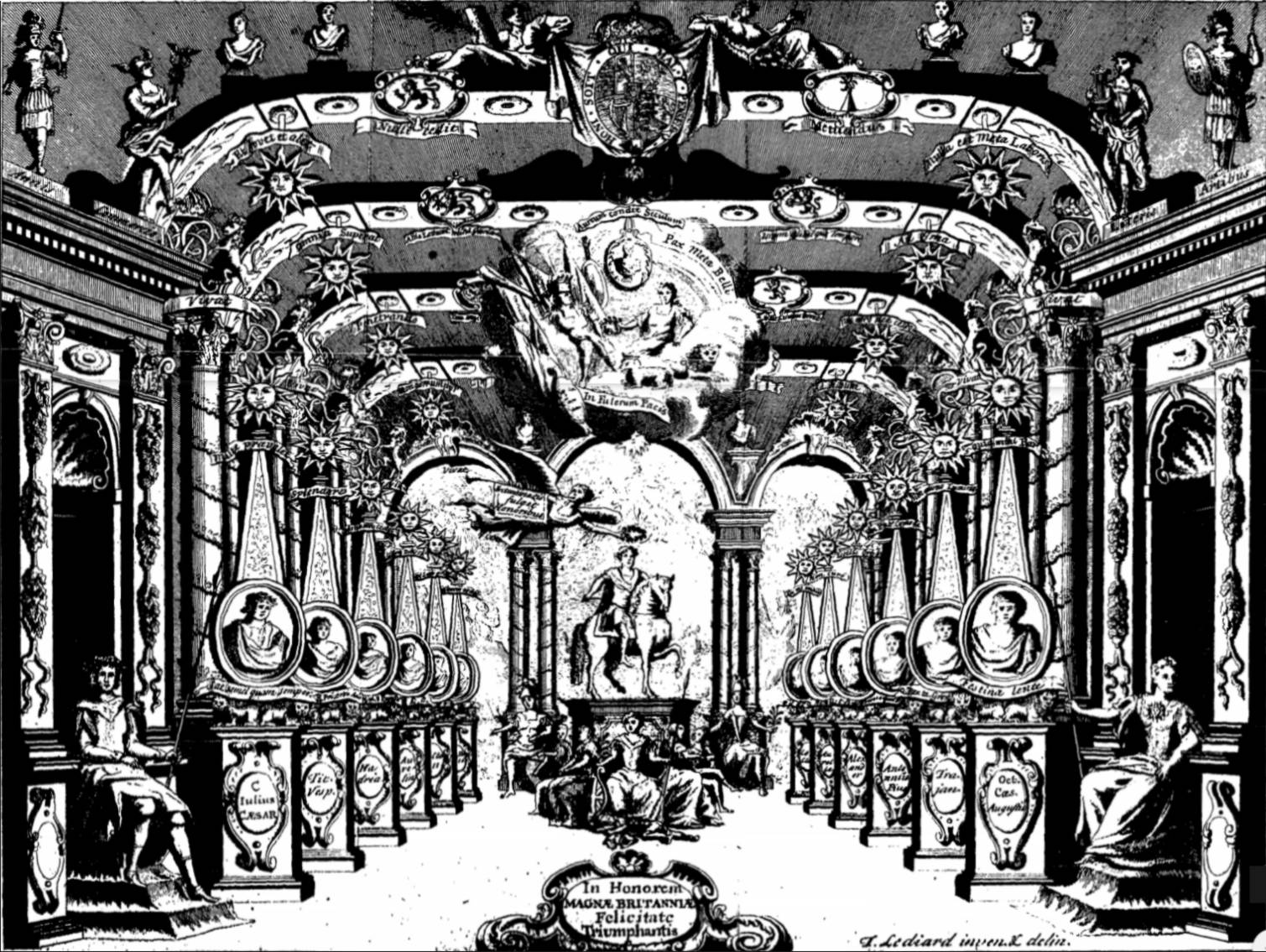
London, British Library.119
The story was an unabashed celebration of the monarchy, similar to the prologues perpetually attached to the series of lyric tragedies written by Lully and Quinault between 1673 and 1686, but that was in another country and in different times. The 1732 British audience reacted as one would expect: there were only three more performances.120
Goodman’s Fields
The success of The Beggar led not only to the composition of more ballad operas - which appeared by the dozen - but also inspired new theatre proprietors to try their luck. Thomas Odell opened a temporary theatre in Goodman’s Fields in 1729, but was forced by strong opposition to close again a few months later.link to Patents page
He gave up and at the beginning of the 1731-32 season he handed over control to the actor Henry Giffard. Giffard persevered and opened a subscription for a new theatre to be built in Ayliffe Street, Goodman’s Fields. It was designed by Edward Shepherd, the architect of the theatre then under construction in Covent Garden. Goodman’s Fields opened on October 2nd 1732.
Covent Garden
The opening of Covent Garden followed on December 7th. John Rich, the director of Lincoln’s Inn Fields, had built the new theatre at the top of Bow Street, not far from his theatre in Lincoln´s Inn Fields and on the same plan. The decorations in Shepherd’s structure were made by the Venetian Amigoni.
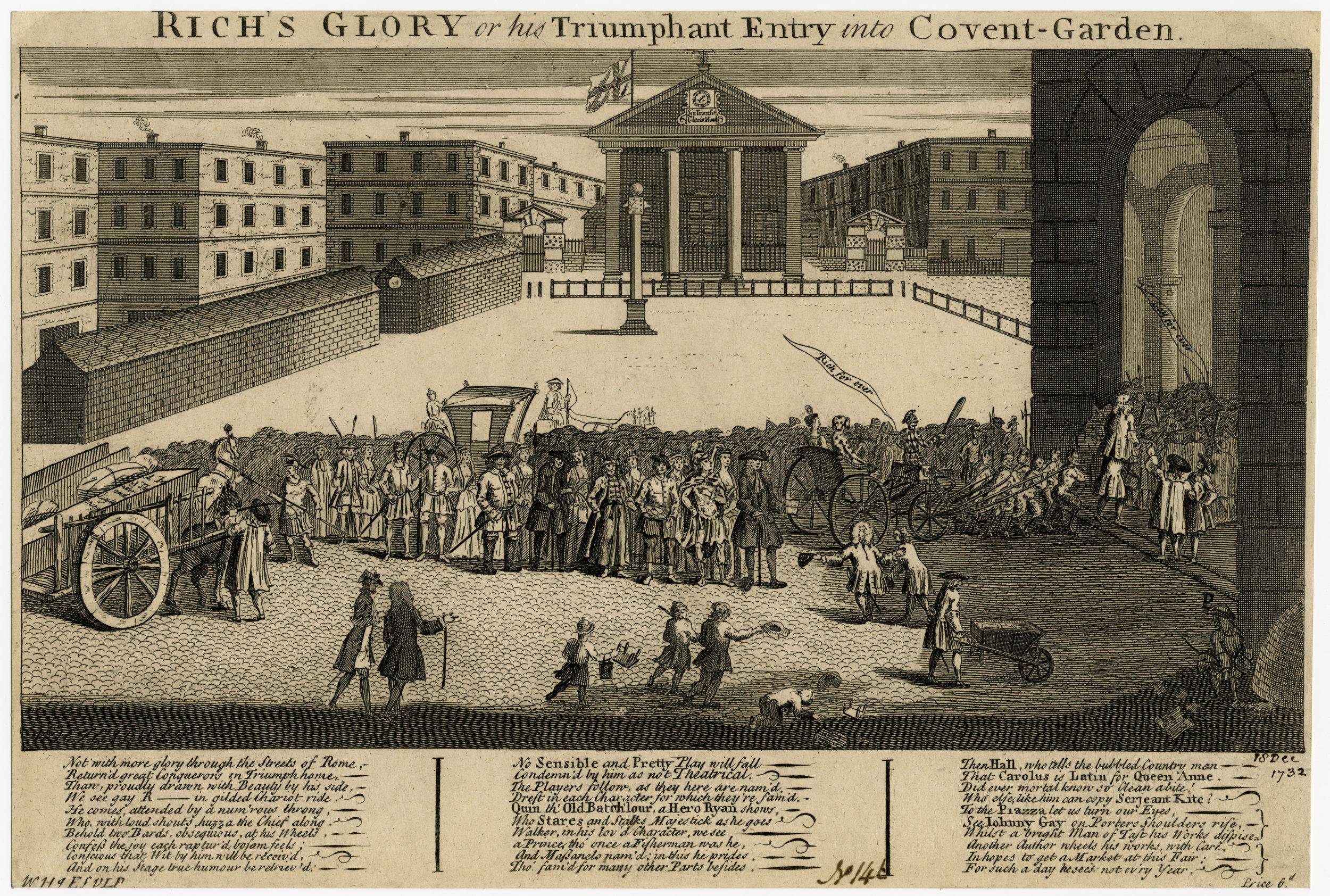
Rich’s triumphant entry in Covent Garden.
British Museum, 1868,0808.3549
The satirical print shows Gay being carried, Rich in a golden coach, the players in costume and many others, all going through Covent Garden to the new theatre.
Rich was convinced that opera required not only words and music, but also machines, scenery and dance 121 (something modern stage directors might do well to remember before plunging into baroque opera). This made Rich a butt for satire, but proved most successful.
That same month, another theatre opened in Southwark. Clearly the
London theatre world was changing drastically: physically, due to the
increasing number of theatres, but also socially and politically. The
theatre was liberating itself from the stranglehold of church and
state. It had proved possible to open a theatre without having a
patent; social criticism was expressed on stage and it was no longer
self-evident that theatres closed for Lent concerts had been allowed
for quite a while by then).
The Second Academy’s Italian opera was perceived more and more as a
plaything of the aristocracy and the aristocrats were getting more
and more irritated by Handel’s dominance.
English Opera, Italian Style
The number of initiatives for presenting English-language music theatre were increasing. Handel and Heidegger, with their Italian company, were limited in their efforts to take advantage of this, but presenting Deborah and the part-English version of Acis and Galatea can be seen as vague efforts in that direction. Deborah was performed by five Italian and four English singers on March 17th. The Italian singers were not pleased.
Judith: an Oratorio by Willem Defesch
On February 16th, one month before the performance of Deborah, the English-language biblical oratorio Judith was performed at Lincoln’s Inn Fields. It was composed by Willem de Fesch, a Dutchman living in England,122 with a libretto by William Huggins, which has come down to us; the score has been lost.
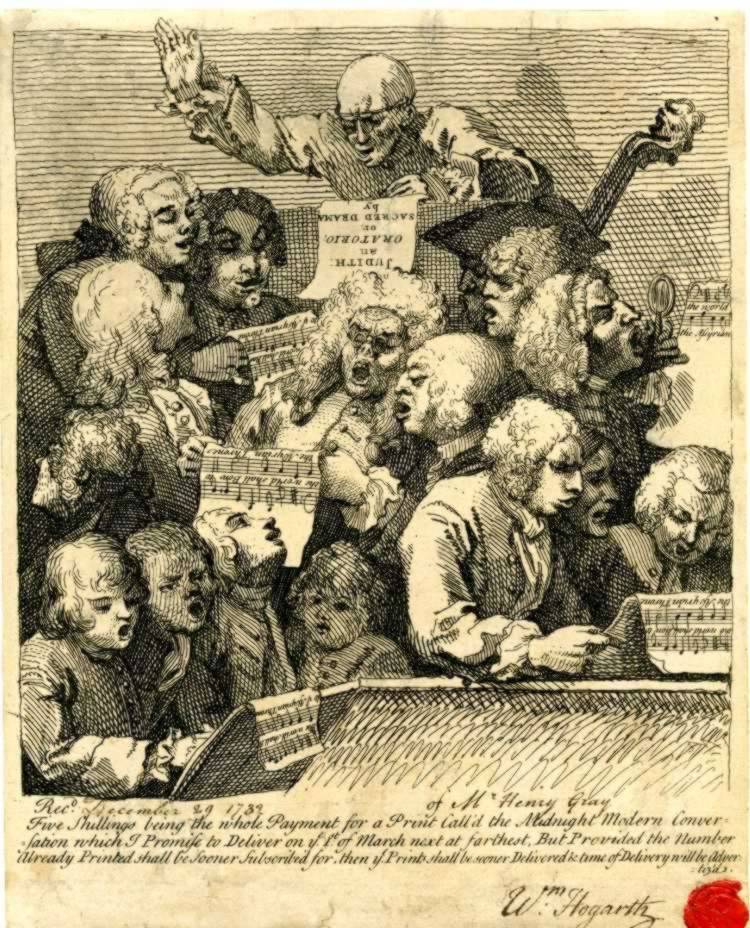
The score has been lost, except for the bit Hogarth preserved in this etching.
In his Hogarth Illustrated (1791) John Ireland states that the performance was staged. He offers no source, but the 1733 libretto has extensive stage directions. According to Ireland, Huggins gave a copy of the libretto, which was for sale before the performance,123 to the Duke of Chandos, who supported the production financially.124 William Hogarth, a friend of Huggins’, illustrated the title page and also made a drawing of a rehearsal of Judith. There was only one performance.
The Opera of the Nobility
Animosity towards Handel was still increasing and his detractors
founded the Opera of the Nobility in 1733, at a point where it must
have been clear to everybody that the Italian opera was in
difficulties - in spite of the royal subsidy - and that there would
certainly be no room for two companies. So from the beginning, the
founders must have intended to supersede the Royal Academy and to
prove that they could do better. They underestimated the difficulties.
A number of the directors had formerly supported the Royal Academy
and now joined in this new venture in Lincoln’s Inn Fields, which had
become available after Rich had moved to Covent Garden. It was a
mixed gathering, that first meeting on June 15th. The Dukes of
Richmond and Rutland were government supporters, but Bedford was an
opposition Whig and Lord Bathurst was a Tory. Many of the people who
subscribed to the new opera were anti-Walpole; there was always a
political side to this kind of seemingly artistic conflict, and even
a personal one. Senesino and several other singers defected to the
Nobility.
The royal family had supported Handel through thick and thin, both
financially and morally, several of its members being present at many
performances, sometimes including Frederick, Prince of Wales, who now
constituted himself the main sponsor of the new opera company,
thereby re-establishing a family tradition: anything of which the
king was in favour, the Prince of Wales was against. He nevertheless
continued to support Handel financially.125
Farinelli
Owen Swiney, back in England, was asked to help find suitable
singers and Nicola Porpora, who represented the newer trends in
music, became the director. He is also known to us as the teacher of
the young Joseph Haydn. Musically, the baroque period was beginning
to wane.
Senesino sang for the Opera of the Nobility, as did Cuzzoni, and what
Handel had failed to achieve was now brought about: Porpora’s student
Carlo Broschi, known as Farinelli, overcame his fear of the English
weather and joined the company.
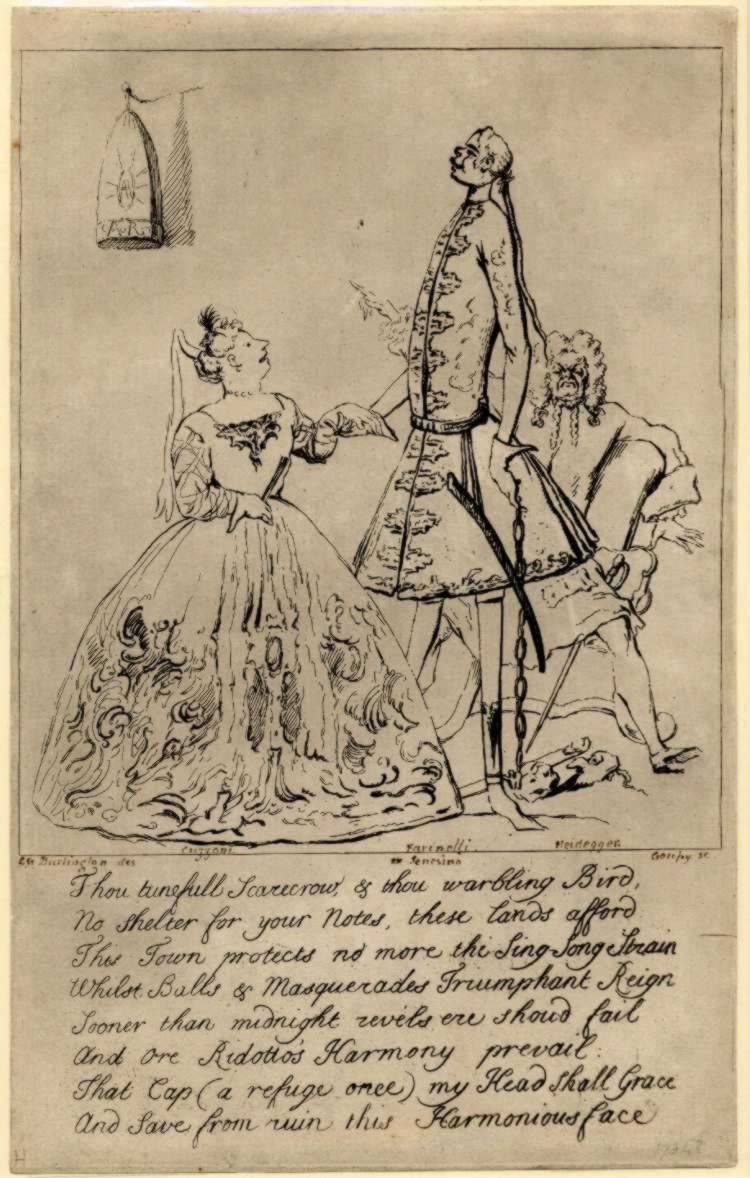
Royal Collection Trust, RCIN 907292
Thou tunefull Scarecrow, & thou warbling Bird,
No Shelter for your Notes, these lands afford
This Town protects no more the Sing Song Strain
Whilst Balls and Masquerades Triumphant Reign
Sooner than midnight revels ere should fail
And ore Ridotto’s Harmony prevail,
That cap (a refuge once) my Head shall Grace
And save from ruin this Harmonious face
The situation was serious, although the royal family (apart from the Prince of Wales) acted as though they took it lightly. The Princess Royal said that she soon expected to see half the House of Lords playing in the orchestra in robes and coronets and the King declared that he didn’t consider it a very honourable occupation for a person of quality to set oneself at the head of a faction of fiddlers. Farinelli came in for the worst of the insults.
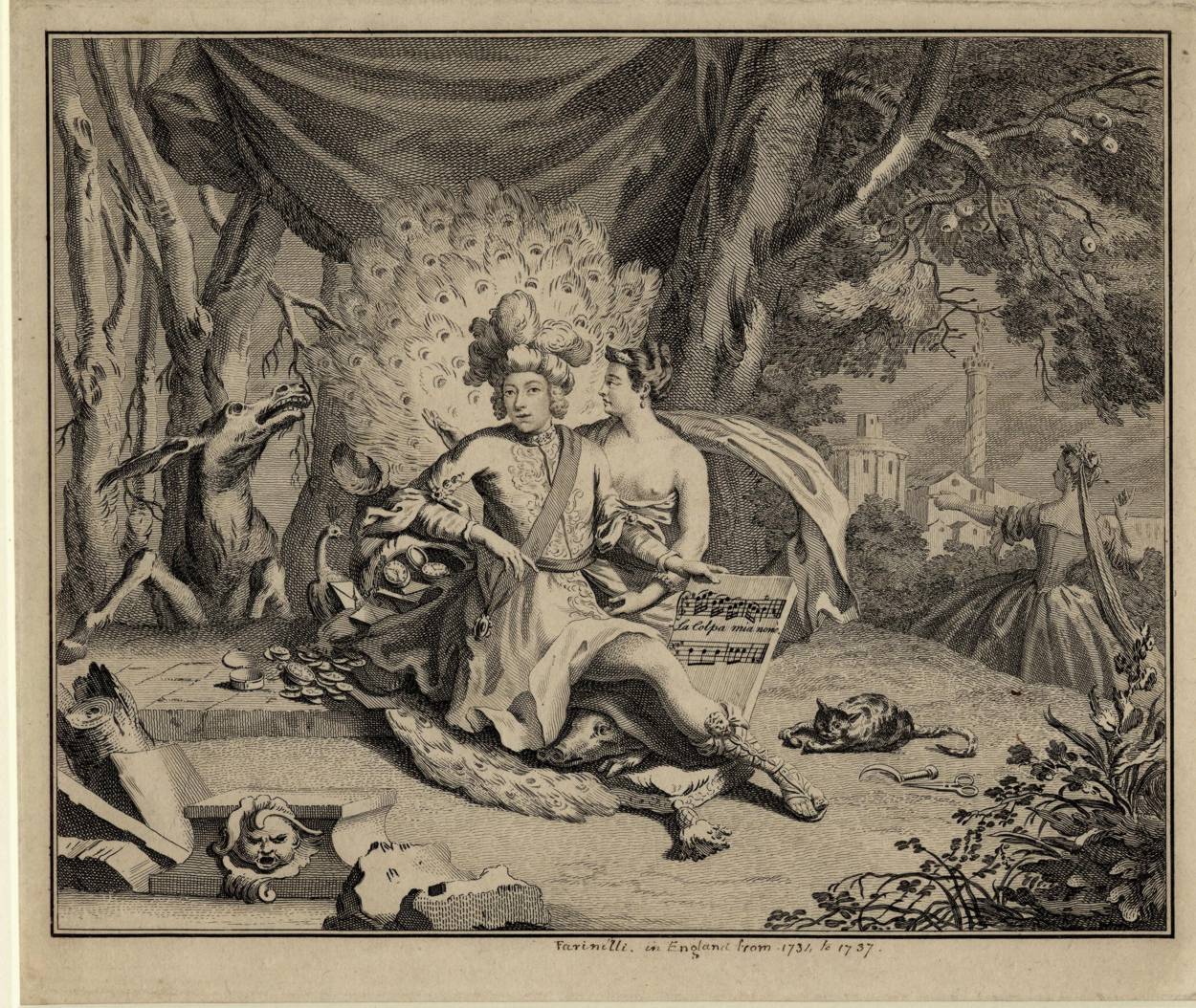
A castrato is leaning against a cornucopia full of gifts from admirers, a donkey is braying, the peacock is an allusion to vanity. The Muse is holding a part of his anatomy which is very small and her other hand indicates this. The cat is playing with the bits missing from the singer, who is holding a score with the Italian words meaning “It isn’t my fault.”
London, British Museum, 1868,0808.3587
It was long assumed that the singer represents Farinelli. The British Museum reports a letter by Thomas McGeary of February 25th 1993 in which the author points out the striking resemblance to a portrait of Angelo Maria Monticelli in the V&A museum S.6291-2009
The first season (1733-34) of the Opera of the Nobility opened in Lincoln’s Inn Fields with Porpora and Rolli’s Arianna in Naxos on December 29th 1733. Senesino took the role of Teseo, Cuzzoni (who had returned in April) sang Arianna. Four of the twenty-two performances in that season coincided, not by accident, with Handel’s Arianna in Creta which premiered four weeks later and ran for sixteen performances. It was a promising start to the season for both companies.
A Royal Wedding
Anne, the Princess Royal, married Stadholder Willem IV, Prince of Orange. She was a pupil of Handel’s and his serenata Parnasso in Feste (Apollo and the Muses celebrating the wedding of Peleus and Thetis) was performed to great acclaim on March 13th 1734, just prior to the wedding, at the King’s Theatre in the Haymarket. The royal family was there in force, including both the Prince of Wales and the Prince of Orange. Most of the music had been recycled from Athalia with the finale including a solo by Carestini, the new castrato, as Apollo.
The 1733-34 Academy season which had begun so well, ended in the red. Heidegger remained the director of the Haymarket after the five-year period granted to him and Handel by the Second Academy. At the end of July, Handel left for Tumbridge Wells to take the waters. By late August he was back in London.
Handel to Covent Garden...
A letter he wrote on the 27th tells us that he was then
negotiating with John Rich about henceforth mounting his operas in
Covent Garden.126
King George,
always loyal to Handel, saw to it that the year’s thousand-pound
bounty went not to Heidegger and the Haymarket, but directly to
Handel.
Covent Garden Theatre had been built after the example of
Lincoln’s Inn Fields and had about the same capacity, but it was
eighteen years younger and must have had more up-to-date equipment.
What moved Rich to throw in his lot with Handel is not quite clear.
Rich patronised the Italian opera himself 127 and was certainly not opposed to it, but he was
also enough of a businessman not to open the door to a form of
entertainment which up till then had led to financial losses. He had
seen that the singers’ enormous salaries were paid at the expense of
attractive staging, which he considered indispensable for successful
theatre. He had never yet produced opera, although he had strong
opinions about it. Perhaps he was itching to try his hand at it and
make improvements? Ballet, for instance, with which he was very
successful, but which was almost never seen at the Academy. Rich had
a small chorus, too.
Opera of the Nobility to The Haymarket...
As soon as Handel had left, the Opera of the Nobility moved from Lincoln’s Inn Fields to the Haymarket. The season (1734-35) opened on October 29th with Artaserse, music by Johan Adolf Hasse,128 libretto by Pietro Metastasio, in a jam-packed theatre. The libretto was to inspire many other composers, but the focus of interest was naturally the singers: Farinelli as Arbace and Cuzzoni as Mandane. Senesino was singing too, but now in the shadow of Farinelli.
The popularity of the singers also led to a side effect: the audience’s demand for reprise after reprise of arias caused performances to become very long and part of the public eventually began to complain. In March 1736 that led to the advertisement for a performance of Artaserse being accompanied by the warning that arias would no longer be repeated.
Towards Collective Financial Ruin
Handel and Rich opened the Covent Garden season on November 9th 1734 with Terpsicore, a French-style ballet, as the prologue to Il Pastor Fido, the same revised version with which Handel had finished the former season at the Haymarket and with most of the original cast. He also utilised Rich’s chorus. The role of Terpsichore was danced by Marie Sallé of the Paris opera, who had already booked success in London in Camilla and The Beggar’s Opera. Handel added ballet music to all the operas he was to produce in Covent Garden that year.
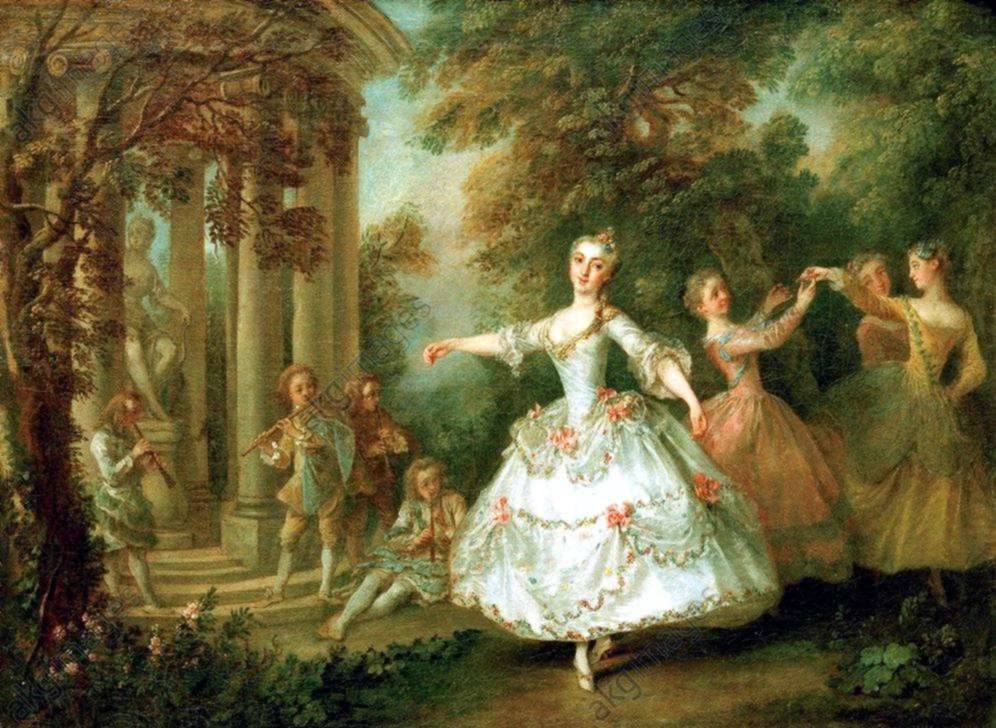
portrait of a dancer (Marie Sallé?).
Boston MA, Museum of Fine Arts 65.2647
In December the Nobility opera challenged Handel by performing Handel’s own Ottone with Farinelli in the secondary role of Adelberto. It was the only time that Farinelli sang in a Handel opera and Adelberto’s music was replaced for the occasion by arias from other Handel operas.
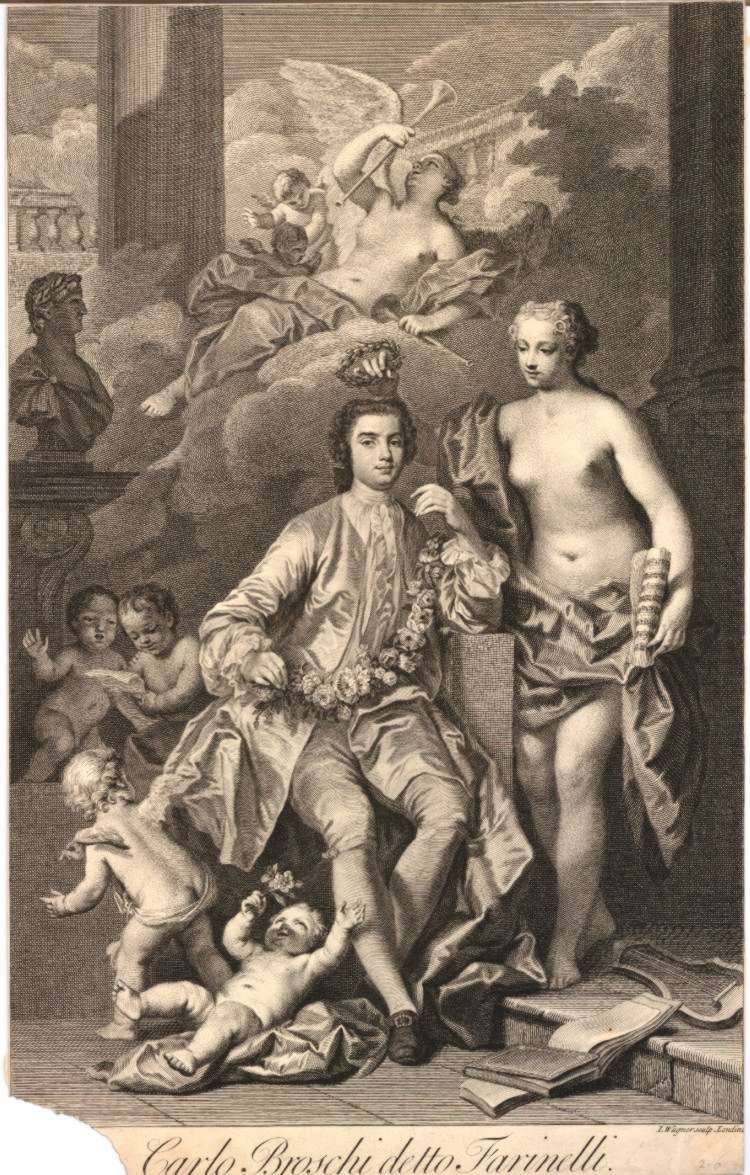
allegorical portrait of Farinelli, crowned with laurels by Euterpe.
London, British Museum, R, 10.26
Handel’s first new work for Covent Garden was Ariodante,
performed eleven times, in an often rather empty house. After a month
of oratorios, his Alcina, also new, followed. There were
eighteen performances during the rest of the 1734-35 season. That was
the best result to date, but not good enough to stop them losing
money. At the end of the season Sallé left.
The Opera of the Nobility also lost money. There simply was not
enough of an audience to keep two specialised companies going. They
carried on, however in the 1735-36 season with a revival of
Artaserse, among other works.
The Return of Arthur
On September 28th of that new season, Purcell’s King Arthur
was revived for the first time in thirty years by Giffard’s company,
which normally performed at Goodman’s Fields, but used Lincoln’s Inn
Fields for this occasion. There were six performances in all, three
of them in the week between Christmas and New Year’s Day.
Handel
opened the new season with oratorios, perhaps because he he lacked
enough good singers, as Dean suggests.129 When they did revive an opera again,
Ariodante, on May 5th, it was with a new Italian singer,
Giacchino Conti Ghiezzello and without dance. The reason for the
revival was probably that Handel’s new opera, Atalanta, wasn’t
ready yet.
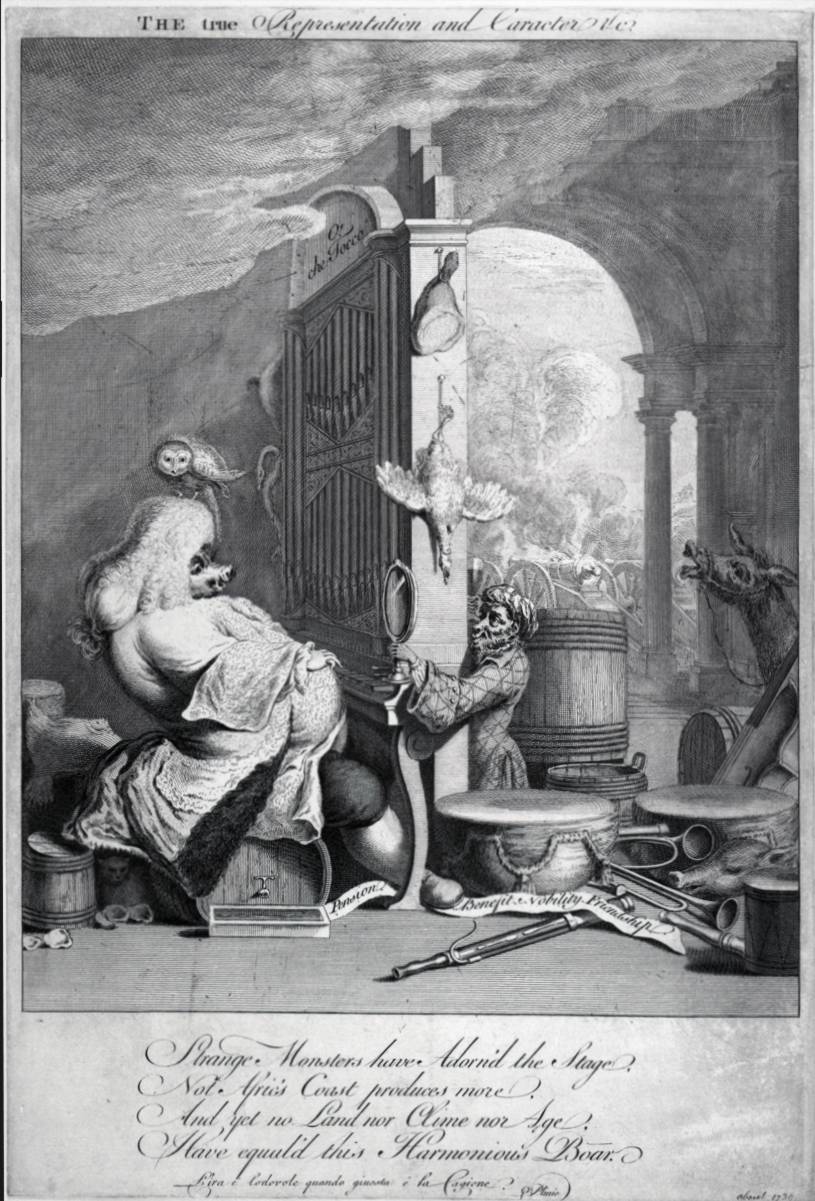
The Harmonious Boar.
British Museum 1868,0808.3974
The boar stands for greed, the mirror is a sign of vanity, both characteristics attributed to Handel. The instruments are loud ones.
A Celebratory Opera
Frederick, Prince of Wales, married Princess Augusta of
Saxe-Gotha, a countrywoman of Handel’s, on April 27th 1737 and Handel
wrote both a hymn (“Sing unto God”) and the opera Atalanta for
that occasion. The hymn was sung at the wedding,130 but the opera was delayed. Handel hadn’t finished
the score until April 22nd and Atalanta wasn’t performed until
two weeks after the wedding. The royal family attended without the
Prince and Princess of Wales, who saw a revival they ordered
themselves, in November.
The libretto, based on a text by Valeriani, had previously been set
to music by Fortunato Chelleri for a production in Ferrera in 1715.
The adaptation was probably written by Handel himself. The trumpets
in the overture invoke a festive air and return, accompanied by
kettledrums, in the epilogue, where the singers break character to
pay homage to the bridal pair. Special scenery was built for the
epilogue, which extended to the full depth of the stage 131 and there were fireworks at the
finale. The opera was performed six more times and that terminated
the short opera season in Covent Garden, which was operating at a
loss once again.
In the 1736-37 season Arminio, Giustino and Berenice followed, but after he had had a stroke in April, which paralysed his right arm, Handel was sent by his physician to Aix-la-Chapelle for a cure in the steam baths. After his return he wrote Faramondo and Serse for Covent Garden, but on November 20th Queen Caroline died and the theatres closed for the rest of the year 1737. Handel composed the hymn “The Ways of Zion do mourn” for her funeral.
A New Phase in the Power Struggle:
The Licensing Act
Meanwhile the government had taken back control of the theatres
through the Licensing Act, which had come into force on June 24th
1737. Every theatre had to have a royal patent or a license from the
Lord Chamberlain and all new additions to theatrical performances
(like prologues and epilogues) required the permission of the Lord
Chamberlain’s office, to be requested at least two weeks prior to the
performance. A similar act had been voted down by Parliament two
years earlier, but now the huge success of Fielding’s plays,
political satire including Pasquin and The Historical
Register for the Year 1736, lampooning Walpole and his ministry,
were the last straw.
In London, only Drury Lane and Covent Garden were permitted to
produce plays and only the Haymarket was allowed to put on operas. A
drastic reduction in theatres, companies of players and new plays
written for London was the result. There was no more room for rival
opera companies either, but they couldn’t have survived their
increasing losses in any case.
Henry Fielding’s satires were banned for a time.132 He wrote no more of them. He turned novelist
instead and twelve years later his classic Tom Jones was
published.
The search for loopholes in the new law began at once. Occasionally it led to the arrest of players. Presenting a comedy as a free entr’acte between two halves of a concert proved a successful dodge.
The Successful Dragon of Wantley
In practice, the new law was clearly meant to obstruct plays, not opera, even Italian opera, or those including satirical texts. On October 25th 1737 The Beggar’s Opera was revived at Drury Lane for five performances before the theatre closed for the period of mourning for the queen.
In Covent Garden, Carey and Lampe’s satirical chamber opera The
Dragon of Wantley, which had met with a lukewarm response in May
at the Little Theatre, was revived on October 26th to full houses and
performed all season, sometimes almost daily, as an afterpiece to
various plays. With sixty-eight performances, it even outran The
Beggar.
Later, in the 1740-41 season, the new law was
stretched even further and the theatre in Goodman’s Fields reopened
on a daily basis with a series of performances of The Beggar’s
Opera among other productions and on February 19th 1741, a
performance of Purcell’s King Arthur.133
Handel’s Last Operas
Handel’s Faramondo premiered on January 3rd 1738, back at the Haymarket with Heidegger. He had collected a company of singers from both the Nobility opera and Covent Garden. The leading role was sung by the new mezzo-soprano castrato Caffarelli. Handel’s return to the Haymarket was greeted with cheers and his opera too was initially received with enthusiasm, but the audiences at succeeding performances declined quickly. Serse followed on April 15th, again at the Haymarket; the performance wasn’t very good, the orchestra was too small. In addition, the recitatives had been scrapped to shorten it, which made the action hard to follow.134 It closed after four nights.
In May, Heidegger tried to arrange a 1738-39 opera season for the Haymarket but in July he had to admit that he didn’t have enough subscribers and that he couldn’t come to an agreement with the singers about their salaries. He decided to cease his efforts.
In September 1738 Handel began to write the score of Imeneo. In contrast to many of Handel’s other operas, this one was to travel a long, winding road before reaching the stage. There was little chance of producing it at the Haymarket at that time, but he was clearly not yet ready to abandon Italian opera entirely. The oratorios, however, now claimed his attention. Imeneo wasn’t to be produced until November 22nd 1740 at Lincoln’s Inn Fields, billed as an “operetta”135 and only performed twice, less than any of his other operas.
His final opera, Deidamia, followed on January 10th 1741 at Lincoln’s Inn Fields again and again had only two performances. However a third was given a month later, in the Little Theatre in the Haymarket 136 It wasn’t much of a success. Handel had had enough, but that wasn’t quite the end of Italian opera on the stage. Lord Middlesex, who had been directing the Little Theatre since 1739, moved across the way to the King’s with a kind of second Opera of the Nobility. On October 31st 1741 he presented Alessandro in Persia, a pasticcio concocted by Baldassare Galuppi, with much of his own music.
In Conclusion
As we stated earlier, the end of baroque music theatre was not sharply defined. The choice of subject, the iconography and the music each followed a path of its own. The final opera by Handel, a composer whose music was still fully within the baroque tradition, is a good place to round off the subject.
Italian opera presented in the manner of Handel and his contemporaries was to remain popular in spite of increasing criticism of the genre, which was seen as an expensive hobby of the aristocracy and in an unintelligable language to boot. Nevertheless it was to endure until well into the nineteenth century, when there were no more Italian castrato singers.
Stage design was also to change. Philippe Jacques de Loutherbourg,
a well-known French painter was invited to London to design scenery
for Drury Lane by its actor-manager David Garrick, who was succeeded
by Richard Brinsley Sheridan. In the early 1770s, de Loutherbourg was
to provide both technical and artistic innovations.
He was to abandon the fixed ordering of elements (wings, friezes,
backdrops), which had remained substantially unchanged since the
introduction of changeable scenery in the middle of the seventeenth
century, in his efforts to achieve more realism. He also introduced
new ways of using lighting and colour and unified the stage design as
envisioned by the librettist, which until then had been dependant
largely on the initiative of the scene painters.
In addition there was the trend - which set in long before de Loutherbourg - to make more use of three-dimensional props: real running water in fountains (Amadigi), live birds, possibly even actual horses (Rinaldo?). Playing with perspective, evoking a three-dimensional space by means of representations painted on a flat surface, gave way to a kind of realism, which would eventually lead to lowering the front curtain between every two acts of an opera in order to reconstruct the stage for the next scene.
We are convinced that for Purcell, Betterton and their
contemporaries, semi-opera (áfter the through-sung Dido and
Aeneas, which was probably first envisioned as a masque) was a
deliberate choice.
This genre, also called “dramatick”or “English” opera, consisting
about half in spoken text, became the victim of political manoeuvres
early in the eighteenth century, but the spoken text didn’t
disappear. The successful ballad-operas such as The Beggar’s
Opera had spoken words. The hugely popular nineteenth-century
“comic operas” by Gilbert and Sullivan, one of which is always being
performed somewhere, even today, have spoken texts, as do the
present-day “musicals”, of which there are too many to enumerate.
The meaning of the term “English” opera was to change in the nineteenth century to an opera by an English composer, in the English language and preferably about a subject from British history. It was, however, through-composed, e.g. Sir Arthur Sullivan’s Ivanhoe. The distinction was important, as by that time foreign operas had again become dominant on the London stage.
The successful semi-operas of the early sixteen nineties 137 were revived from time to time during the eighteenth century. Ninety-four years after the first performance, The Prophetess was still on the programme of Covent Garden.138
As to through-composed English opera in the twentieth century, it was Benjamin Britten who picked up the thread.
Notes
1. One reason might be that there was no single “dessinateur du cabinet du roi” comparable to Henri Gissey and his successor Jean Berain in France. They were supported by a studio full of specialists and had a virtual monopoly on supplying opera designs. In the annals of English seventeenth and early eighteenth-century theatre, the names of set painters are rarely mentioned and then incidentally, often with reference to only one specific scene.↩
2. As far as we know, the earliest pyrotechnology is Chinese, unknown in Europe at the time. For early “special effects” in England and Scotland see e.g.: Philip Butterworth, Theatre of Fire, London, Society for Theatre Research, 1998 and for more general information: Sabbattini, Pratica di fabicar Scene e Machine ne'Teatri, Ravenna, 1638.↩
3. We showed a slide of that reconstructed scene and presented the reseach which preceded it at a symposium called “Peforming the Music of Henry Purcell”, held in September 1993 at New College, Oxford, in the run-up to the Purcell commemorations of 1995. The contributions were compiled and published as a book: Michael Burden, ed. Performing the Music of Henry Purcell, Oxford U.P., 1996.↩
4. Dr. Burden’s contribution to the conference was entitled Revisiting the Exotic in Purcell’s Fairy Queen. The animation, which we first presented at that time, served as an illustration to his lecture. The research was published in Early Music Vol. XXXIII/4 (November 2005), pp. 667-81. (The penultimate sentence being botched at printing.) ↩
5. The term masque is used here in its meaning of an all-sung scene in music theatre, as the finale to an act otherwise consisting mainly in spoken text. (The court masques of the early seventeenth century will be discussed hereafter).↩
6. Milhous, Judith “The Multimedia Spectacular on the Restoration Stage”, in British Theatre and the Other Arts, 1660-1800, ed. S. Strum Kenny, Washington D.C., Folger Books, 1984, pp. 41-66.↩
7. In the baroque theatre, the word “machine” has nothing to do with a moving mechanism. It is a piece of scenery appearing from above or under the stage and serves as a vehicle for gods and other supernatural characters. It is the origin of the term Deus ex Machina.↩
8. Extensively described in Stephen Orgel and Roy Strong, Inigo Jones. The Theatre of the Stuart Court, two vols., London, Sotheby Parke Bernet, U. of California Press, 1973.↩
9. [White]Hall Theatre, designed by John Webb, opened in 1665. The cost of performances like John Crowne’s Calisto was considerable, but the number of masques and ballets at Charles II’s court was relatively small. Sometimes public theatre productions were also performed at court.↩
10. John Downes, Roscius
Anglicanus, eds. Judith Milhous and Robert D. Hume, London,
Society for Theatre Research, 1987, p.20. An earlier edition, by
Montague Summers, can be found on the internet; see Bibliography.
Downes means: in the public theatre (but see also note 4 on our Patents page.)↩
11. Making this Commonwealth performance England’s first “real” opera, for those using the misleading but now generally accepted classification.↩
12. Leslie Hotson, The Commonwealth and Restoration Stage, Harvard U.P., 1928, p.229. On August 11th 1670 a thirty-nine year lease (commencing December 23th 1669) was signed with the carpenter Roger Jerman regarding a piece of land in Dorset Garden, on the banks of the Thames at Dorset Stairs.↩
13. In the first act: a stormy sea, with wild waves; flying spirits which descended among the sailors and then rose again, their paths crossing; a sinking ship; a rain of fire while the former scene disappears and a new one appears, being a beautiful island. In the second act: devils rising from under the stage and in the third: spirits bringing on a set table and later flying away with it; in the fourth: a sea again, now calm, from which four sea-gods rise in a chariot drawn by sea-horses (horses with fish tails) and accompanied by other mythical sea creatues, including tritons, which change shape as they dance.↩
14. Pierre Danchin, The Prologues and Epilogues of the Restoration, U. de Nancy II, 1981.↩
15. Often called “His Majesties Servants” and later, under William and Mary, “Their Majesties Servants”.↩
16. Jerôme de la Gorce, Jean-Baptiste Lully. Paris, Fayard, 2002, p.299. He cites a letter written by Rudolphe Reuss on March 29th 1684 establishing that there were concrete plans for a trip to England by Lully and the entire Académie de musique. Louis XIV was to pay the cost of travel to the Channel and Charles II had pledged fifty thousand écu on top of what Lully might earn in England. Why, shortly afterwards, Lully decided not to come after all, is as yet unknown.↩
17. la Gorce, Jean-Baptiste Lully, p.298-9. Betterton was assisted by Lord Preston, Envoy Extraordinary to the Court of France. A month after Betterton’s visit, he wrote a letter of recommendation to James, Duke of York, for Louis Grabu, a composer of Catalan origin who had worked in London before as Master of the King’s Musick and had participated in the performance of the opera Ariane by his teacher Cambert in 1674, but who had been deprived of his post by the Test Act.↩
18. Dorset Garden was now called The Queen’s Theatre, as the duke had become the king and there was already a King’s Theatre.↩
19. Downes, Roscius Anglicanus, eds. Milhous and Hume, p.84.↩
20. From Thomas Durfey, “The Raree-show, from Father Hopkins”, in Wit and Mirth: or Pills to Purge Melancholy. London, J. Tonson, 1720.↩
21. In the dedication to James II of his score published in 1687, he wrote: “The only Displaesure which remains with me, is, that I neither was nor could possibly be furnish’d with variety of exellent Voices, to present it to Your Majesty in its full perfection”.↩
22. Eric Walter White, A History of English Opera, London, faber and faber, 1983, pp. 115, 121 and 123. She attended a performance of Purcell’s The Prophetess on November 17th 1690, King Arthur on January 7th 1692 and The Fairy Queen on February 16th 1693.↩
23. Rudolph Rasch, “A Venetian goes North: Pietro Antonio Fiocco in Amsterdam, Hanover and Brussels”. Belgisch Tijdschrift voor Muziekwetenschappen, Vol. LVI, Ghent University, 2002, p.180-182. Earlier, William had shown some interest in music theatre. In February 1680 he and Mary had twice attended performances of Le fatiche d’Ercole per Deianira by Pietro Andrea Zianis at Dirck Strijcker’s opera theatre on the Leidsegracht in Amsterdam. (This was probably the first time they heard Italian castratos).↩
24. Peter Motteux and John Eccles,
Europe’s Revels for the Peace of Ryswick, ed. Michael Burden,
Middleton WI, A-R Editions, 2019, p.xxii, lines 48-9:
“To William’s court, all noble arts will run
The muses move still westward like the
sun...” ↩
25. National Archives, PROB 11/375/223↩
26. From the epilogue to Congreve’s Love for Love, spoken at the opening by Mrs Bracegirdle.↩
27. Leslie Hotson, The Commonwealth and Restoration Stage, Harvard U.P., 1928, p.293.↩
28. Milhous and Hume, “The Silencing of Drury Lane in 1709” Theatre Journal, Vol. 32, No. 4 (Dec. 1980), pp. 427-447.↩
29. Rinaldo and Armida, A TRAGEDY: As it is acted at the Theatre in Little-Lincoln’s-Inn-Fields. Written by Mr. Dennis. London, Jacob Tonson, 1699 (facsimile word-book). Dennis writes that he was inspired by Torquato Tasso’s Gerusalemme Liberata, but goes his own way. The action takes place somewhere on the Canary Islands, first on top of a mountain, where we see Armida’s enchanted palace rise, later inside the palace and in its surroundings. We meet various kinds of spirits rising from under the stage, some singing, some dancing or flying though the air. Armida dies at the end, but Fame takes her into a company of heroes and heroines in the clouds.↩
30. The Island Princess, A Semi-Opera. Introduction by Curtis A. Price and Robert D. Hume, Tunbridge Wells, Richard Macnutt, 1985.↩
31. Milhous and Hume, The London Stage, 1660-1800, A New Version of Part 2, 1700-1729, Season of 1700-1701, p.16. On line only, for a link see bibliography.↩
32. A.C.Sprague, Beaumont and Fletcher on the Restoration Stage, Harvard U.P., 1926, reissue New York, Benjamin Blom, 1965, pp. 147ff and 152.The Island Princess, or: The Generous Portuguese was a spectacular semi-opera with music by the three Drury Lane house composers, Daniel Purcell, Jeremiah Clarke and Richard Leveridge. The word-book by Peter Motteux was a reworking of Nahum Tate’s 1687 version of Fletcher’s play of the same name. Motteux must have consulted the original playtext, as he describes the “Spice Islands”, which are not mentioned in Tate.↩
33. After Finger’s The Virgin Prophetess was first presented in 1701, Purcell’s Prophetess was known for a time as Dioclesian, to avoid confusion. That is also the name by which it is known now.↩
34. Mr. Pate was a countertenor. He had sung the role of Mopsa in Purcell’s Fairy Queen of 1692.↩
35. William Van Lennep et al., eds. The London Stage, Part 1, Carbondale, Southern Illinois U.P., p.cxiii.↩
36. Thomas McGeary, “Thomas Clayton and the Introduction of Italian Opera to England”, Philological Quarterly 77, No. 2 (1998). It was meant to be performed at the opening of Vanbrugh’s new theatre in the Haymarket, but when that opening was delayed Clayton and Rich agreed to produce it at Drury Lane instead. Congreve’s Semele, with music by John Eccles (1707), was probably also a candidate for this opening, but the music wasn’t finished. See Stoddard Lincoln, “The First Setting of Congreve’s Semele”, Music and Letters, Vol. XLIV, No. 2 (April 1963), pp. 103-17.↩
37. The Daily Courant cited in Judith Milhous and Robert D. Hume, eds. The London Stage, a new version of Part 2, 1700-1729, Season of 1705-06, p.204.↩
38. Downes, op. cit., p.99.↩
39. April 23rd 1705, Drury Lane, The Tender Husband. Epilogue.↩
40. Colley Cibber, An Apology for the Life of Colley Cibber written by Himself, ed. Robert W.Lowe, London, John Nimmo, 1889, Volume the First, p.321. Cibber wrote “the Tone of a Trumpet, or the Swell of an Eunuch’s holding Note ’tis true, might be sweeten’d by it; but the articulate Sounds of a speaking Voice were drown’d by the hollow Reverberations of one Word upon the Other”.↩
41. George Granville, Poems Upon Several Occasions, S. Powell, Dublin, 1732, n.p. Granville writes in his Preface that he plans to surpass his French example: “As I cannot help being concern’d for the Honour of my Country, even in the minutest things, I am for endeavouring to out-do our Neighbours in Performance of all Kinds.”↩
42. The stage directions of The British Enchanters required a lot of flying: a dragon-drawn chariot for the sorceress Arcabon and spirits - sent by the fairy Urganda - descending on clouds, some of them playing musical instruments and others battling in the air with the sorcerer Arcalaus’ demons, who are finally defeated after fire has rained down on them. Activities originating under the stage included demons and monsters ascending and descending again.↩
43. Milhous and Hume, eds. The London Stage, 1660-1800, A New Version of Part 2, 1700-1729, season 1705-06. See Bibliography for a link.↩
44. Stoddard Lincoln, “Semele”, in Music and Letters, Vol.44, No.2 (April 1963) pp. 103-17. First semi-staged performance in the Holywell Music Room in Oxford, June 4-6 1964.↩
45. At that time Henry Grey, Marquess of Kent.↩
46. Milhous and Hume, eds. Vice Chamberlain Coke’s Theatrical Papers 1706-1715, Carbondale, Southern Illinois U.P., 1982, p.49. "That all Operas and other Musicall presentments: be perform'd for the future only at her Majestys Theatre in the Hay Markett..." The successful Camilla and Arsinoe were therefore lost to Rich, but he regained the monopoly on straight plays which he had lost in 1695 when Betterton was given a license to perform plays at Lincoln’s Inn Fields. Rich’s new monopoly was not to endure for long.↩
47. Milhous and Hume, op. cit., p.106.↩
48. Milhous and Hume, “The Charter for the Royal Academy of Music”, Music & Letters, Vol. lxvii (1986), pp. 50-8, see also Thomas McGeary, “Vice Chamberlain Thomas Coke and Italian opera in London: new documents”, Early Music Vol.XLVI, No.4 (2018), pp. 653-74.↩
49. Hume, “The Sponsorship of Opera in London 1704- 1720”, Modern Philology, Vol. 85, No.4, pp. 420-32.↩
50. A matter of safety, too: the road to Westminster went partly through uninhabited territory. NB: a lot of traffic went by way of the Thames at that time.↩
51. The Italian singers had no idea what the doors were for; they were used to coming onstage from the wings.↩
52. Milhous and Hume, “The Silencing of Drury Lane in 1709”, Theatre Journal, Vol. 32, No. 4. (Dec., 1980), pp. 427-47. The proceeds of benefit performances were meant for the actors, making it possible for them to cash in on their popularity and supplement their meagre salaries. Benefits were chiefly allowed in difficult times, when a small audience was expected and the management would lose the least income. A portion of the proceeds from a benefit had to be relinquished as a contribution to the cost of the performance. Rich not only drastically increased that contribution, but insisted that it be paid in advance. Given the reactions, he soon dropped that demand. The new regulation was particularly detrimental to the lowest paid actors.↩
53. Curtis Price, “The Critical Decade for English Music Drama 1700-1710”, Harvard Library Bulletin, Vol. 26 No. 1 (1978), pp. 38-76. He describes the resulting occurrences as “revolutions” and adds several diagrams to show who was where and when.↩
54. Probably the result of a plan of Swiney’s to highjack the theatre in Drury Lane, but later events were to make that impossible. In the end, only four actresses were asked to move to the Haymarket.↩
55. Othello and Hamlet, Milhous and Hume, The London Stage, Part 2, Season 1709-10, pp. 512-3. The Hamlet was presumably Davenant’s 1676 revision. Michael Dobson, The Making of the National Poet, Oxford, Clarendon Press, 1992, p.28.↩
56. Philip Highfill et al., A Biographical Dictionary of Actors...etc., Carbondale, Southern Illinois U.P., 1975, Vol. 3, p.393. Collier knew he was protected by the authorities. ↩
57. The London Stage records an “entertainment” after the performance of The Recruiting Officer at the Haymarket on December 7th 1709: “By the famous Mr Higgins, lately arrived from Holland; who turns himself into such variety of Amazing Shapes and Figures, that the particulars wou'd be incredible to all Persons who have not seen him.” (see Steele and Addison, The Tatler, Project Gutenberg, Vol. 2, #108, see link in bibliography)↩
58. Vice Chamberlain Coke’s Theatrical Papers, 1706-1715, eds. Milhous and Hume, p.142 (18 May 1710): “There are in the theatre three other masters, all three comedians, who have become Swiney's associates since last winter as companions, directors, and referees of comedies as well as operas and musicians; their interest and their purpose is to destroy the operas and to insult those who oppose their design; reason therefore dictates that the Chevalier [Nicolini], who is always ready to be of service to the nobility, should not be exposed to the insolence, intrigues, and malice of these new directors who want to disgust him so much that he will either cease to support the opera or bring himself to leave England.↩
59. A Register of English Theatrical Documents 1660-1737, eds. Milhous and Hume, Southern Illinois U.P., 1991, Vol. 1, p.440, #2021 quotes The Post-Man of May 17th-19th 1709: “The Play House at Dorset Stairs is now pulling down, where there is Old Timber fit for Building or Repairs, and old Boards, Bricks, Glaz’d Pantiles and Plain Tiles; also Fire Wood, to be sold reasonably.” ↩
60. Vice Chamberlain Coke’s Theatrical Papers, 1706-1715, pp. 143-5.↩
61. Colley Cibber says he remembers that Hill paid Collier six hundred pounds a year for the privilege. If that is correct, it means that Hill bore the financial responsibility himself. An Apology for the Life of Colley Cibber, ed. Robert W. Lowe, London, Nimmo, 1889 Vol. I, p.315. (see Bibliography for link) ↩
62. He owes his reputation mainly to the description by his pupil Geminiani of the strictness with which he insisted that all the bows go up and down in unison. In spite of his relatively small oevre, as a composer Corelli had great influence on European music.↩
63. Johann Mattheson, Georg Friderich Händels Lebensbeschreibung, Hamburg, 1761, p.58. “1500 Crowns“, according to Handel’s first biographer, John Mainwaring, but Mattheson, who translated the biography into German the following year, probably knew more about the currency in Hanover.↩
64. According to our calender. Until January 1752, the year ended on Lady Day, March 25th. William’s year of death is dated in early documents as 1701.↩
65. Clotilda, Haymarket, March 1709. A pasticcio was an 18th-century sort of opera, a mixture of vocal and instrumental pieces from existing operas.↩
66. Highfill et. al. Vol. 7, p.297.↩
67. David Roberts, ed. Pinacotheca Bettertonæna. Catalogue of the Books, Prints, Drawings and Paintings of Mr. Thomas Betterton, 1710, London, Society for Theatre Research, 2013. One of the books is by Aaron Hill: A Full and Just Account of the Present State of the Ottoman Empire in all its Branches, London, 1709. In the book, he reports on Jerusalem, which was part of the Ottoman Empire at the time, and deplores the state of decay into which the city had in his opinion fallen.↩
68. As many as fifteen numbers and some with the original text. Rossi complained that he couldn’t write texts fast enough to keep up with Handel’s tempo.↩
69. It wasn’t until over twenty years later that Hill wrote to Handel, on 5 December 1732, urging him to set English words, undoubtedly as a result of the huge interest in English opera generated by the successful Beggar’s Opera. “My meaning is”, he wrote, “that you would be resolute enough to deliver us from our Italian bondage and demonstrate that English is soft enough for opera, when compos’d by poets, who know how to distinguish the sweetness of our tongue from the strength of it.” The quotation can be found in G.A. Macfarren, "The Italian Language: Its Evil Influence Upon Music", The Musical Times, March 1st, 1869, p.7.↩
70. There is a waterfall again in Clotilda on May 11th 1711 and this time it isn’t limited to one act as in Rinaldo: “And by reason of the Hot Weather, the Waterfall will play the best part of the Opera.” The London Stage, Vol.1, Part 2, p.249. This is obviously real water and probably the same waterfall mentioned in the announcement of Pyrrhus and Demetrius for December 6th 1710: “With the Addition of a New Cascade Scene after the Italian Manner.”↩
71. The Spectator, March 16th 1711.“The Sparrows and Chaffinches at the Hay-Market fly as yet very irregularly over the Stage; and instead of perching on the Trees and performing their Parts, these young Actors either get into the Galleries or put out the Candles.“↩
72. The Spectator, March 6th 1711.↩
73. The Spectator, March 16th 1711.↩
74. Mrs. Elizabeth White at White’s Chocolate House in St. James‘.↩
75. Colman’s Opera Register, transcription, Stanford University, (see Bibliography for link). “After these Two Nights Mr Swiney Brakes & runs away & leaves ye Singers unpaid ye Scenes & Habits also unpaid for. The Singers were in Some confusion but at last concluded to go on with ye operas on their own accounts, & divide ye Gain amongst them.”↩
76. A choice probably made due to similarities in the scenery: a dragon chariot for Medea, lots of scary monsters and an enchanted garden (maybe even with another waterfall) which Medea summons up by magic.↩
77. During the 1708 renovations, a wall between the theatre and the building behind it had been removed in order to give extra depth to the vista stage.↩
78. The first series of performances of Amadis had been interrupted in July 1715 due to the unrest. “No Opera performed Since ye 23rd July, ye Rebellion of ye Tories & Papists being ye cause - ye King & Court not liking to go into Such Crowds these trouble Some times [sic]...” Colman’s Opera Register, transcription, Stanford University, see Bibliography for link. ↩
79. With drastically curtailed spectacular scenes compared to earlier performances.↩
80. His sons John and Christopher Moyser Rich inherited three-quarters and one quarter respectively of the share (one sixth) their father had still owned in the Davenant patent and were able to give performances on those grounds.(see also our Patents page) Drury Lane used the licenses granted by the various Lords Chamberlain since 1709, excepting the 1714-1720 period, when they operated under Steele’s license.↩
81. Terry Jenkins, John Rich, The man who built Covent Garden Theatre, Bramber, Barn End Press, 2016, pp. 252-57: “A portrait of John Rich”↩
82. “Not Acted these Sixteen Years. And all the Original Musick. The Habits, Scenes, Machines, Dances and all other Decorations, proper to the Play, being entirely New. [...] And as there are a great many Scenes and Machines to be mov’d in this Opera, which cannot be done if Persons should stand on the Stage, (where they could not be without Danger)...” The London Stage, Part 2, Vol. 1. Sixteen years? Not quite true. It had been performed at Drury Lane in 1705.↩
83. From the Preface to Venus and Adonis, a Masque, Written by Mr. CIBBER, and set to Musick by Dr. PEPUSCH, presented at the Theatre Royal, Drury Lane on March 12th 1715. London: Bernard Lintott, 1715. This was an afterpiece to a play which was to be repeated several times in combination with other plays. The London Stage, Part 2, Vol. 1, pp. 346 ff.↩
84. Deutsch, Handel, A Documentary Biography, London, A. and C. Black, 1955, p.76, (for a link see bibliography). Deutsch is quoting The Daily Courant, No. 4913, Friday July 19th 1717.↩
85. Complete text in Milhous and Hume, “The Charter of the Royal Academy of Music”, Music & Letters 67 No.1 (Jan. 1986), pp. 50-8.↩
86. Literally: the little Siennese. That was no doubt meant to be ironic, given how tall he was.↩
87. Winton Dean and John Merrill Knapp, Handel’s Operas 1704-1726, revised edition, Oxford U.P., 1995, reprint Woodbridge, Boydell Press, 2009, p.345.↩
88. Jonathan Keates, Handel, The Man and his Music, London, Weidenfeld and Nicolson, 1992, p.95.↩
89. From letters in Italian. He used the term “il selvaggio” (the savage) in a letter to Riva, in October 1720. R. A. Streatfeild, “Handel, Rolli, and Italian Opera in London in the Eighteenth Century” in The Musical Quarterly, Volume 3, No. 3 (July 1917), p.435.↩
90. Augusta Hall, ed. The Autobiography and Correspondence of Mary Granville, Mrs. Delany, London, Richard Bentley, 1861, 2 Vols. Vol.1, p.57. Mary Pendarves in a letter to her sister Anne Granville on November 17th 1720. ↩
91. That wasn’t just about music. The fact that Bononcini, unlike Handel, was a Roman Catholic and was in contact with Jacobites, contributed to Londoners’ partisanship and to a conflict between Bononcini and the directors of the Royal Academy in 1722.↩
92. Winton Dean and John Merrill Knapp, Handel’s Operas 1704-1726, p.369.↩
93. John Byrom, Miscellaneous Poems, Manchester, J. Harrop, 1773, Vol.1, pp. 343-4.↩
94. Charles Burney, A General History of Music, 1789, ed. Mercer. New York 1935, Vol. 2, p.737, (see Bibliography for link).↩
95. “The Life of Johann Joachim Quantz” in Forgotten Musicians ed. Paul Nettl, New York, Greenwood Press, 1969, p.312.↩
96. Lisabeth M. Kettledon, A Lyric Soprano in Handel’s London, U. of Connecticut, Thesis, 2017, p.1.↩
97. John Mainwaring, Memoirs of the Life of the Late George Frederic Handel, London, Dodsley, 1760, footnote p.110. The story has been told countless times since. Mainwaring (1724-1807) could have been told the tale firsthand, so he gets the footnote. ↩
98. Handel wasn’t the only one to write an opera on this subject: Vivaldi’s Bajazet was presented in 1735.↩
99. Winton Dean and John Merrill Knapp, Handel’s Operas, 1704-1726, p.531.↩
100. Rodelinda was the first Handel opera of which the libretto was published on a subscription basis.↩
101. Burney, op. cit., Vol. 4, p.299, footnote 1(u).↩
102. Rival to Hogarth’s father-in-law, James Thornhill.↩
103. Kettledon, thesis, 2017, p.5. Cuzzoni and Faustina knew one another from the Teatro San Giovanni Grisostomo in Venice, where both sang in Pollarolo’s Ariodante in 1718. Faustina took the role of Ginevra, Cuzzoni that of Dalinda.↩
104. Winton Dean, Handel’s Operas 1726-1741, Woodbridge, The Boydell Press, reprint 2007, p.24: Dean quotes Horace Walpole, but observes that Walpole’s recollection may be of a revival.↩
105. Thomas McGeary, “Verse Epistles on Italian Opera Singers 1724-1736”, Royal Musical Association Research Chronicle, No. 33 (2000), pp. 29-88.↩
106. Henry Carey, “The Discontented Virgin”, The British Journal, 25 March 1727.↩
107. He has been quoted regarding this incident in innumerable sources. He was ten years old at the time.↩
108. Amy Cornsweet, Handel’s Use of Flute and Recorder in Opera and Oratorio, U. of Arizona, M.M. thesis, 1990, p.23: Handel used the traverso, also called cross flute or German flute, instead of the recorder as in Purcell’s time, long before it was the standard in English orchestras. While still in Italy, he had already used the instrument for Aci, Galatea e Polifemo e.g. in 1708.↩
109. Milhous and Hume, A Register..., Part 2, p.737, #3441, quoting the Diary of the first Earl of Egmont, “...went to a meeting of ye Members of ye Royall Academy of Musick: where we agreed [...] to permitt Hydeger & Hendle to carry on Operas without disturbance for 5 years & to lend them for that time our scenes machines clothes instruments furniture &c”↩
110. From Rolli’s letters to Senesino in January and February 1729, in Robert D. Hume, “Handel and Opera Management in London in the 1730s” in Music & Letters, Vol. 67 No. 4, October 1986, pp. 347-62. Some later authors believe that Handel and Heidegger went on alone, at their own risk or with guarantees from private persons. Opinions also differ about the duration of the agreement. Hard facts are hard to find.↩
111. There was no copyright as yet, so the term “pirate” had no legal status.↩
112. Otto Erich Deutsch, Handel, A Documentary Biography, A. and C. Black, London, 1955, p.289. See Bibliography for link. ↩
113. From See and Seem Blind, a satirical pamphlet, almost certainly by Aaron Hill, quoted in Deutsch, 1955, p.301. ↩
114. Arthur Scouten, et al., eds. The London Stage, Part 3, Vol. 1, p.223 (see Bibliography for link): “There will be no Action on the Stage, but the Scene will represent, in a Picturesque Manner, a Rural Prospect, with Rocks, Groves, Fountains and Grotto’s, amongst which will be disposed a Chorus of Nymphs and Shepherds, the Habits and every other Decorations suited to the object”. The casting was reported too: out of nine roles, only two were taken by English singers, Clori and Eurillo. That gives us an impression of how the roles were divided between the English and the Italians.↩
115. Michael Burden, “Purcell’s ‘King Arthur’ in the 1730s” in Restoration: Studies in English Literary Culture, 1660-1700, Vol. 34, No. 1/2 (Spring-Fall 2010), p.130. He quotes a letter of Mary Delany’s in which she wrote about this event: “I was very much disappointed, for instead of Purcell's music, we had Papuch's, [sic] and very humdrum it was; indeed, I never was so tired of anything in all my life”↩
116. Robert D. Hume, Henry Fielding and the London Theatre, New York, Oxford U.P., 1988, p.11: The theatre was built by the carpenter John Potter - who also constructed scenery for the Haymarket opera - and was rented out. It was also known as the New French Theatre, New Theatre and Little Theatre. We will refer to it as the Little Theatre to avoid confusion with the various other Theatres Royal.↩
117. In this case that only meant all-sung.↩
118. A German bassoonist in the Academy orchestra.↩
119. Digitaal facsimile via Gale/ECCO Document No. CW3307392529.↩
120. It was to be performed again, successfully this time, at Goodman’s Fields in February 1734, on the occasion of Princess Anne’s marriage to the Prince of Orange.↩
121.“Though my inclination to Musick frequently leads me to visit the Italian Opera; yet, I confess, it is not in the Power of the present excellent Performers to prevent my falling into the very common Opinion, that there are many essential Requisites still wanting, to establish that Entertainment on a lasting Foundation, and adapt it to the Taste of an English Audience. [...] It is evident, that the vast Expence of procuring foreign Voices, does necessarily exclude those various Embellishments of Machinery, Dances, as well as Poetry itself, which have been always esteemed (except till very lately in England) Auxiliaries absolutely necessary to the Success of Musick [...] You will perceive, Sir, that in the following Entertainment [...] I have endeavoured to introduce that Variety which has usually been thought agreeable on the Stage; and have attempted to form the serious Part of it upon the above-mentioned Plan [...] from which the Town may be able to form a Judgement of the Effect an Opera would have, if conducted (by an abler Hand) in the same Manner.” (John Rich, from the dedication to Theobald’s The Rape of Proserpine).↩
122. De Fesch’s second oratorio, Joseph, has been preserved and was recorded in 2000 under the direction of Jed Wentz. NM Classics 92079.↩
123. The Daily Journal, 3776, February 6 th 1733, p.2, c.3.↩
124. Robert L. Tusler, “Willem de Fesch: International Eighteenth-Century Composer” in The Great Emporium, Amsterdam, Rodopi, 1992, p.201.↩
125. See Carol Taylor, “Handel and Frederick, Prince of Wales”, The Musical Times, Vol. 125, No. 1692 (Feb. 1984) pp. 89 and 91-92.↩
126. Deutsch, 1955, p.369, Letter to Sir Wyndham Knatchbull, Aug. 27th 1734.↩
127. See footnote 121.↩
128. Hasse had married Faustina Bordoni.↩
129. Winton Dean, Handel’s Operas 1726-1741, 2006, p.278.↩
130. Deutsch 1955, p.407: ↩
131. The London Daily Post, May 13th 1736, quoted in Deutsch 1955, p.407.↩
132. Arthur H. Scouten et al., eds. The London Stage, Part 3, Vol. 2, pp. 991 and 1036 (see Bibliography for link): Not until May 6th 1742 would his Miss Lucy in Town be presented at Drury Lane as an afterpiece to Othello and it was very soon forbidden by the Lord Chamberlain. It was to be February 17th 1743 before another of Fielding’s comedies was performed: The Wedding Day. The play was not accepted until he had made changes and was received badly. According to commentary, it was only saved by Garrick’s acting. (Garrick had made his debut only two years earlier and was still relatively unknown.)↩
133. According to The London Stage, Part 3, Vol. 2, p.891: “With all the Scenes, Machines, and other Decorations proper to the Opera, particularly, An exact Representation of Merlin’s Cave, as in the Royal Gardens at Richmond.” The cave was a recent addition to the royal garden.↩
134. D. Burrows and R. Dunhill, Music and Theatre in Handel’s World: The Family Papers of James Harris 1732-1780, Oxford U.P., 2002, p.49.↩
135. John H. Roberts, “The Story of Handel’s Imeneo” in Händel-Jahrbuch, Volume 47, Halle, Georg-Friedrich-Händel-Gesellschaft, (2001), pp. 337-84. In Porpora and Stampiglia's Naples, a “serenata” was performed without action on the stage: the singers - perhaps in costume and sometimes sitting down - sang from the score. The set was usually limited to a painted backdrop with no scene changes. Handel's Imeneo too had only one set: “A Pleasant Garden”, designated “Deliziosa” in the Italian text.↩
136. The London Stage Part 3, Vol. 2, p.889. For particulars, one is referred to the Jan. 10th performance.↩
137. With the exception of The Fairy Queen, of which the score was not to be rediscovered until the beginning of the 20th century.↩
138. The performance of 17 May 1784 contained a number of popular scenes from the opera. How much of the text was still spoken is unknown.↩
Selected Bibliography
- Addison, Joseph, et al., The Spectator, 4 Vols., ed. C. Gregory Smith, London: Dent, 1945, reprint 1963-67.
- Addison, Joseph, et al., The Spectator, A New Edition, ed. Henry Morley, 3 Vols., London: George Routledge and Sons, 1891. Vol. 1 and index
- Avery, Emmett L. et al., eds. The London Stage 1660-1800, Part 2 (1700-1729), 2 Vols., Carbondale: Southern Illinois U.P., 1960. Part 2, Vol. 1 / Vol. 2
- Barlow, Graham, From Tennis Court to Opera House, Thesis, U. of Glasgow, 1983, pp. 348-67. (see: www.theses.gla.ac.uk/73940/)
- Burden, Michael, ed., Performing the Music of Henry Purcell, Oxford U.P., 1996.
- Burden, Michael, “Purcell’s King Arthur in the 1730s”, Restoration: Studies in English Literary Culture, 1660-1700, Vol. 34, No. 1/2 (Spring-Fall 2010), pp. 117-38.
- Burney, Charles, A General History of Music, ed. Frank Mercer, 2 Vols., New York: Harcourt Brace and Company, 1935. Vol. 2
- Burrows, Donald and R. Dunhill, Music and Theatre in Handel’s World: The Family Papers of James Harris 1732-1780, Oxford U.P., 2002.
- Butterworth, Philip, Theatre of Fire, London: Society for Theatre Research, 1998.
- Byrom, John, Miscellaneous Poems, Vol. I, Manchester: J. Harrop, 1773. Vol. I
- Cibber, Colley, An Apology for the Life of Mr. Colley Cibber written by Himself, ed. Robert W. Lowe, 2 Vols. London: John C. Nimmo, 1889. Vol. 1 / Vol. 2
- Carey, Henry, “The Discontented Virgin”, The British Journal, 25 March, 1727.
- Colman’s Opera Register, transcription, Stanford University. link
- Cornsweet, Amy, Handel’s Use of Flute and Recorder in Opera and Oratorio, M.M. thesis, U. of Arizona, 1990.
- Danchin, Pierre, The Prologues and Epilogues of the Restoration, 1660-1700: A Complete Edition, U. of Nancy II, 7 Vols., 1981-1988.
- Dean, Winton and John Merrill Knapp, Handel’s Operas 1704-1726, Revised edition, Oxford U.P. 1995, reprint: Woodbridge, The Boydell Press, 2009.
- Dean, Winton, Handel’s Operas 1726-1741, Woodbridge: The Boydell Press, 2006.
- Dennis, John, Rinaldo and Armida: A Tragedy, London: Jacob Tonson, 1699.
- Deutsch, Otto Erich, Handel, A Documentary Biography, London: A. and C. Black, 1955. link
- Dobson, E. J., English Pronunciation 1500-1700, 2nd ed., 2 Vols., Oxford: Clarendon Press, 1968.
- Downes, John, Roscius Anglicanus, eds. Judith Milhous and Robert D. Hume, London: Society for Theatre Research, 1987.
- Downes, John, Roscius Anglicanus, ed. Montague Summers, London: The Fortune Press, 1928. link
- Duffy, Maureen, Henry Purcell, London: Fourth Estate, 1994.
- Durfey, Thomas, ed. Wit and Mirth: or Pills to Purge Melancholy, London: J.Tonson, 1720. Transcription: link
- Fitzgerald, Percy, A New History of the English Stage, 2 Vols., London: Tinsley, 1882. Vol. 1 / Vol. 2
- Granville, George, Poems Upon Several Occasions, Dublin: S.Powell, 1732. Vol. 1
- Granville, Mary, The Autobiography and Correspondence of Mary Granville, Mrs. Delaney, ed. Augusta Hall, 3 Vols. London: Richard Bentley, 1861. Vol. 1
- Hewitt, Barnard, ed. The Renaissance Stage, includes a translation of Nicolo Sabbattini’s Pratica di fabricar Scene e Machine ne'Teatri (1638), Miami U.P., 1958. link
- Highfill Jr, Philip H. et al., A Biographical Dictionary of Actors, Actresses, Musicians, Dancers, Managers & other Stage Personnel in London, 1660-1800, 16 Vols. Carbondale: Southern Illinois U.P., 1973-1993. catalogue
- Hill, Aaron, A Full and Just Account of the Present State of The Ottoman Empire In all its Branches, London: privately printed, 1709. link
- Hotson, Leslie, The Commonwealth and Restoration Stage, Cambridge MA: Harvard U.P., 1928. link
- Hume, Robert D., Henry Fielding and the London Theatre, New York: Oxford U.P., 1988.
- Hume, Robert D., “The Sponsorship of Opera in London, 1704-1720”, Modern Philology, Vol. 85, No. 4 (May 1988), pp. 420-32.
- Hume, Robert D., “Handel and Opera Management in London in the 1730s”, Music and Letters, Vol. 67, No. 4 (Oct. 1986), pp. 347-62.
- Jenkins, Terry, John Rich, The Man who built Covent Garden Theatre, Bramber: Barn End Press, 2016.
- Kettledon, Lisabeth M., A Lyric Soprano in Handel's London, U. of Connecticut, thesis, 2017.
- La Gorce, Jerôme de, Jean-Baptiste Lully, Paris: Librairie Fayard, 2002.
- Leacroft, Richard, The Development of the English Playhouse, London: Methuen, rev. ed. 1988.
- Lincoln, Stoddard, “The First Setting of Congreve’s Semele”, Music and Letters, Vol. LXIV, No. 2 (April 1963), pp. 103-17.
- Macfarren, G.A, “The Italian Language: Its Evil Influence Upon Music”, The Musical Times, March 1, 1869, p.7.
- Mainwaring, John, Memoirs of the Life of the Late George Frederic Handel, London: Dodsley, 1760. link
- Mattheson, Johann, Georg Friderich Händels Lebensbeschreibung, Hamburg: privately printed, 1761. link
- McGeary, Thomas, “Thomas Clayton and the Introduction of Italian opera to England”, Philological Quarterly, Vol. 77 No. 2 (1998). pp. 71-87.
- McGeary, Thomas, “Verse Epistle on Italian Opera Singers 1724-1736”, Royal Musical Association Research Chronicle, No. 33 (2000), pp. 29-88.
- McGeary, Thomas, “Vice Chamberlain Thomas Coke and Italian opera in London: new documents”, Early Music Vol. XLVI, No. 4 (2018), pp. 653-74.
- Milhous, Judith, Thomas Betterton and the Management of Lincoln’s Inn Fields 1695-1708, Carbondale: Southern Illinois U.P., 1979.
- Milhous, Judith, “The Multimedia Spectacular on the Restoration Stage”, in British Theatre and the Other Arts, 1660-1800, ed. S. Strum Kenny, Washington DC: Folger Books, 1984, pp. 41-66.
- Milhous, Judith and Robert D. Hume, “The Silencing of Drury Lane in 1709”, Theatre Journal, Vol. 32, No. 4 (1980), pp. 427-47.
- Milhous, Judith and Robert D. Hume, “The Charter for the Royal Academy of Music”, Music & Letters, Vol. 67, No.1 (Jan. 1986), pp. 50-58.
- Milhous, Judith and Robert D. Hume, eds. A Register of English Theatrical Documents, 1660-1737, 2 Vols, Carbondale: Southern Illinois U.P., 1991.
- Milhous, Judith and Robert D. Hume, The London Stage, A new version of Part 2, Seasons 1700-1711 (see www.personal.psu.edu/hb1/London Stage 2001).
- Motteux, Peter and John Eccles, Europe’s Revels for the Peace of Ryswick, ed. Michael Burden, Middleton WI: A-R Editions, 2019.
- Motteux, Peter, The Island Princess, A Semi-Opera, intro. Curtis A. Price and Robert D. Hume, Tunbridge Wells: Richard Macnutt, 1985.
- Muller, Frans and Julie, “Completing the Picture: the importance of
reconstructing early opera”, Early Music, Vol. XXXIII/4 (Nov.
2005), pp. 667-81.
N.B.: In the penultimate sentence, the word and should be nor. - Muller, Julia, Words and Music in Henry Purcell’s First Semi-Opera, Dioclesian, Lewiston NY: Edwin Mellen Press, 1990.
- Orgel, Stephen and Roy Strong, Inigo Jones, The Theatre of the Stuart Court, Two vols., London: Sotheby Parke Bernet Publications Ltd, 1973.
- Price, Curtis, “The Critical Decade for English Music Drama”, Harvard Library Bulletin, Vol. 26, No. 1 (1978), pp. 38-76.
- Price, Curtis A., Henry Purcell and the London Stage, Cambridge U.P., 1984.
- Rasch, Rudolf, “A Venetian goes North: Pietro Antonio Fiocco in Amsterdam, Hanover and Brussels”, Belgisch Tijdschrift voor Muziekwetenschap, Vol. LVI, U. of Ghent, 2002, pp. 180-82.
- Roberts, David, ed. Pinacotheca Bettertonæana, London: Society for Theatre Research, 2013.
- Roberts, John H., “The Story of Handel’s Imeneo” in Händel-Jahrbuch, Vol.47 (2001), Halle: Georg-Friedrich-Händel-Gesellschaft, pp. 337-84.
- Scouten, Arthur H. et al., eds. The London Stage, Part 3, (1729-1747), 2 Vols., Carbondale: Southern Illinois U.P., 1961. Part 3 Vol. 1
- Southern, Richard, Changeable Scenery, London: Faber and Faber, 1952.
- Sprague, Arthur C., Beaumont and Fletcher on the Restoration Stage, Cambridge MA: Harvard U.P., 1926, reissue New York, Benjamin Blom, 1965.
- Steele, Richard and Joseph Addison, The Tatler, ed. George A. Aitken, in four volumes. link
- Streatfeild, R. A., “Handel, Rolli and Italian Opera in London in the Eighteenth Century”, Musical Quarterly, Vol. 3, No. 3 (July 1917), pp. 428-45.
- Taylor, Carol, “Handel and Frederick, Prince of Wales”, The Musical Times, Vol. 125, No. 1692 (Feb. 1984), pp. 89-92.
- Tusler, Robert L., “Willlem de Fesch: International Eighteenth-Century Composer” in The Great Emporium, eds. C.C. Barfoot and Richard Todd, Amsterdam: Rodopi, 1992, pp. 195-206.
- Van Lennep, William, et al., eds. The London Stage, 1660-1800, Part 1 (1660-1700), Carbondale: Southern Illinois U.P., 1965. Part 1
- Walkling, Andrew R., English Dramatick Opera 1661-1706, London and New York: Routledge, 2019.
- White, Eric Walter, A History of English Opera, London: faber and faber, 1983.
- Winn, James, John Dryden and his World, New Haven and London: Yale U.P., 1987.
- Wood, Frederick T., “Goodman’s Fields”, The Modern Language Review, Vol. 24, No. 4, (Oct. 1930), pp. 443-56.
- Zee, Henri and Barbara van der, William and Mary, London: Penguin, 1988.